Baseball in Early Los Angeles
Early Baseball in Los Angeles |
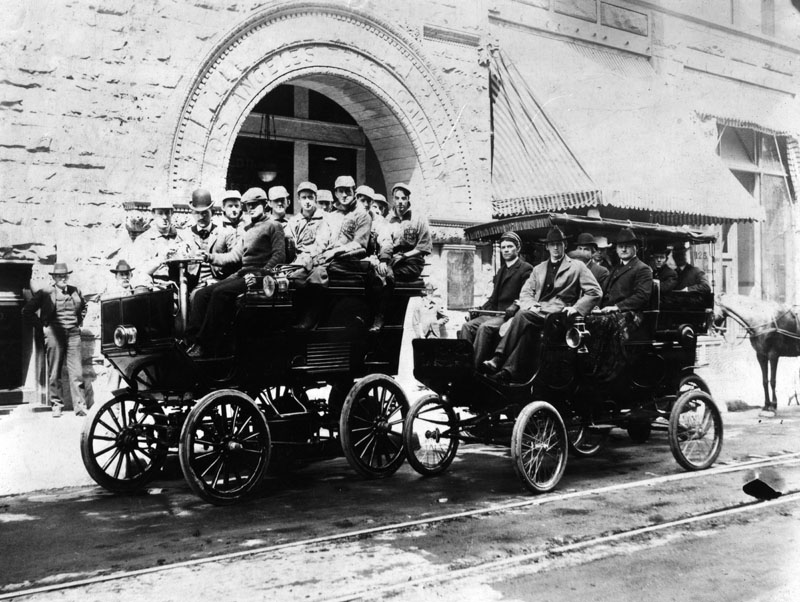 |
|
| (1902)* - Two unidentified vehicles used to transport a large number of people,"Sports" is the note on the photograph. From another copy of the subject the team is identified as the "Bank baseball team, Second Street and Spring Street, 1902." Los Angeles Trust Company, engraved in the arch of the doorway to the building in the background, may be the "Bank" referred to. |
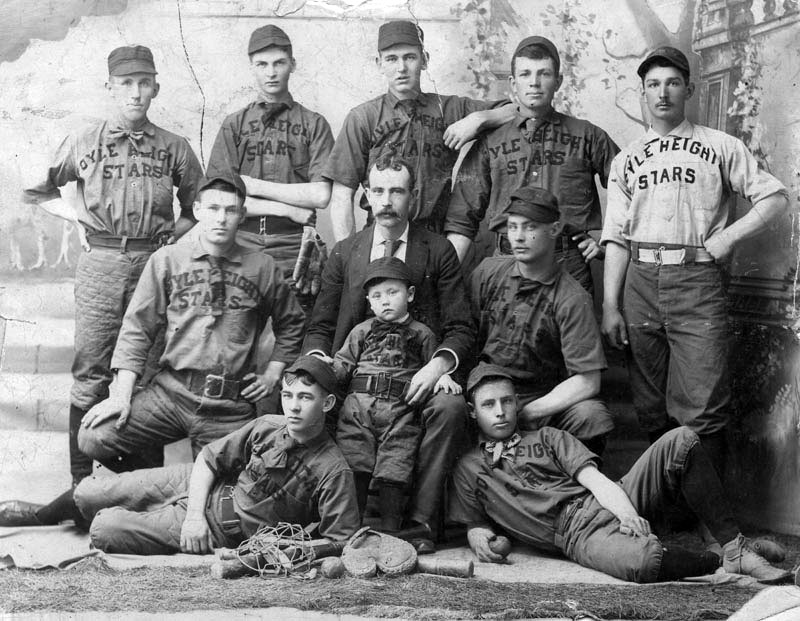 |
|
| (ca. 1905)* - Professional baseball came to Los Angeles in the early 1890s, with the Los Angeles Angels of the short-lived California League. But, at the turn of the 20th Century, neighborhood teams like the Boyle Height Stars flourished throughout Southern California. |
Historical Notes 1892 - The original Los Angeles Angels baseball team, playing with the four-team California League, plays through the 1893 for one season. 1893 - The California League Los Angeles Angels and the team from Stockton play a nighttime exhibition game - the first ever night professional baseball game on the Pacific Coast. The game is played at Athletic Park in Los Angeles. 1903 - Los Angeles joins the formation of the Pacific Coast League with the debut of the Los Angeles Angels baseball team. The team had no relationship to the team that played 1892-1893. The rival Pacific National League also debuts a team in Los Angeles, but it plays for barely a season. |
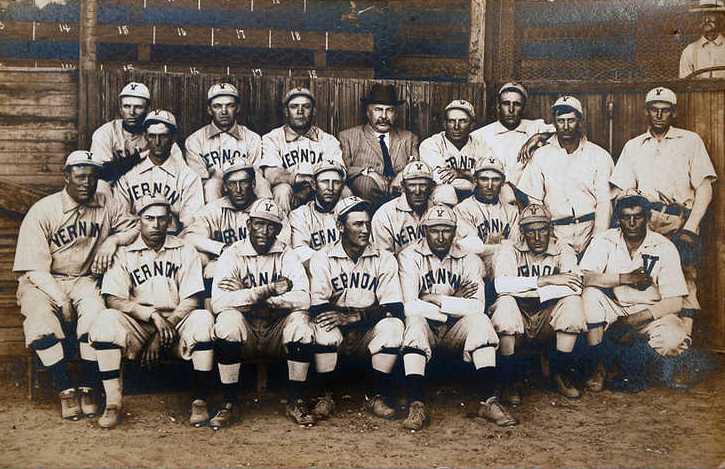 |
|
| (1910)^^ - Team picture of the Vernon Tigers in 1910 with owner Pete Maier seated in the back center. |
Historical Notes In 1909 Peter Maier, a meatpacker, built the first stadium, Maier Park, at 38th and Irving in the city of Vernon. The Vernon Tigers would play there until 1913 when they moved to Venice (Not coincidentally, both Venice and Vernon were the only two cities in the area where the sale of alcoholic beverages was legal). Weak attendance in Venice forced Maier to dismantle the entire stadium and move it back to Vernon in 1915. During their history the Tigers also played at Washington Park when the Angels were on the road. Doyle's Tavern was butted up to left field at Maier Park and it was rumored that there was a door in the left field wall where some players would run in to Doyle's for a quick beer between innings. It was also used for letting the crowd in and out of the park. The team was eventually purchased by Roscoe "Fatty" Arbuckle in 1919 who was a Hollywood movie star. Shortly thereafter the team had a scandal which was a lesser "Black Sox" type event that resulted in several player suspensions. In 1925 the franchise was sold to San Francisco investors who renamed the team the Mission Reds. The Reds moved back to LA in 1938 and morphed into the Hollywood Stars. |
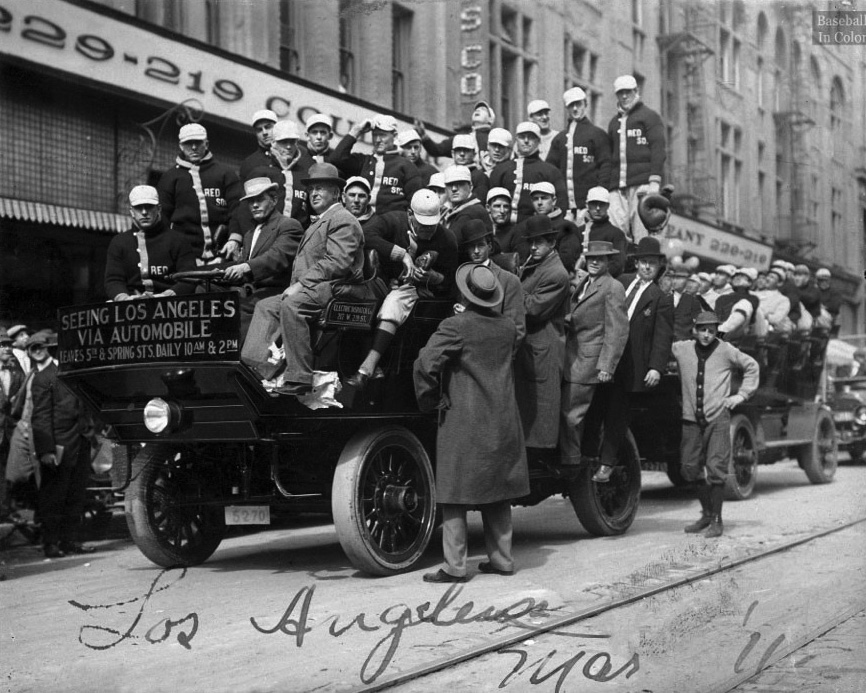 |
|
| (1911)* – View showing the Boston Red Sox in downtown Los Angeles. Sign on the vehicle reads: “Seeing Los Angeles via Automobile” |
Historical Notes The Boston Red Sox were in town on March 9th, 1911 to play the Vernon Tigers at Washington Park – if the weather permitted. Note that several of the players are looking up to the sky at, possibly, rain clouds. A Los Angeles Times article dated Mar 9, 1911 with the title ‘Ball Game If Weather Permits’, read as follows: "The Boston Red Sox and the Vernon team are scheduled to play a game this afternoon at the new Washington Park if— Hap Hogan said last night that “if” meant two things: That the game would be at the Washington Park if “It” did not rain all night and if the ground was not too soft; and if not at the Washington street ground it would be at the Vernon Park, if there was not too much rain. With this beautifully lucid and clear statement everyone should know as much as any one about “weather” there will be a ball game this afternoon. Dillon called off the San Bernardino game last night." |
Chutes Park (aka Washington Park)
 |
|
| (ca. 1911)^^* - Panoramic view of the Chutes Park (also known as Washington Park). It was located on the north end of Chutes Park on Washington Blvd. and Main Street. This was the first home of the Los Angeles Angels. The Chutes Park water slide is visible beyond right field. Click HERE to see more on Chutes Park. |
Historical Notes In 1900, a baseball diamond was completed on the northern end of the Chutes Park, with a team to play in the new California League. It would be the first team to be called the Los Angeles Angels. It was also home of the Vernon Tigers. Following games, a gate in the center field fence was opened and fans were allowed to enter the theme park. |
.jpg) |
|
| (ca. 1911)^ - Panoramic view of Chutes Park baseball field as seen from right field. |
Historical Notes Chutes Park was replaced by Washington Park in 1912, which had been built nearby just two blocks away at Washington and Hill Streets. The Chutes / Washington area was abandoned entirely when the Angels moved to Wrigley Field at 42nd Street and Avalon Boulevard. The Chutes Park baseball field has also been referred to as Washington Park.*^ |
* * * * * |
Washington Park
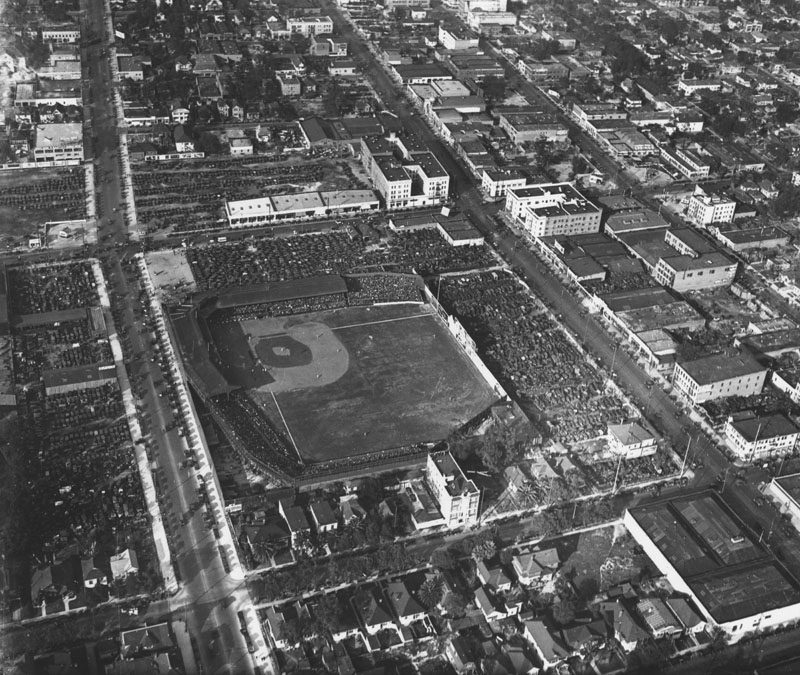 |
|
| (1924)^* - Aerial view of the 'New' Washington Park which was home to the Los Angeles Angels from 1912 until they moved to Wrigley Field in 1925; The Vernon Tigers, who in 1938 would become the Hollywood Stars, also played at Washington Park but only when the Angels were away. |
Historical Notes The Venice PCL entry of 1913-14 also played its home games at Washington Park, except for Sunday morning and special holiday games. In 1915, they would move back to Vernon and once again become the Vernon Tigers. A football game between USC and California was played at Washington Park on November 25, 1915. It drew 8,000 spectators, the largest crowd to have seen a football game in southern California at that time. |
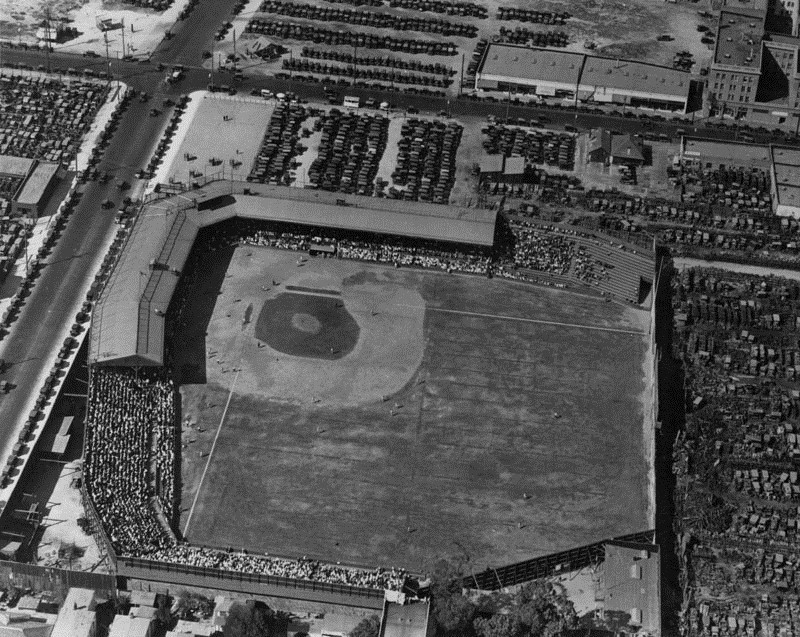 |
|
| (1924)* - Aerial view of Washington Park, home of the Los Angeles Angels. Hill Street is on the left and Washington Boulevard is at top. |
Historical Notes From 1903 through 1957, the Los Angeles Angels were one of the mainstays of the Pacific Coast League, winning the PCL pennant 12 times. The Angels, along with the Portland Beavers, Oakland Oaks, Sacramento Solons, San Francisco Seals, and Seattle Indians were charter members of the Pacific Coast League which was founded in 1903. |
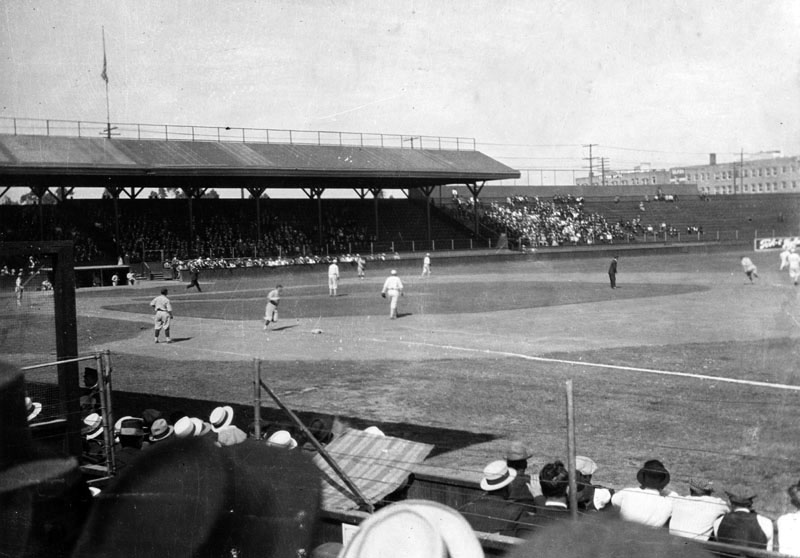 |
|
| (1917)* - View of a game at Washington Park. It is unknown which team is the batting team, and which is the fielding team, but it may be either the Los Angeles Angels or the other home team, the Hollywood Stars. |
Historical Notes In 1921, the team was purchased by chewing-gum magnate William Wrigley Jr., the owner of the Chicago Cubs of the National League. When Wrigley could not get the city of Los Angeles to make the improvements to Washington Park he requested, he began construction of his own 21,000-seat stadium, appropriately named Wrigley Field, at 42nd Place and Avalon Boulevard in what is now known as South Central Los Angeles. The Angels began play at Wrigley in 1926, and responded by winning their eighth PCL pennant, finishing 10½ games ahead of the second-place Oakland Oaks.*^ Washington Park was eventually demolished in the Mid-1950s. |
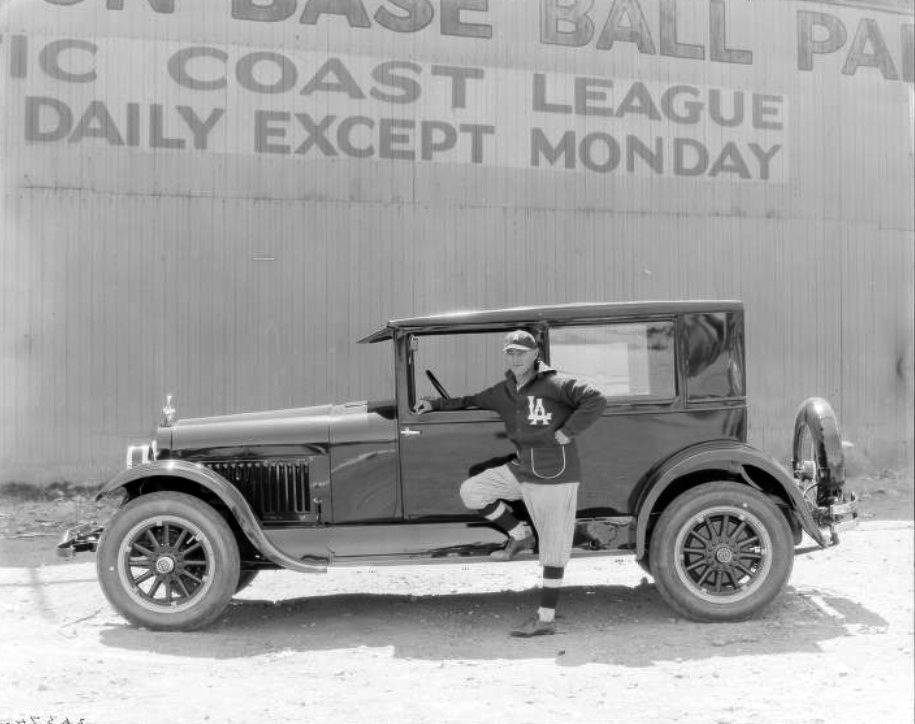 |
|
| (1925)* – View showing Charlie Root posing in front of a Hudson Coach at Washington Park. |
Historical Notes Charlie, a Chicago Cubs pitcher made famous by the apocryphal story of Babe Ruth calling his shot by pointing to the center field bleachers with Root on the mound, is seen here in his last year in the minor leagues with the Los Angeles Angels (the triple-A Cubs affiliate). The car may have been his but the photograph was commissioned by Walter M. Murphy Motors Company for an advertising shot. This is the last year the Angels will play at Washington Park moving into their own Wrigley Field, at 42nd Pl and Avalon, next season. |
* * * * * |
White Sox Ball Park (Los Angeles)
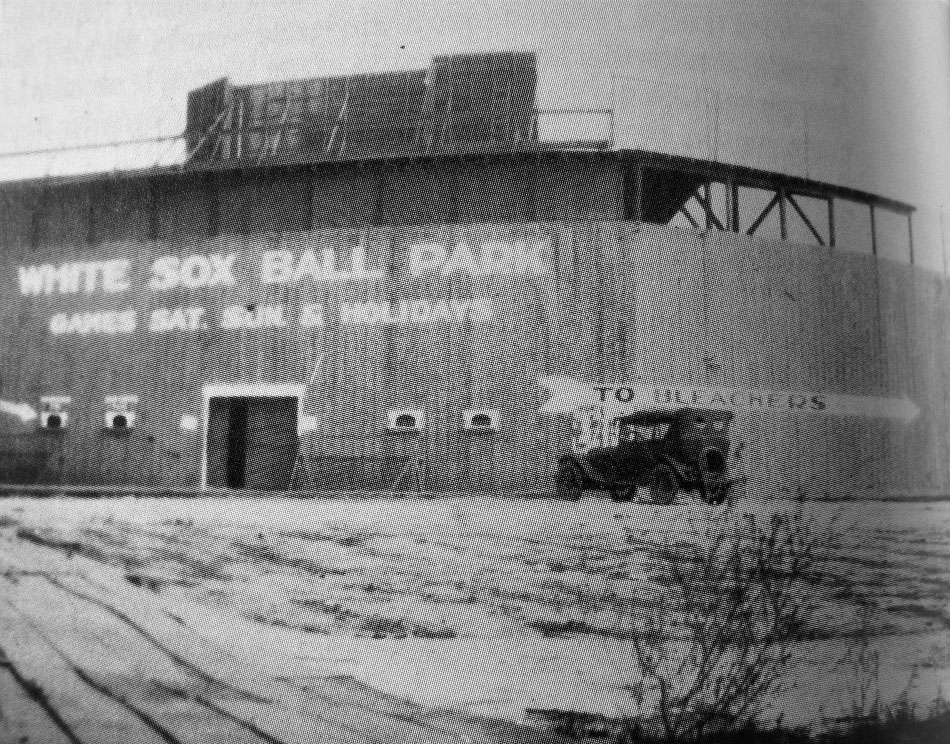 |
|
| (ca. 1924)* – View showing White Sox Ball Park, located on the corner of 38th Street and Compton Avenue in South Los Angeles. The 7,000 seat park was the home of the California Winter League. Sign reads: "Games Saturday, Sunday, & Holidays" |
Historical Notes Italian American brothers, John and Joe Pirrone, used their earnings from their wholesale fruit business to purchase the land to build White Sox Park in 1924. Joe Pirrone organized the California Winter League to lure Negro League teams to southern California to play against local semi-pro teams and minor league teams, including Japanese American and Mexican American teams. During the 1920s African Americans were barred from playing in Pacific Coast League parks including Wrigley Field and Gilmore Field in Los Angeles. According to William McNeil, “The California Winter League was apparently intended as a showcase for Negro league baseball. White Sox Park, which was strategically located in or near black sections of the city, hosted the majority of league games.” Some of these teams included the Kansas City Royals and Monarchs, Philadelphia Giants, Detroit Giants and Nashville Royal Giants. There were also all-black teams from the sandlots of Los Angeles, such as the Royal Giants, Colored Giants, Monarchs, Stars and many others.* |
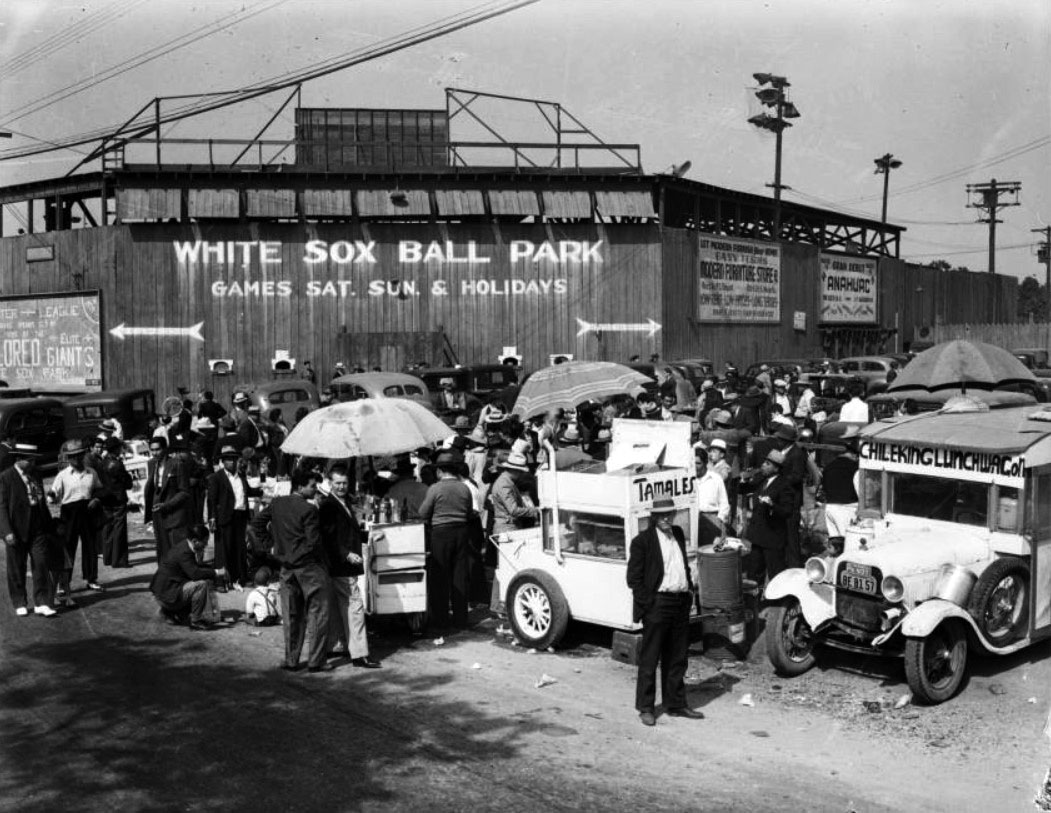 |
|
| (ca. 1939)^ – View showing customers and vendors outside the White Sox Baseball Park in South Los Angeles. Sign on the stadium says "Winter League grand opening Oct. 9th.1939. Home of the Colored Elite Giants, White Sox Park." |
Historical Notes IWhite Sox Park was also the home of Mexican American baseball teams. Mexican American baseball teams and leagues dotted the southern California landscape “working to play, playing to work.” El Paso Shoe Store from San Gabriel fielded one of the strongest teams called, “Los Zapateros,” that played a majority of its games in White Sox Park. Hollywood celebrities, city political figures and the Mexican Consul attended games at White Sox Park.* |
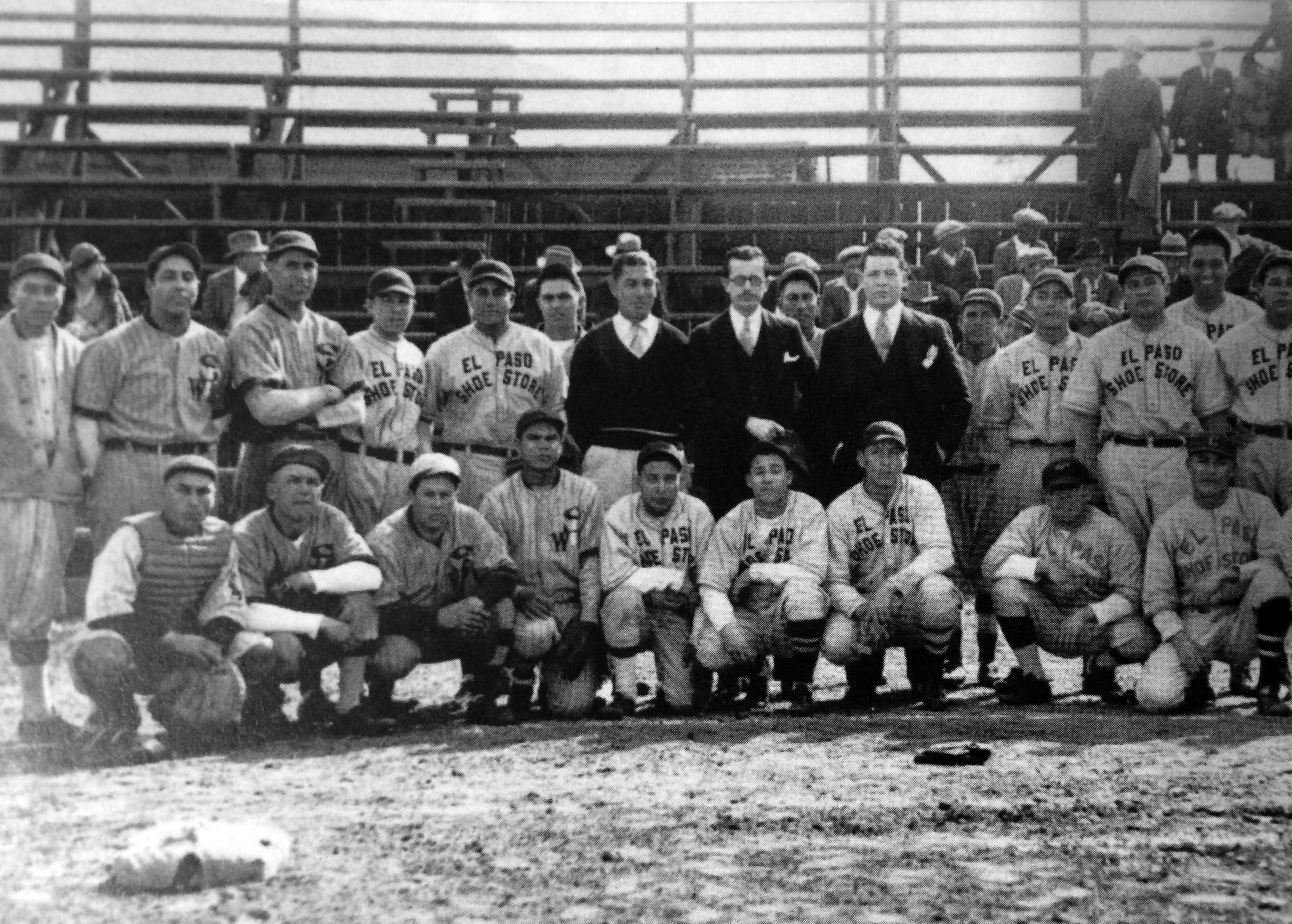 |
|
| (ca. 1930s)* – View showing the Los Zapateros team who played most of their games at White Sox Ball Park. The team sponsor's name is seen on the uniforms - El Paso Shoe Store. |
Historical Notes The Los Zapateros team was owned and managed by Don Rodrigo Castillo, who founded El Paso Shoe Store when he moved to Los Angeles from El Paso. Throughout the 1930s baseball teams from Mexico were invited to play against local Mexican American teams. Los Zapateros also played matches against the Los Angeles Nippons, a nisei baseball team. By the early 1940s the ballpark fell into disrepair and was demolished at the end of World War II to make way for veteran housing project and the Ross Snyder Recreation Center.* |
* * * * * |
Brookside Park (Pasadena)
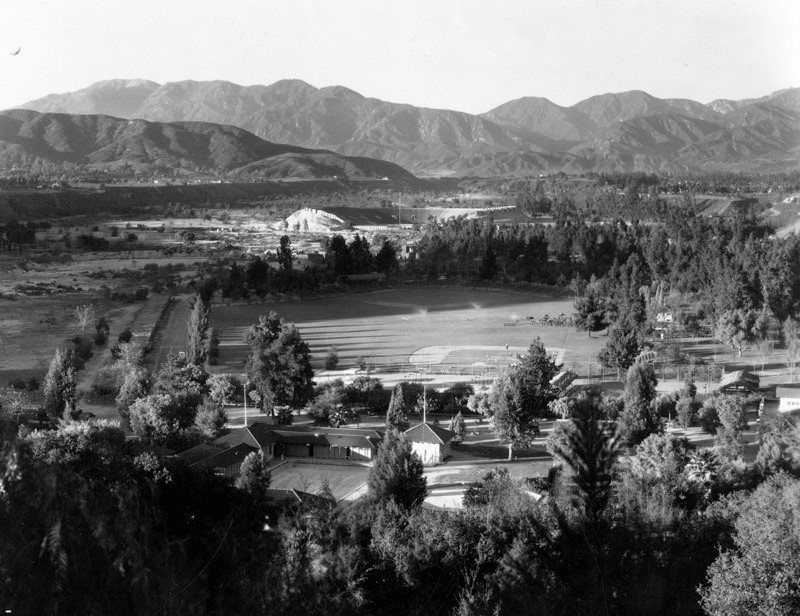 |
|
| (ca. 1930s)* - View showing the Brookside Park baseball field used by the Chicago White Sox during Spring Training. The Rose Bowl can be seen in the background. |
Historical Notes From 1933 to 1942 and from 1946 to 1950, the Chicago White Sox held their spring training in Brookside Park.^^ |
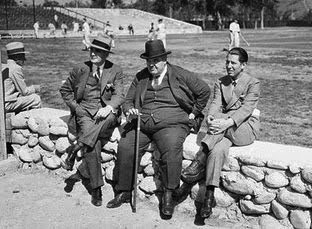 |
(1935)^^ - Joseph Barry, J. Louis Comiskey, William Wrigley Jr., and Harry Grabiner sit on an arroyo stone wall at Brookside Park while the Chicago White Sox play a baseball game during spring training. |
Historical Notes William Wrigley Jr. owned the Chicago Cubs and the team had its annual spring training on Catalina Island, which he owned. Joseph Barry was the White Sox traveling secretary, J. Louis Comiskey was owner and president of the White Sox organization and Harry Grabiner was vice president..^^ |
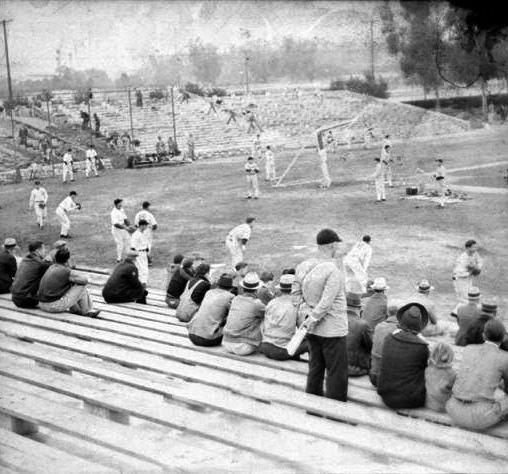 |
(1938)^^- Fans watch from bleachers at Brookside Park as the Chicago White Sox practice during Spring Training. | |
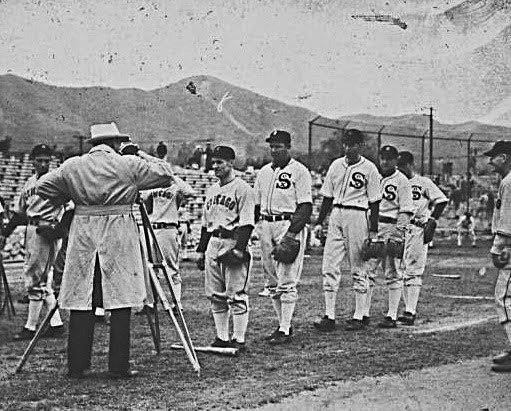 |
(1938)^^ - Chicago White Sox players line up in front of a movie camera for a newsreel that would be shown in theaters. (Brookside Park, Pasadena) |
|
* * * * * |
Wrigley Field (Catalina Island)
 |
|
| (1920s)* – Chicago Cubs at Spring Training at 1000 Avalon Canyon Road, Avalon,, Catalina Island. |
Historical Notes William Wrigley Jr., the owner of the Chicago Cubs and the Wrigley Company, purchased a controlling interest in the Cubs in 1916 and subsequently bought Catalina Island in 1919. His vision was to transform the island into a premier tourist destination and a unique spring training location for his baseball team. |
 |
|
| (1920s)* - Spring training baseball action at the Chicago Cubs’ Wrigley Field facility on Catalina Island. |
Historical Notes The Cubs began their spring training on Catalina Island in 1921, continuing this tradition until 1951, with a hiatus during World War II (1942-1945). The training camp was set up in Avalon, the island's main town, where a field and clubhouse were constructed. When the Chicago Cubs began spring training on Catalina Island in 1921, they practiced at Avalon Ball Park. This field served as their training site until Wrigley Field on Catalina Island was established in the late 1920s. The field on Catalina Island was colloquially called Wrigley Field by the Chicago Cubs players and fans before it was officially named Wrigley Field. The Catalina Island Wrigley Field was named after the Los Angeles Wrigley Field, which had been named in 1925. This naming occurred before the Chicago Wrigley Field received its current name in 1927. The field's association with the Wrigley family, who owned both the Cubs and significant property on Catalina Island, led to the informal use of the name prior to its official designation in the late 1920s. |
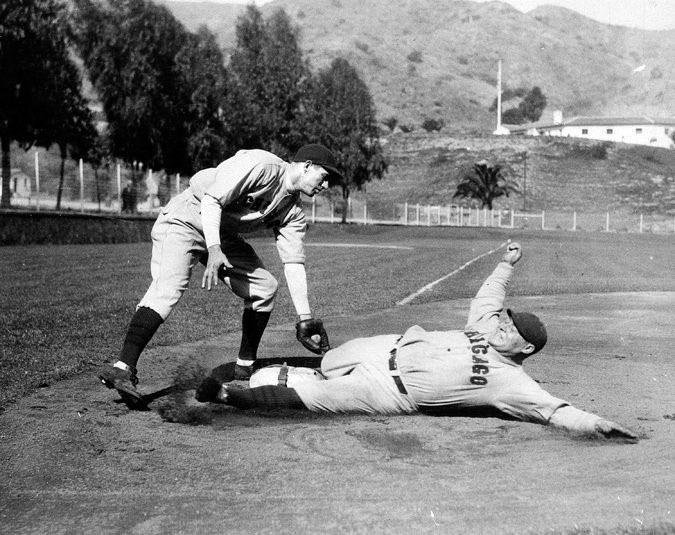 |
|
| (1929)* - Cubs outfielder Hack Wilson showed the team’s new third baseman, Footsie Blair, how to steal a base at Catalina Island. |
Historical Notes The Cubs were treated like royalty on the island, greeted with a parade each spring, fed at the ornate Hotel St. Catherine, and able to cavort with actresses like Betty Grable, Grace Bradley and Rochelle Hudson. They stayed at the Hotel St. Catherine in Descanso Bay and played on a ballfield built in Avalon Canyon that was named Wrigley Field. |
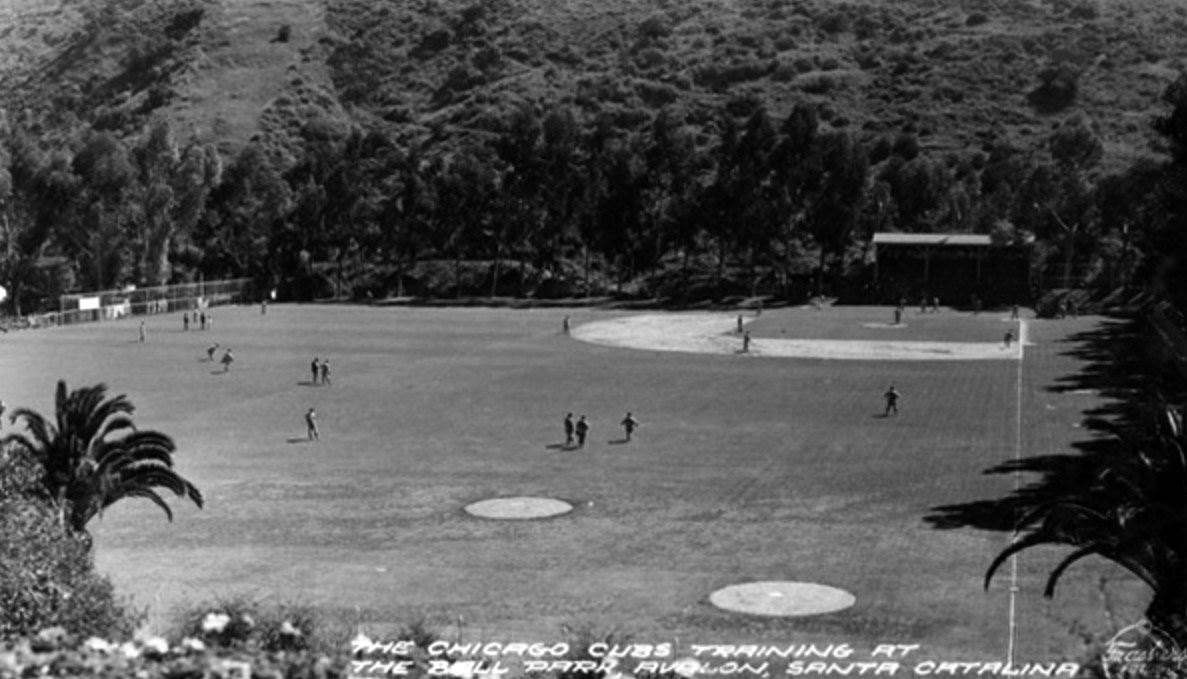 |
|
| (1940)* - Postcard view showing the Chicago Cubs baseball team training at the Ball Park also called Wrigley Field in Avalon, Santa Catalina. |
Historical Notes Players stayed at the Hotel St. Catherine in Descanso Bay and played on a ballfield built in Avalon Canyon. The Cubs continued to use the island for spring training until 1951, except during the war years of 1942–45. |
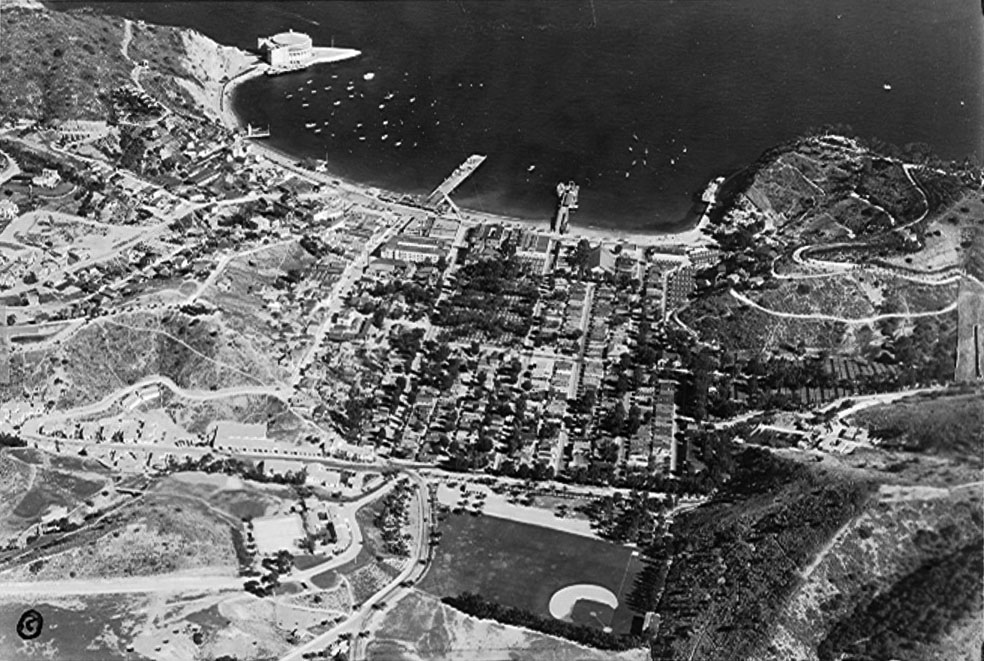 |
|
| (1930s)* – Aerial view showing the town of Avalon. Wrigley’s Chicago Cubs spring training field (Wrigley Field) is seen in the foreground. |
Historical Notes Today, only a plaque noting the location of "Wrigley Field" remains on the grounds of what is currently the Catalina Island Country Club, though its clubhouse is the same structure that Wrigley built for the Cubs. Click HERE to see more Early Views of Catalina. |
* * * * * |
Wrigley Field (Los Angeles)
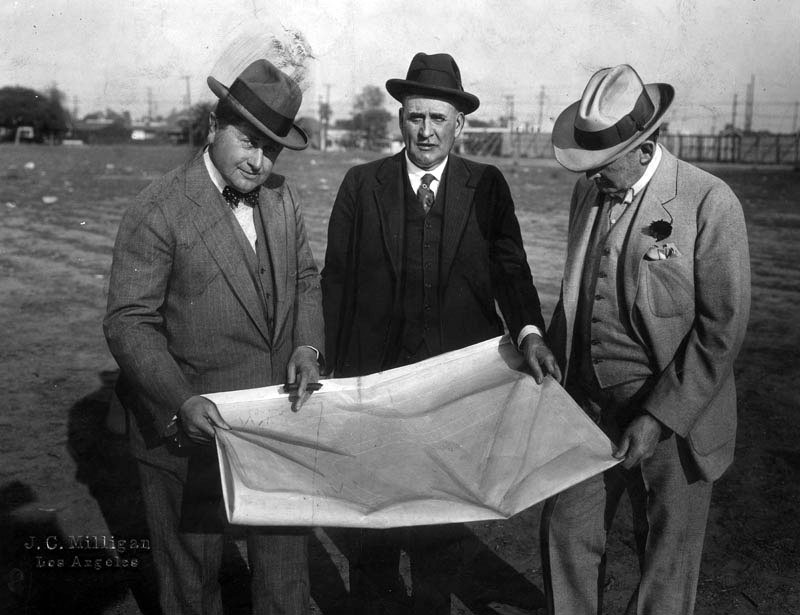 |
|
| (1924)* - William Wrigley Jr. (left) and partners look over blue prints for Wrigley Field. |
Historical Notes Wrigley Field was built in South Los Angeles in 1925 and was named after William Wrigley Jr., the chewing gum magnate who owned the first tenants, the original Los Angeles Angels Pacific Coast League team. In 1925, the Angels moved from their former home at Washington Park (Los Angeles), which was also known as Chutes Park. Wrigley also owned the Chicago Cubs, whose home (Wrigley Field) is also named after him. Chewing-gum magnate William Wrigley Jr. bought the Angels in 1921 as a farm team for his Chicago Cubs for the (then) astronomical sum of $150,000 and then built a stadium for the team a few years later. Construction for Wrigley Field began in 1924 and the stadium opened in 1925. |
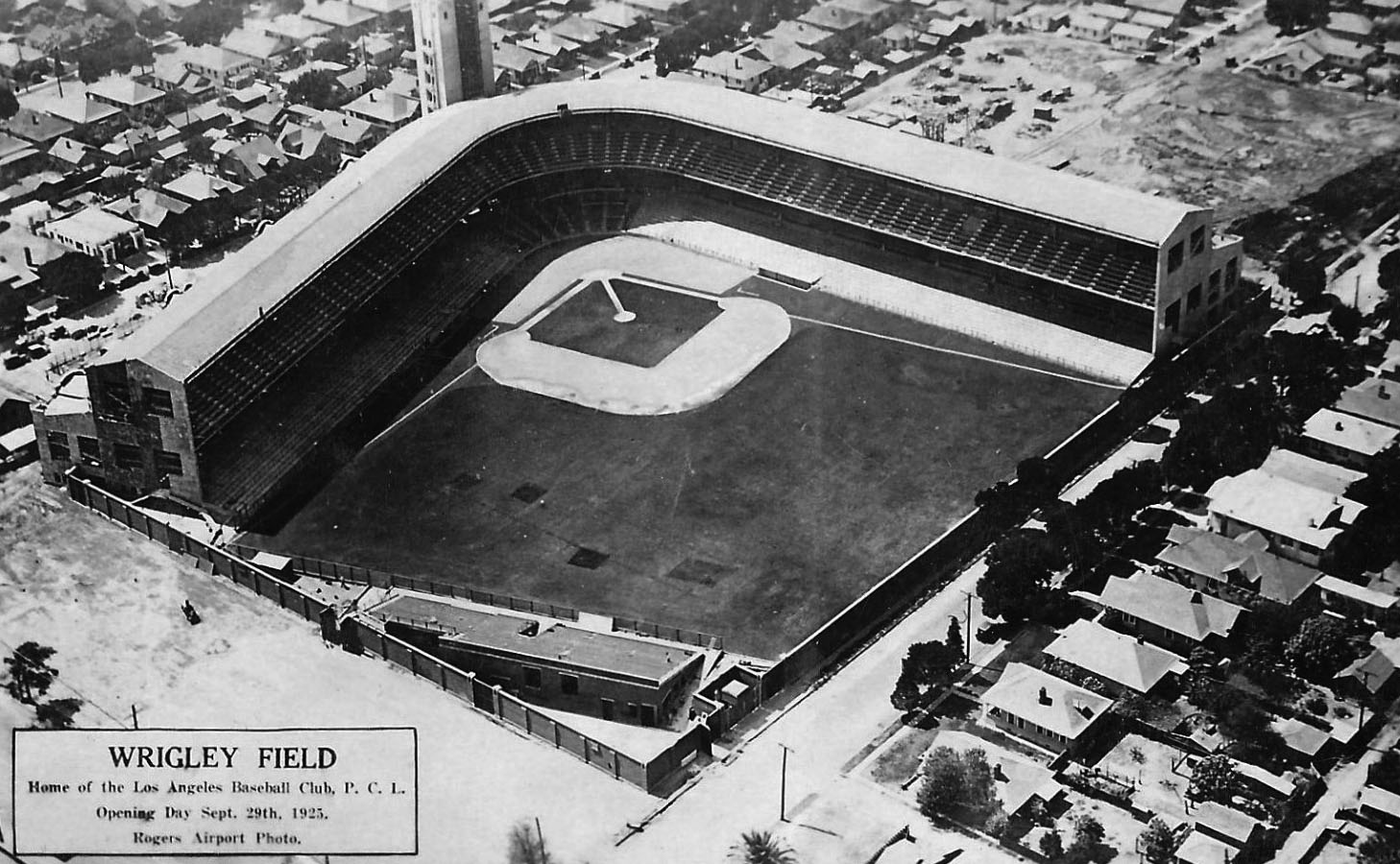 |
|
| (1925)* - View of Wrigley Field on opening day, September 29, 1925, as seen before the stadium was filled. |
Historical Notes For 33 seasons (1925-1957) Wrigley Field was home to the Angels, and for 11 of those seasons (1926-1935 and 1938) it had a second home team in the rival Hollywood Stars. The Stars eventually moved to their own new ballpark, Gilmore Field. Prior to 1925, the Angels played at their former home at Washington Park, and before that, at Chutes Park. |
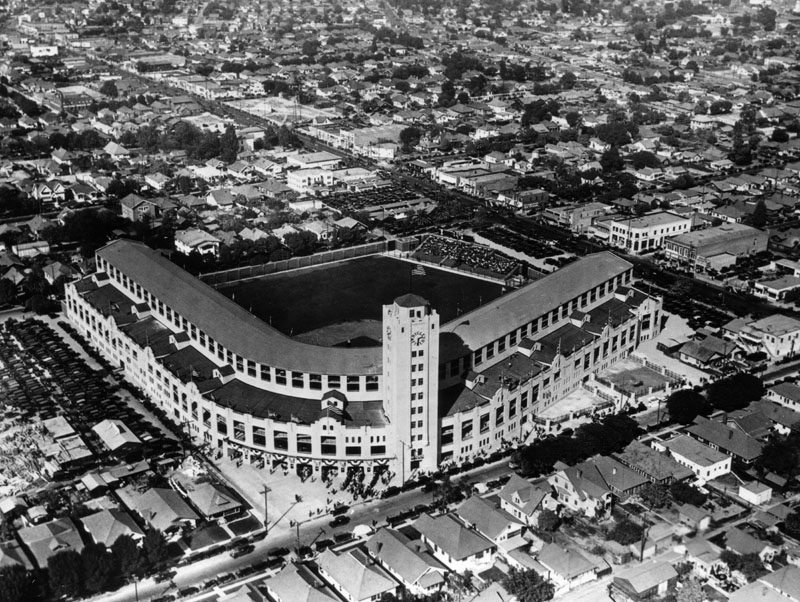 |
|
| (1925)* - Aerial view of Wrigley Field, Opening Day, September 29, 1925. |
Historical Notes The Los Angeles Wrigley Field was built to resemble Spanish-style architecture and a somewhat scaled-down version of the Chicago ballpark (known then as Cubs Park) as it looked at the time. It was also the first of the two ballparks to bear Wrigley's name, as the Chicago park was named for Wrigley over a year after the L.A. park's opening. At the time, he owned Santa Catalina Island, and the Cubs were holding their spring training in that island's city of Avalon (whose ballfield was located on Avalon Canyon Road and also informally known as "Wrigley Field"). Coincidentally, one of Wrigley Field's boundary streets was Avalon Boulevard (east, behind right field and a small parking lot). The other boundaries of the block were 41st Street (north, behind left field), 42nd Place (south, behind first base), and San Pedro Street (west, behind third base and a larger parking lot). Not only did L.A. Wrigley get its name first, it had more on-site parking than the Chicago version did (or does now). |
 |
|
| (1925)^ - Opening day, Wrigley Field, 42nd Place and Avalon Blvd., Los Angeles, CA, 9/29/1925. |
Historical Notes The inaugural game was won by the Los Angeles Angels defeating San Francisco Seals, 10-8, before 18,000 fans. |
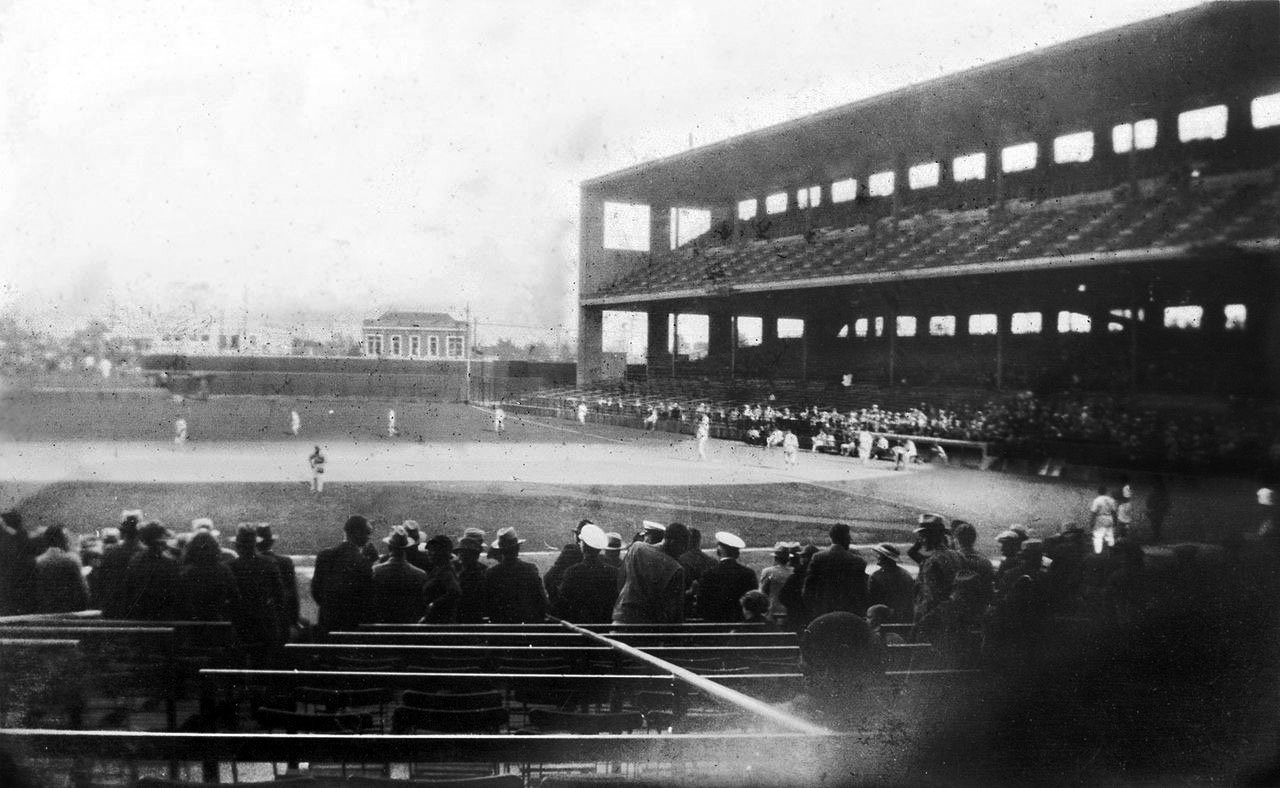 |
|
| (1930s)* – View of Wrigley Field looking toward the right field stands as seen from the box seats behind 3rd base line. Photo by Lee Minor (1914–2009) |
Historical Notes Erected in 1925 at 42nd Place and Avalon Blvd., Wrigley Field was a 21,000-seat, home-run hitters paradise. It also doubled as the set for such films as "Pride of the Yankees", "Dam Yankees" and "Alibi Ike" and the "Home Run Derby" television show. |
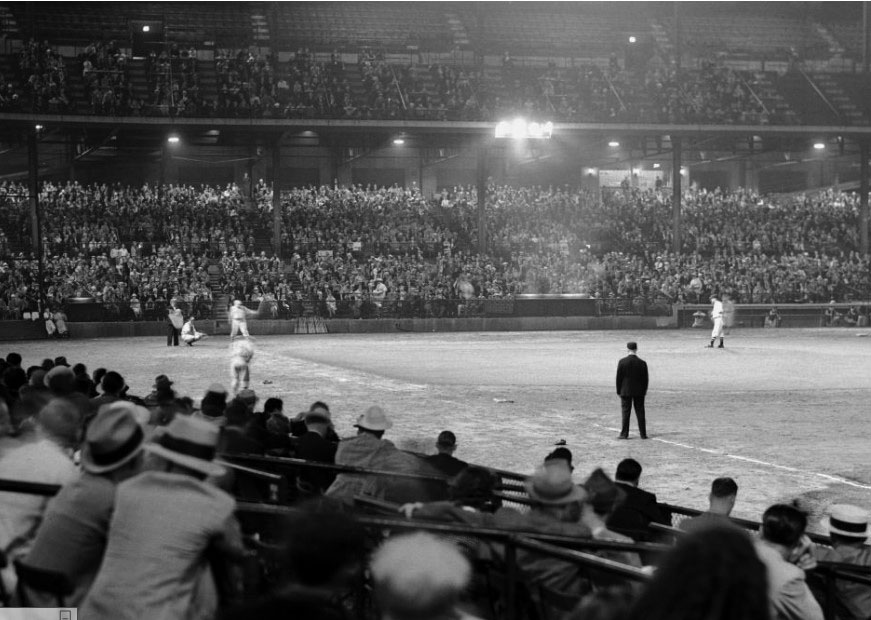 |
|
| (ca. 1930)* - Crowd watching a baseball game at Wrigley Field in South Los Angeles. Home of the Los Angeles Angels from 1925 to 1957. Also home of the Hollywood Stars from 1926-1935 and 1938. |
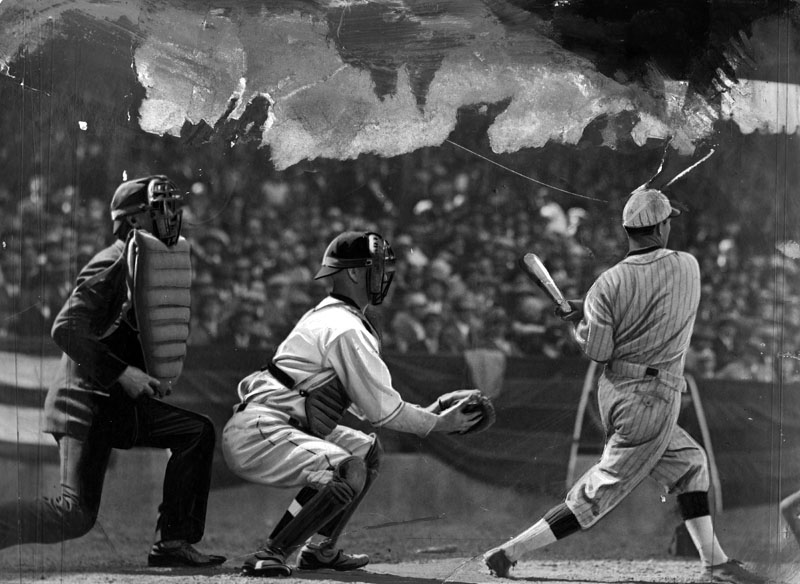 |
|
| (1930)* - The pennant chase is on. The Pacific Coast League gets down to serious business as Angels play at Wrigley Field. Photo dated: April 9, 1930. |
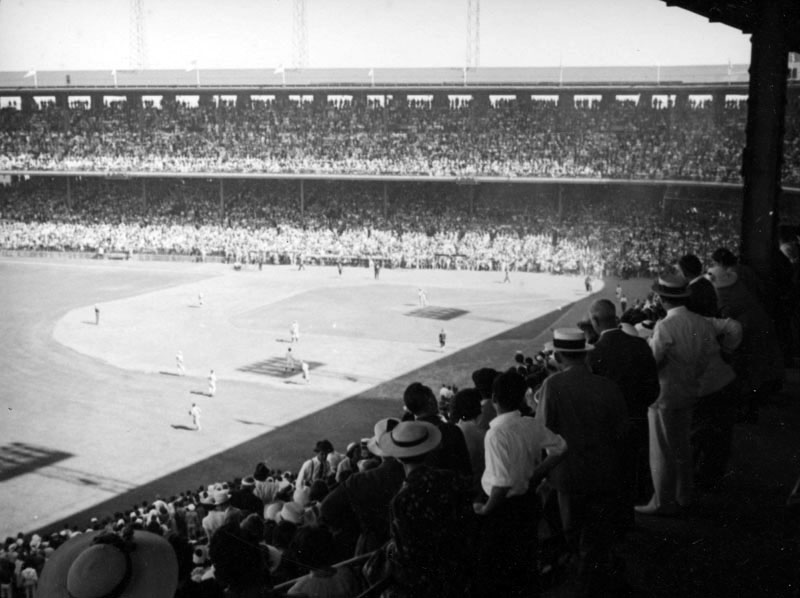 |
|
| (Early 1930s)* - Partial view of the "first" Wrigley Field - home for the Los Angeles Angels of the Pacific Coast League. The bleachers are practically bursting at the seams with eager spectators cheering on their favorite teams. |
Historical Notes Los Angeles was the first city to have a ballpark named Wrigley Field. The Los Angeles ballpark opened in 1925 with the name Wrigley Field, while the Chicago ballpark, originally named Weeghman Park, was renamed Wrigley Field in 1927. |
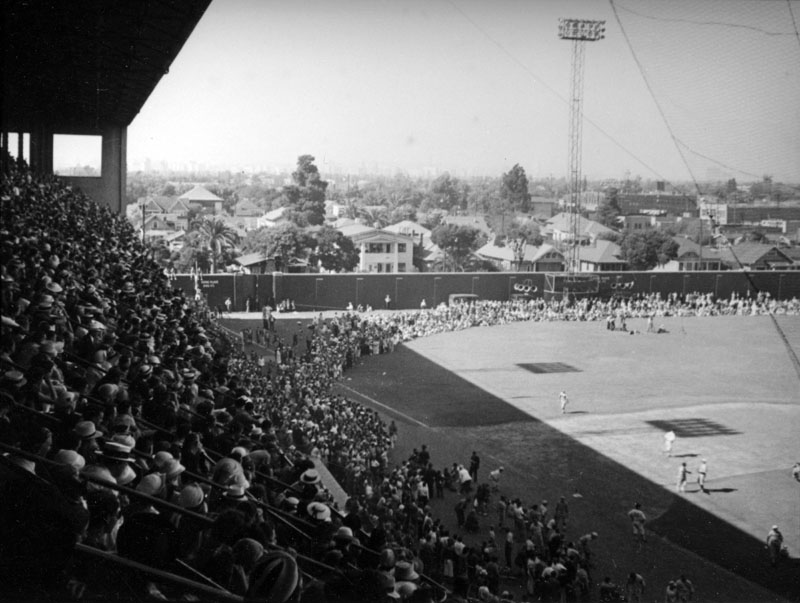 |
|
| (Early 1930s)* - The "first" Wrigley Field. The double-decked grandstand extended from the left field foul pole to home plate, and around to the right field foul pole. Bleachers and a scoreboard were located in right field. There was no seating in left field, just a 15-foot-high concrete wall (seen here), though it offered little to no protection for the houses located directly behind it, as they were constantly getting pelted with flying homeruns. The left field concrete wall was later covered in ivy as was its big "brother" Wrigley Field in Chicago. |
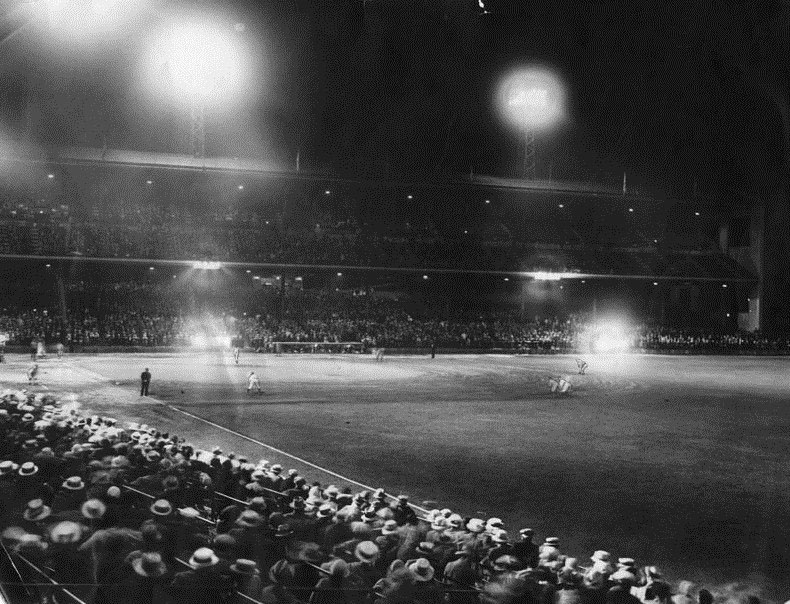 |
|
| (1930)* - The first night game in Los Angeles, at Wrigley Field. Chicago's Wrigley Field wouldn't get lights until 1988. Photo dated: July 22, 1930. |
Historical Notes The first night baseball game in Los Angeles took place at Wrigley Field on July 22, 1930, when the Los Angeles Angels defeated the Sacramento Senators 5–4 in 11 innings before a crowd of 17,000. This historic Pacific Coast League game marked one of the earliest uses of stadium lighting in professional baseball. A little-known fact: Chicago’s Wrigley Field, the more famous namesake, didn’t host its first official night game until August 9, 1988—making it one of the last Major League ballparks to add lights. |
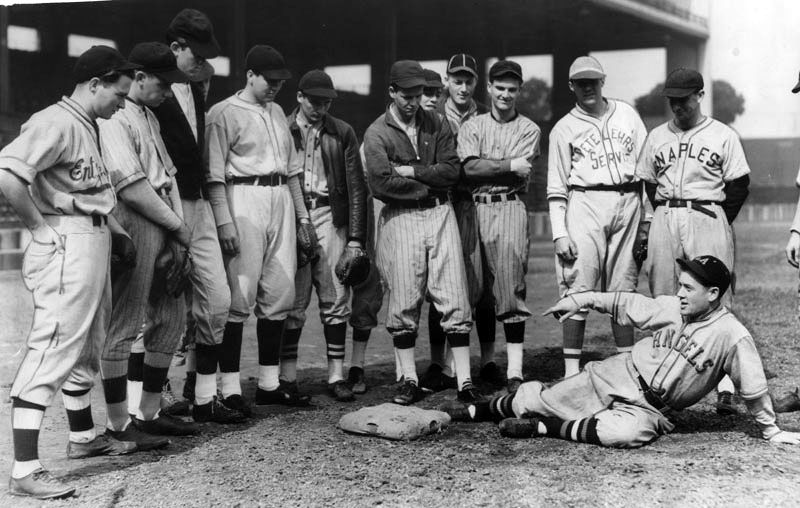 |
|
| (ca. 1935)* - The Angels won 14 PCL pennants, but their best team was the 1934 powerhouse (137-50), led by Triple Crown winner Frank Demaree and Arnold "Jigger" Statz (demonstrating sliding technique). Dubbed the "Greatest Angel of Them All," Statz was an excellent defensive centerfielder who cut a hole in the palm of his mitt to get a better feel for the ball. Statz played 18 seasons in L.A. and owns most of the PCL records (including games played, hits, and runs). Spanning his entire pro career, Statz compiled the most at-bats in baseball history. |
 |
|
| (ca. 1935)* - Fay Thomas (left, with Ray Prim), the ace of the Angels staff in 1934 with a 28-4 record. A USC grad who played collegiate football with actor John Wayne, Thomas played Christy Mathewson in "Pride of the Yankees." |
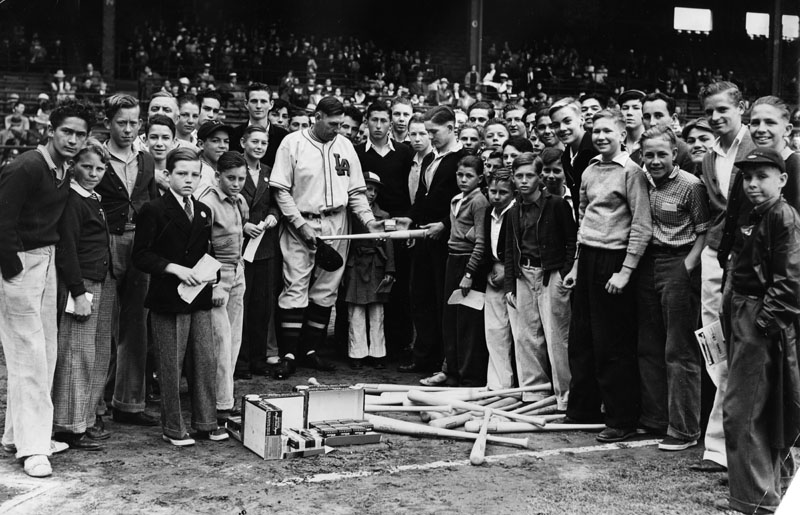 |
|
| (1937)* - Clustered around "Truck" Hannah, manager of the Los Angeles Angels, are a group of 50 excited youngsters who ran off with the prizes in the technical baseball contest, ready to receive their rewards from the Angel pilot. |
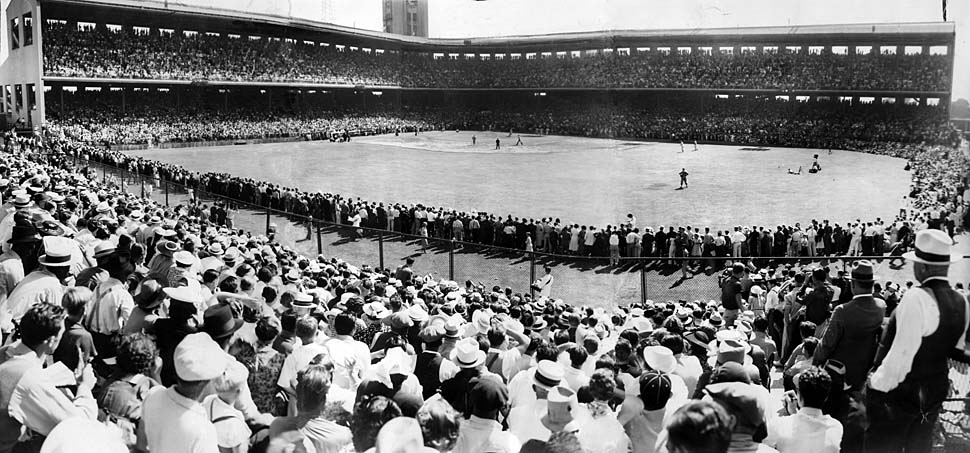 |
|
| (1937)*^^ - More than 30,000 fans crowd the 22,000-seat Wrigley Field for a celebrity charity baseball game for Mt. Sinai Hospital. LA Times photo date: July 17, 1937. |
Historical Notes The Los Angeles Times caption reported the next day that “The overflow crowd was stationed in the outfield but no ground rules were necessary as none of the contestants was able to wallop the ball that far…” |
.jpg) |
|
| (1937)* - On July 17, 1937 two dozen celebrities played a baseball game for charity called the "second annual motion picture baseball game, comedians vs. leading men" at Wrigley Field. For the dramatic team Robert Taylor captained a team that included: Tyrone Power, Spencer Tracy, Clark Gable, Ray Miland, and Boris Karloff among others. The comedy team captained by Joe E. Brown included the Ritz brothers, Edie Cantor, Buster Keaton and Burns and Allen among others. This view of the game includes the stands, a film crew set up behind home plate, and a little bit of the diamond. |
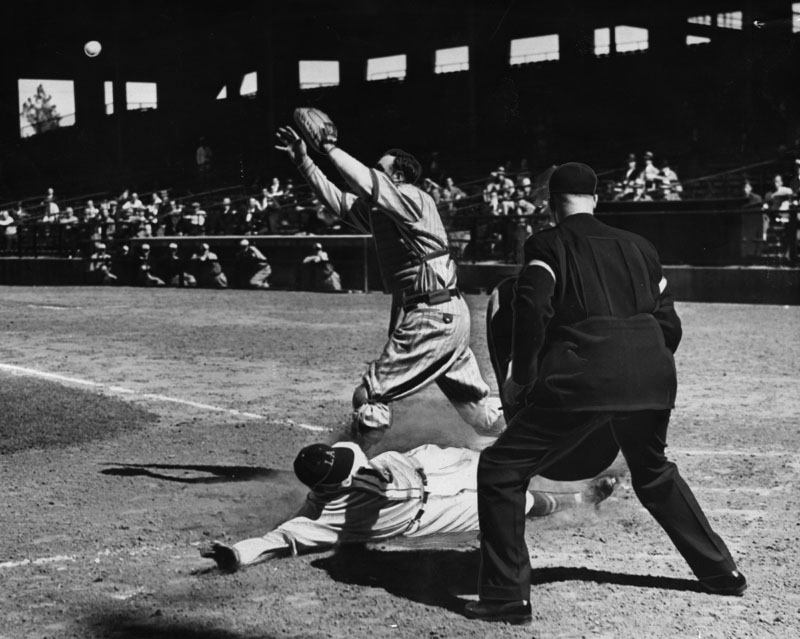 |
|
| (1937)* - "Jigger" Statz slid safely home on an infield hit by Carl Dittmar in the first inning of yesterday's ball game at Wrigley Field, and here the camera catches a wild throw from McDonald to Catcher Wilson of the Portland club. McWilliams also came home on the wild throw. But the Portland Beavers rallied to win the game in the later stages, so the effort went for naught. |
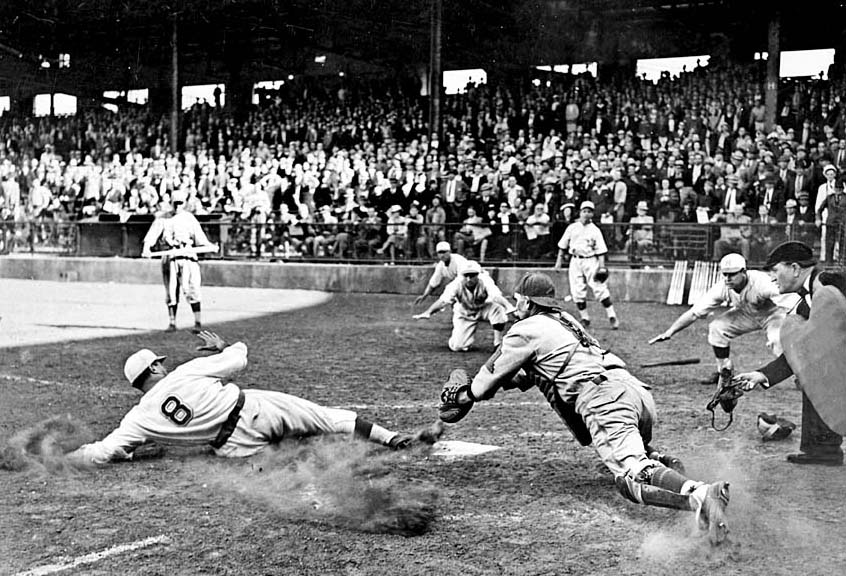 |
|
| (1938)*^^ - Frenchy Uhalt, Hollyood Stars leftfielder, had plenty of moral support as he slid across plate in ninth inning with run that beat the San Francisco Seals, 4-3, in the double hitter opener at Wrigley Field yesterday. Uhalt scored from second on Tom Carey's single, barely beating Brooks Holder's throw to catcher Larry]Woodall, shown diving as Frenchy's toe flicks a corner of the plate. Note [Chink] Outen, [Fern] Bell and [Bill] Norman, Stars in background, making the "safe" signal. The umpire is Henry Fanning. |
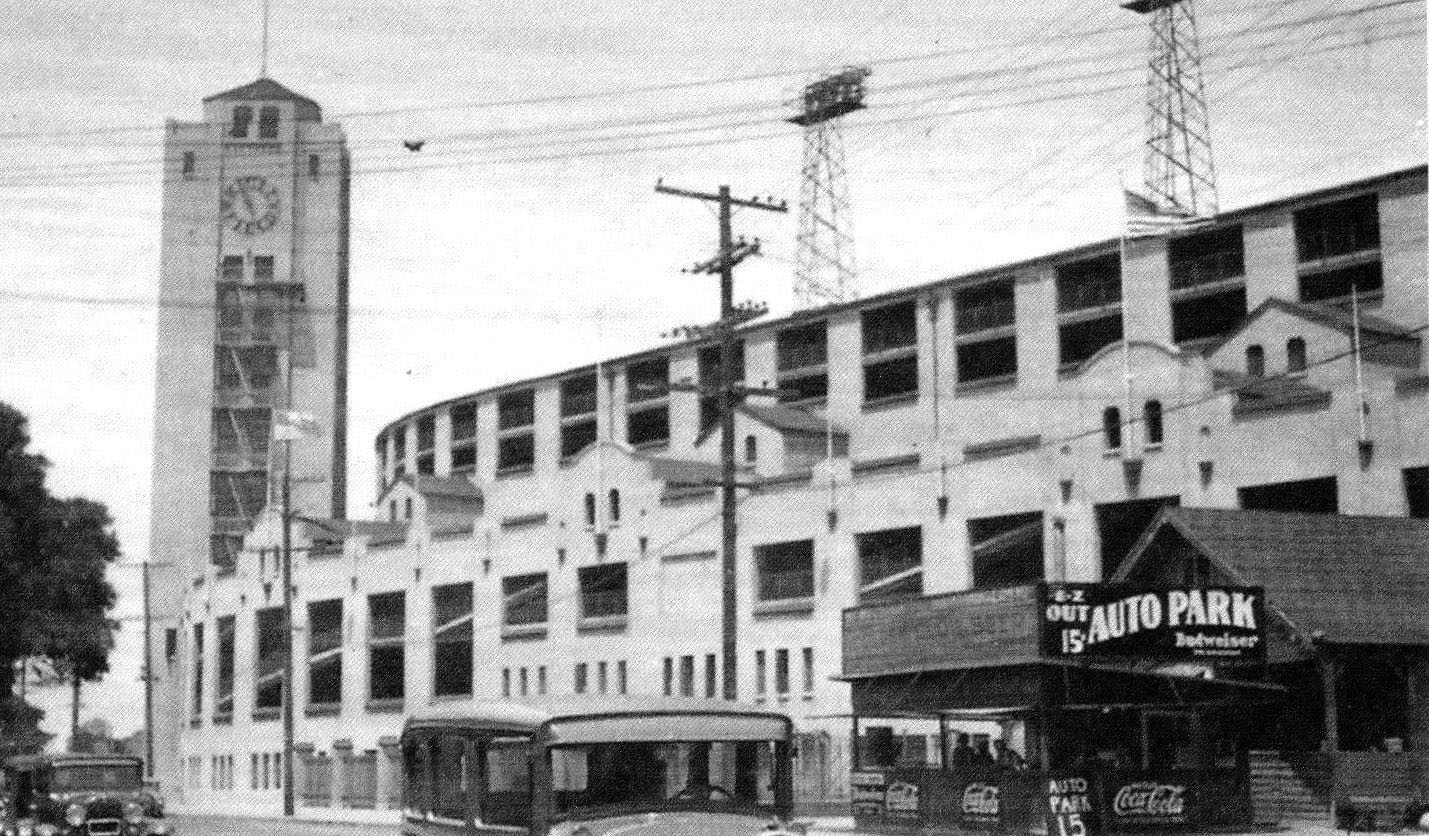 |
|
| (1930s)* – Exterior view of Wrigley Field with its multi-story clock tower on the left. A concession stand is seen in the foreground with large sign reading: Auto Park 15¢ |
Historical Notes Wrigley Field in Los Angeles was conceived in 1921 when William Wrigley Jr., owner of the Chicago Cubs, purchased the Los Angeles Angels of the Pacific Coast League and decided to build a new ballpark to replace Washington Park. Designed by Zachary Taylor Davis, the stadium featured a double-decked grandstand, a Spanish-style exterior, and a distinctive clock tower, opening on September 29, 1925, with a seating capacity of around 21,000. It served as home to the Los Angeles Angels and Hollywood Stars until the Angels moved to Dodger Stadium in 1962. The ballpark was eventually demolished in 1969, and the site is now home to Gilbert Lindsay Park and the Kedren Community Health Center. |
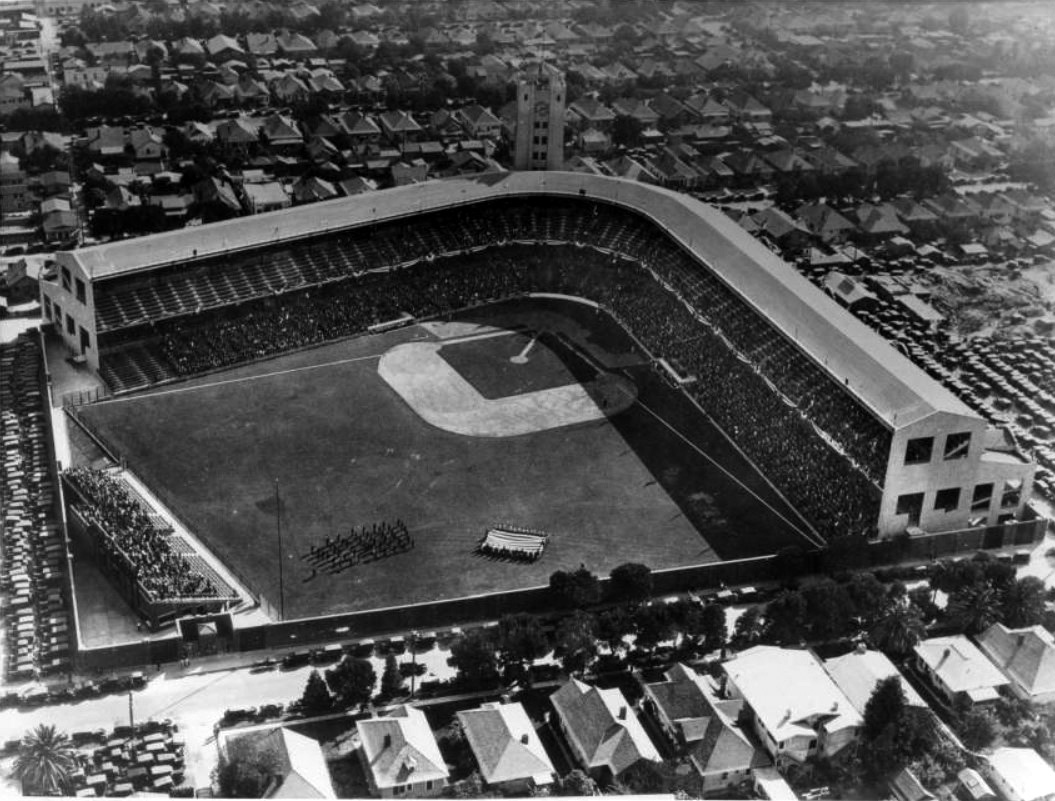 |
|
| (ca. 1940)* – Aerial view showing Wrigley Field at pre-game ceremony. An American flag being supported by four lines of people can be seen below the diamond. A group of people stand in rows to the left of the flag while the lower levels of the stadium are visibly full. The clock tower behind the stadium shows the time at 2:40 in the afternoon. |
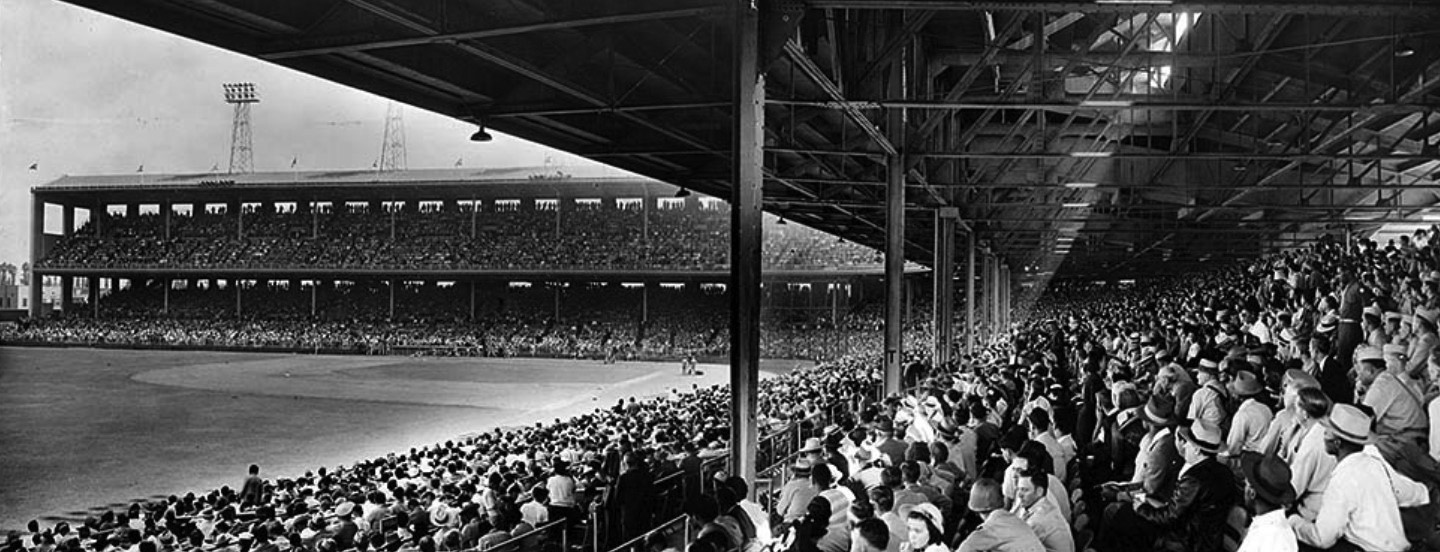 |
|
| (1943)* - A turnout of 21,742 paying fans attended a benefit game between major league stars, led by Joe DiMaggio, and a team composed of Hollywood Stars and Los Angeles Angels players. The major leaguers won 8-2. This two-photo panorama of Wrigley Field was published in the Aug. 22, 1943, Los Angeles Times |
 |
(1951)* - Chuck Connors, baseball player for both the Angels and the Hollywood Stars. During his short baseball career, 1949 - 1951, Conners also played on the Brooklyn Dodgers and Chicago Cubs.
|
Historical Notes Chuck Connors, made a successful move from one side of the box seat railing to the other, becoming the star in "The Rifleman", a popular 1950's TV show. |
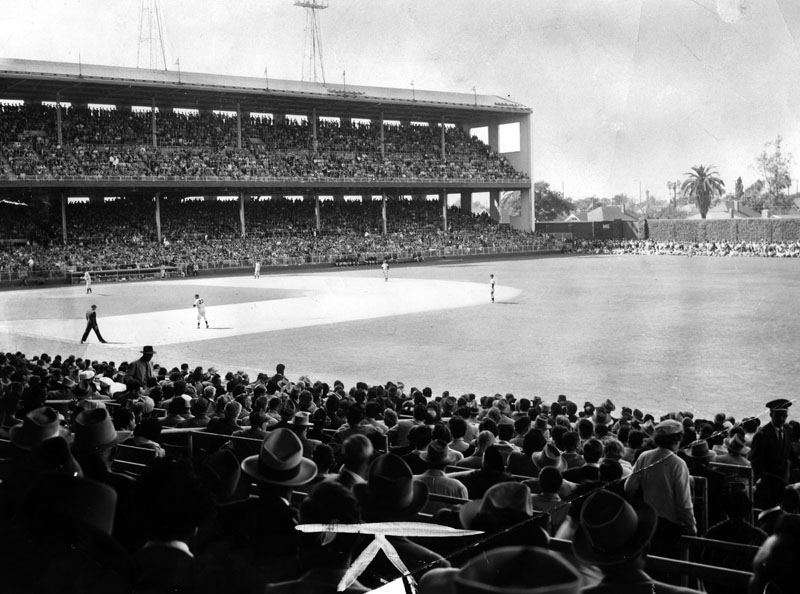 |
|
| (1955)* - Another full house at Wrigley Field to watch their home team the Angels. Note the left field wall is now covered in ivy. |
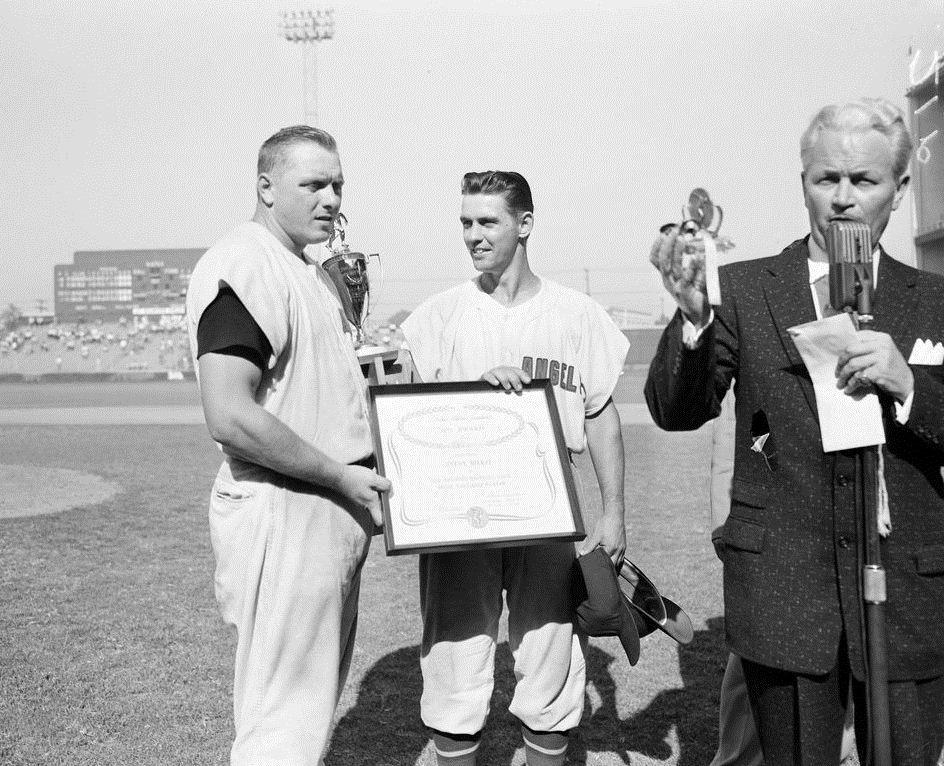 |
|
| (1956)^ - Steve Bilko receives 'Most Valuable Player Award' from Gene Mauch. |
Historical Notes In 1956 Steve Bilko had a notable achievement. That year he won the Triple Crown with stats (Home Runs, RBI's, and Batting Average) exceeding that of Mickey Mantle, who also won the Triple Crown that same year in the American League. The 1956 Angels Club featured second baseman Gene Mauch. The "Little General" as he would be nicknamed years later, went on to become one of the winningest managers in Major League Baseball history. |
 |
|
| (1957)* - Steve Bilko (left), the Angels' greatest power hitter. From 1955-1957, the burly Bilko led the PCL in home runs; he won the Triple Crown in 1956, leading the Angels to the pennant. So popular was Bilko that comedian Phil Silvers named his most famous character, Sergeant Bilko, after the first baseman. To the right of Bilko is Dick Stuart, also of the Hollywood Stars. He was nicknamed "Dr. Strangeglove" for his defensive deficiencies. |
 |
|
| (1957)* - In 1957, Walter O'Malley traded his farm team, the Fort Worth Cats, and cash in exchange for the Los Angeles Angels and Wrigley Field, a deal that gave O'Malley territorial rights to L.A. Many fans assumed that he would move the Dodgers to Wrigley Field--home of the Angels--and architects drew up plans to boost seating capacity at the aged stadium. Instead, O'Malley decided to begin play in the renovated Coliseum. |
Historical Notes In February 1957, Phil Wrigley (heir son of William Wrigley), sold both the team and Wrigley Field to Walter O'Malley, owner of the Brooklyn Dodgers, for $3,000,000. The last Pacific Coast League game at Wrigley Field was played on September 15, 1957. |
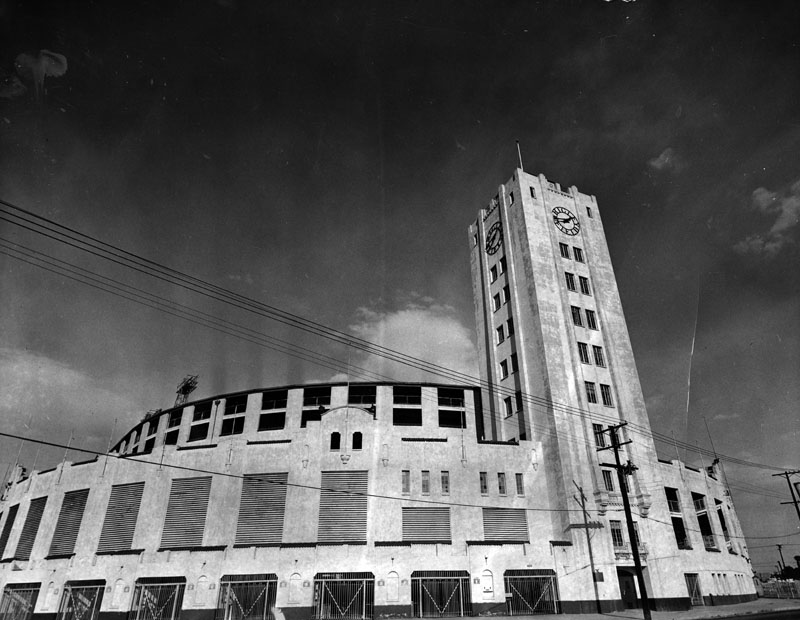 |
|
| (1960)* - Photograph caption dated December 8, 1960 reads, "Here's an exterior shot of Wrigley Field which will house the new Angel baseball team of the American League when it makes its local debut next year. The park, which has a present capacity of 22,500, may be expanded slightly. It is now city-owned, with 340 feet deep left field, 339 feet in right, and 412 feet deep in center. 'It's in good condition,' said officials." |
Historical Notes The Angels franchise of today was established in MLB in 1961 after former owner Gene Autry bought the rights to continue the franchise name from Walter O'Malley, the former Los Angeles Dodgers owner who had acquired the franchise from Phil Wrigley, the owner of the Chicago Cubs at the time. As stated in the book Under the Halo: The Official History of Angels Baseball, "Autry agreed to buy the franchise name for $350,000, and continue the history of the previously popular Pacific Coast League team as his own expansion team in the MLB." After the Angels joined Major League Baseball, some players from the Angels' PCL team joined the MLB Angels in 1961. |
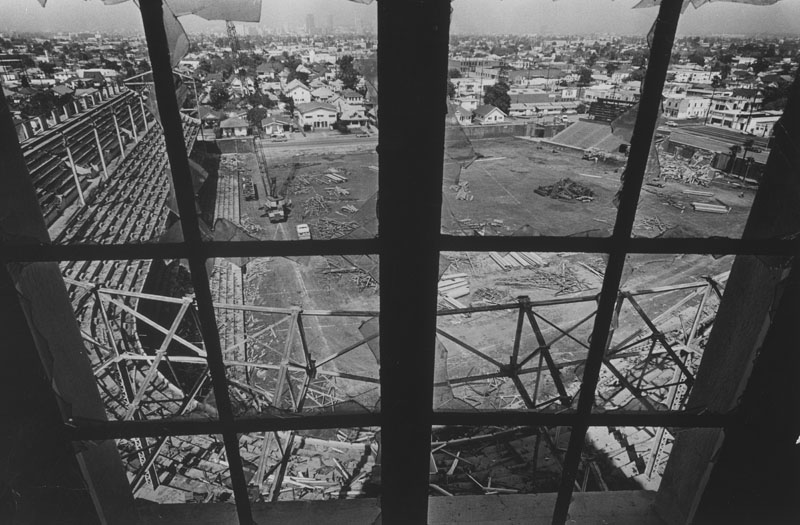 |
|
| (1966)* - Demolition of Wrigley Field. Photo dated: March 19, 1966. |
Historical Notes In 1961, the Los Angeles Angels joined the American League as an expansion team and took residence at Wrigley Field for just one season. The Angels then moved into Dodger Stadium with the Los Angeles Dodgers, until 1965. In 1966, the Angels moved into their own home, Anaheim Stadium. Sadly, with no minor league baseball teams left in the area, Wrigley Field was torn down in the mid 1960s; Gilbert Lindsay Park presently occupies the site. |
* * * * * |
Gilmore Field (Home of the Hollywood Stars)
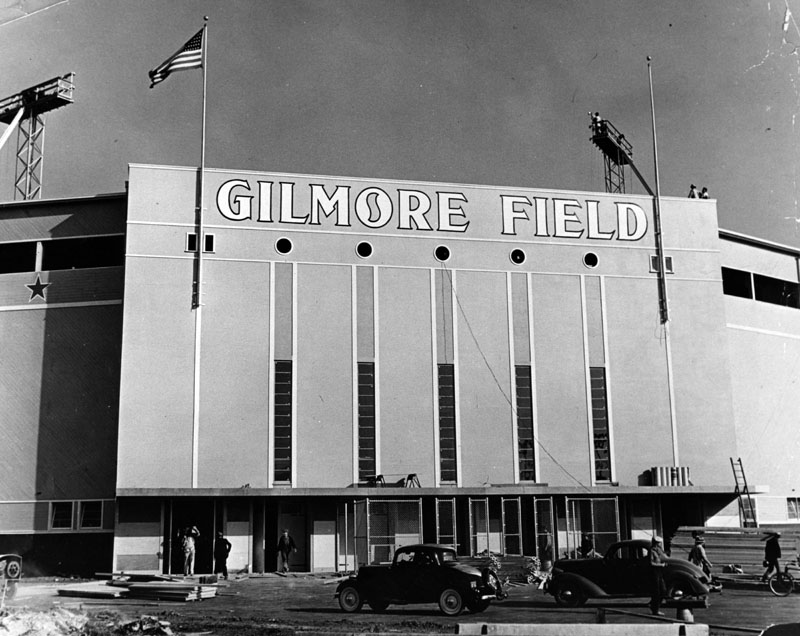 |
|
| (1939)* - Exterior view of the new Gilmore Field (Hollywood Ball Park). |
Historical Notes Gilmore Field opened on May 2, 1939 and was the home of the Hollywood Stars until September 5, 1957. The team that came to be known as the Hollywood Stars took a circuitous route on its way to Los Angeles. It began its existence in 1903 as the Sacramento Solons, a charter member of the PCL. The team moved to Tacoma in 1904, where it won the pennant as the Tacoma Tigers. During the 1905 season, the team returned to Sacramento to finish out the season, moved to Fresno in 1906 to finish last as the Fresno Raisin Eaters, then left the PCL altogether. The Sacramento Solons rejoined the PCL in 1909, then moved to San Francisco during the 1914 season, finishing out the season as the San Francisco Missions. The team was sold to Utah businessman Bill "Hardpan" Lane and moved to Salt Lake City for the 1915 season. They played as the Salt Lake Bees for the next eleven seasons until Lane moved the team to Los Angeles for the 1926 season. Originally they were known as the Hollywood Bees, but soon changed their name to the Hollywood Stars. After but one season, the team was sold to new owners, among them Bob Cobb of Brown Derby Restaurant fame and the inventor of the California Cobb Salad. In their salad days, as it were, the Stars attracted glamorous actors and other celebrities or anyone else who wanted to be "seen", much as Dodger Stadium would later. |
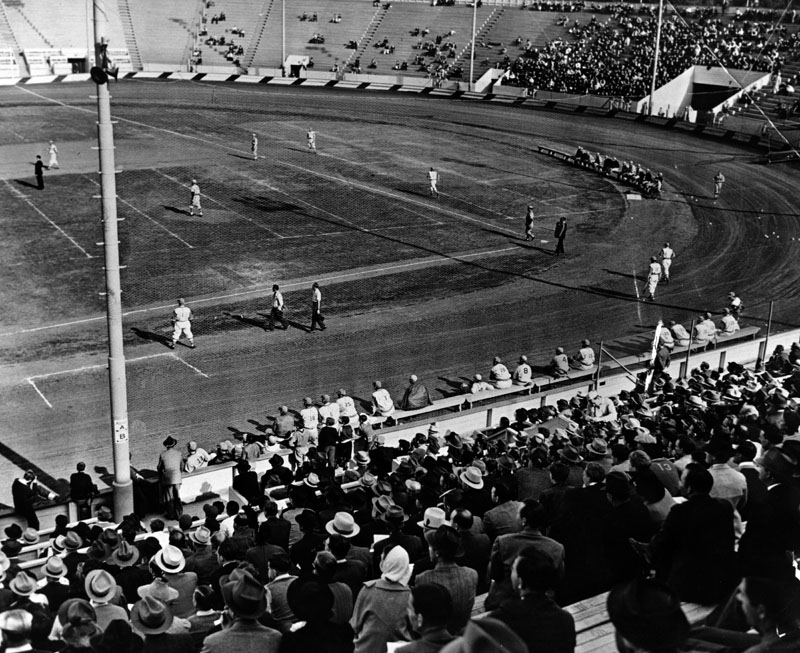 |
|
| (1939)* - The Hollywood Stars playing at the Gilmore Stadium prior to the completion of Gilmore Field. Photograph dated April 5, 1939 caption reads, "Here is a general view of the debut of Coast League baseball in Hollywood yesterday. Scene is of the Hollywood-Portland game, won by the Stars, 9-5. Crowd of 3500 turned out to watch the game." |
Historical Notes Built by Earl Gilmore, Gilmore Stadium opened in May 1934 and was demolished in 1952. The first professional football team in Los Angeles, the Los Angeles Bulldogs played at Gilmore. Before the neighboring Gilmore Field opened on May 2, 1939, the Hollywood Stars used Gilmore Stadium for their home games (apparently for only one month). |
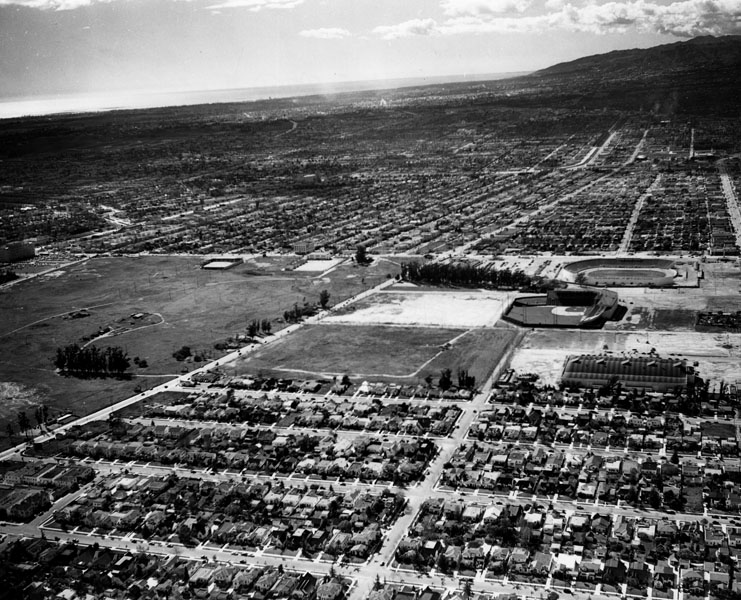 |
|
| (ca. 1939)* - Aerial view of Hollywood Ball Park (Gilmore Field) and Gilmore Stadium. This site later became Farmers Market and later The Grove shopping center, as well as CBS Television City. |
Hsitorical Notes The Gilmore Field ballpark was located on the south side of Beverly Boulevard between Genesee Avenue and The Grove Drive, just east of where CBS Television City is currently located. A couple hundred yards to the west was Gilmore Stadium, an oval-shaped venue built several years earlier, which was used for football games and midget auto racing. To the east was the famous Pan-Pacific Auditorium. Both facilities were built by Earl Gilmore, son of Arthur F. Gilmore and president of A. F. Gilmore Oil, a California-based petroleum company which was developed after Arthur struck oil on the family property. The area was rich in petroleum, which was the source of the "tar" in the nearby La Brea Tar Pits. |
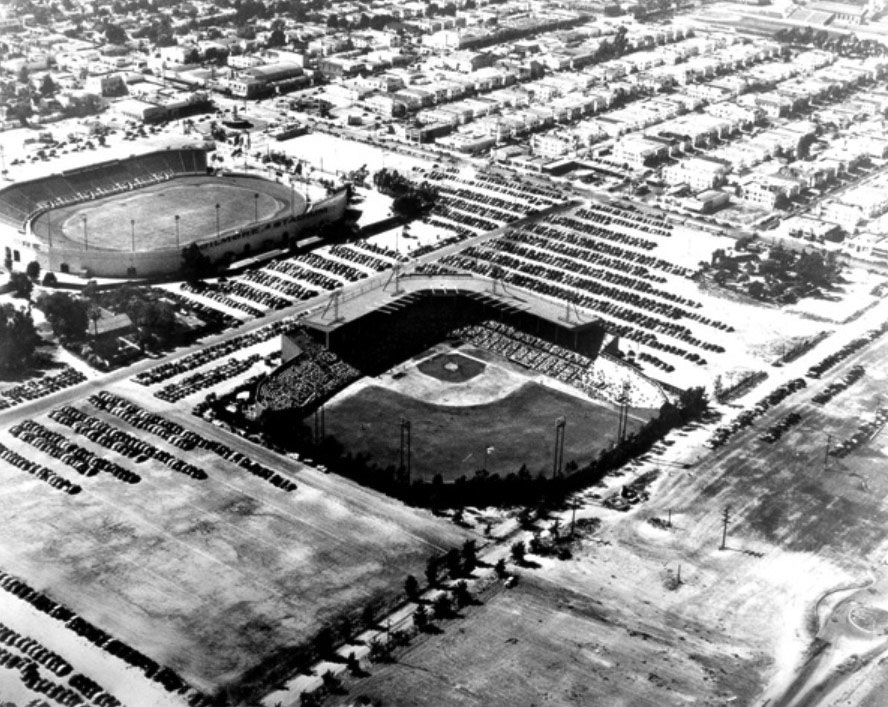 |
|
| (ca. 1939)^^^ – Aerial view looking northwest showing Gilmore Field. A baseball game is in progress and parking lots are close to full. An empty Gilmore Stadium stands in the background near Fairfax Avenue. Genesee Avenue runs diagonally from lower-left to right-center where it intersects with Beverly Boulevard. |
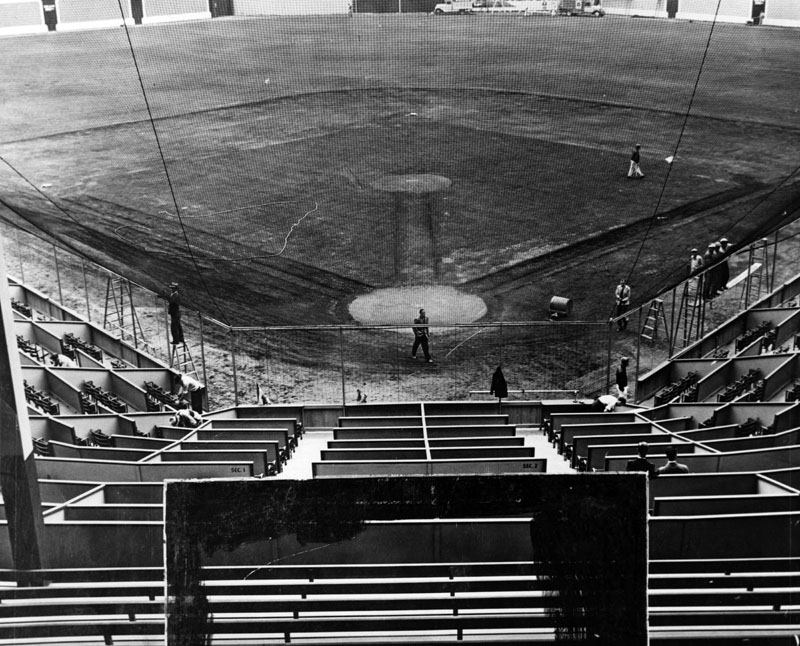 |
|
| (1939)* - On baseball's 100th anniversary, new park is christened in Hollywood today. Here's the shiny new diamond that greeted fans at Gilmore Field, home of Hollywood Stars, this afternoon when Stars opened series with Seattle. Note how close boxes are to the baselines. Photo dated: May 2, 1939. |
Historical Notes The field had intimate quarters from the spectator standpoint - first and third bases were 24 feet from the first row of seats. Home plate was 34 feet from the stands. The outfield gave the pitchers more of a break with foul lines 335 feet long, power alleys about 385, and 407 to center field. The power alleys were thus 40 feet deeper than in the cross-town counterpart, Wrigley Field. |
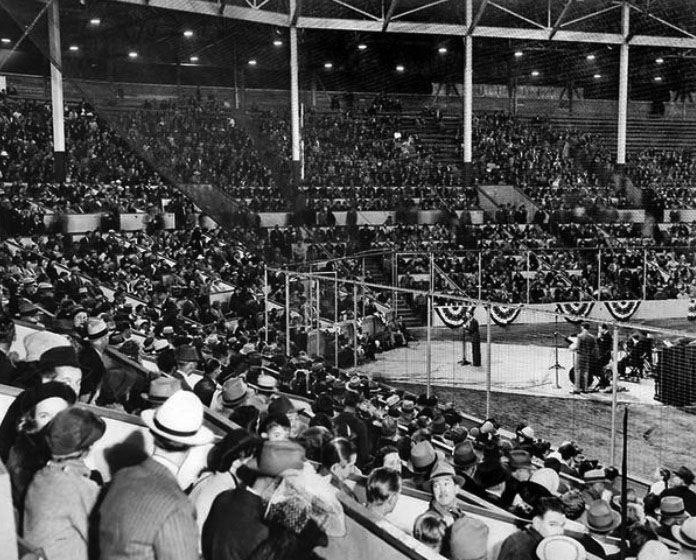 |
|
| (1939)* - Opening Ceremony for the 12,000 seat Gilmore Field on May 2, 1939. |
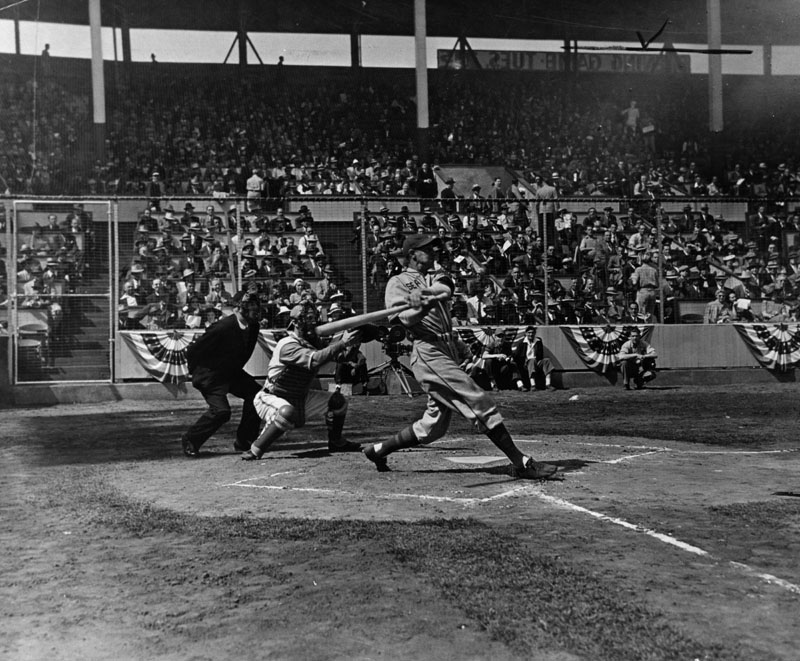 |
|
| (1939)* - Baseball went Hollywood today as the Stars opened their new park, Gilmore Field, before 10,000 fans and movie celebrities. Shown is Jo-Jo White, Seattle's outfielder as he flies out. Doc Crandall is the Stars' catcher. Photo dated: May 2, 1939. |
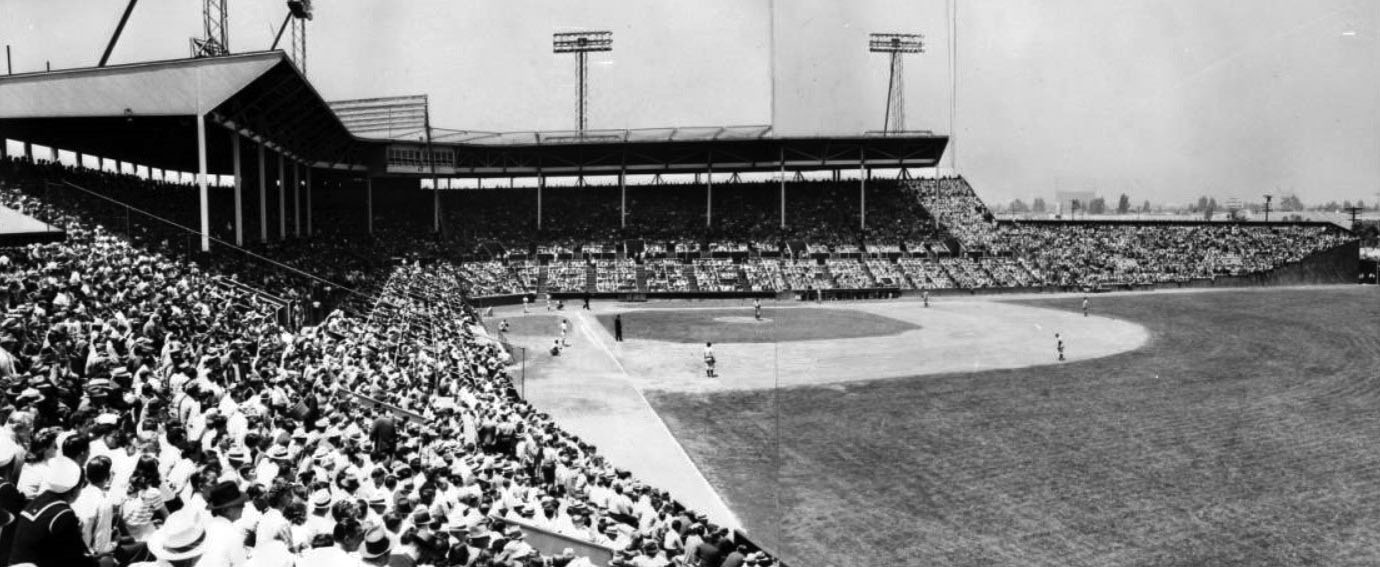 |
|
| (ca. 1939)^ - Panoramic view of Gilmore Field as seen from the seats in right field. |
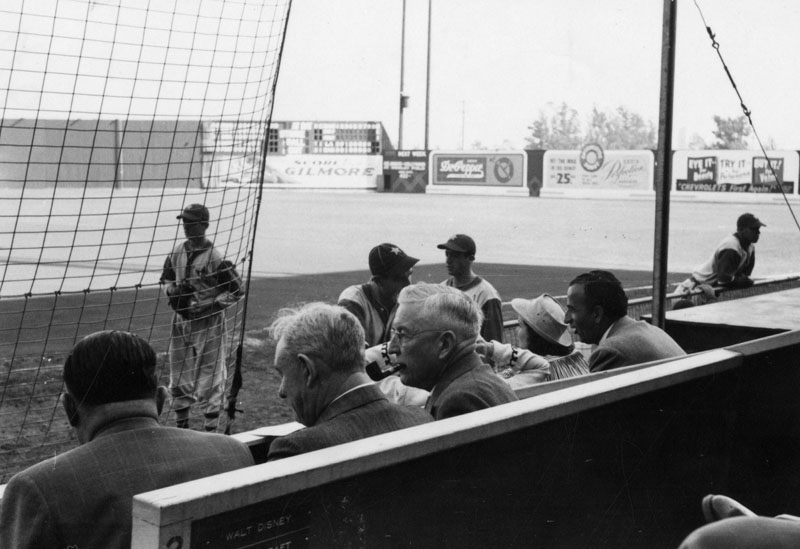 |
|
| (ca. 1940)* - Spectators are seen watching a baseball game in progress at Gilmore Field and Hollywood Ball Park, home of the Hollywood Stars team. The visiting team playing the Stars is unidentified. In the foreground behind the benches, name plaques read, "Walt Disney" and "George Raft", who must have been Stars fans. |
Historical Notes The team's owners realized the team needed to represent Hollywood in order to succeed. They sold stock in the team to movie stars, movie moguls, and Hollywood civic leaders ("the Hollywood Stars owned by the Hollywood stars"). One of these, Gene Autry, subsequently became owner of his own major league franchise, now the Los Angeles Angels of Anaheim. Another major investor was William Frawley from TV's I Love Lucy. Moreover, the team actually played in the Hollywood area, beginning in 1939 when 13,000-seat Gilmore Field was opened in the Fairfax District adjacent to Hollywood. The club played part of the 1939 season in nearby Gilmore Stadium, after having played at Wrigley Field during 1938. |
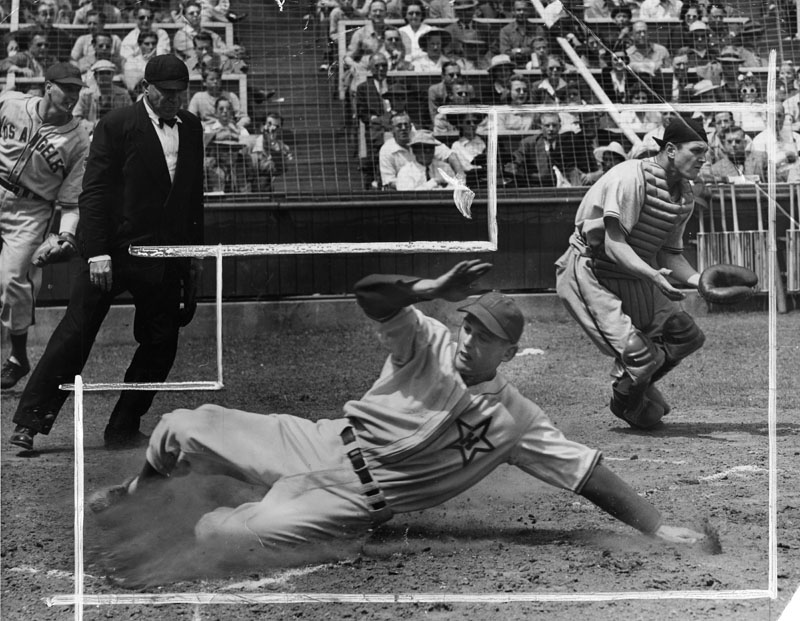 |
|
| (1942)* - There was action plus in the "Civil War" series between Los Angeles and Hollywood at Gilmore Field, as shown. Bill Garbe, Hollywood first baseman, slides safely home in the fourth frame of the first games which the Stars won, 13 to 1. Angel catcher Gilly Campbell prays for the ball. The Stars lost the second tilt, 6 to 4, but won the series 4 games to 3, with veteran Charlie Root the hero. Photo dated: May 11, 1942. |
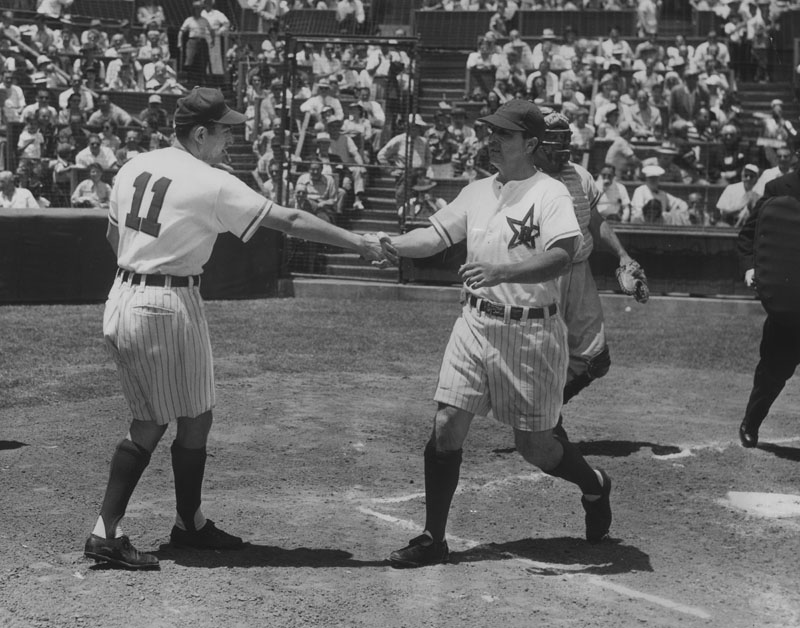 |
|
| (1950)* - Here, after hitting a home run, Frank Kelleher gets a congratulatory handshake from Herb Gorman. The stylish but impractical shorts lasted only a few seasons. |
Historical Notes The Stars had the dubious distinction of being the first team to replace the traditional bloused baseball trousers and stirrup socks with shorts and long socks in 1950. The theory was that players could run faster in this gear than in the baggy wool or cotton flannel uniforms of the day. The new uniforms resembling those worn by female softball players were "too Hollywood" even for Hollywood, as well as being very tough on the legs when sliding. They were soon replaced. The new Stars (or “Twinks”) caught on and became a very popular team, winning three pennants before 1958. They had successful affiliations with the Brooklyn Dodgers and Pittsburgh Pirates of Major League Baseball. In 1955, actress Jayne Mansfield was named Miss Hollywood Star. The Stars became genuine rivals of the Angels, and it was not uncommon for fights between the teams to break out during Angels-Stars games. In fact, on August 2, 1953, a brawl between the two teams lasted 30 minutes, broken up only when 50 riot police were sent to Gilmore Field by Chief of Police William Parker, who was at home watching the game on television when the fight started.*^ |
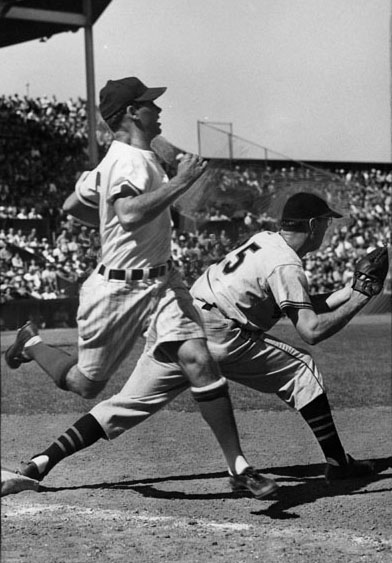 |
(1950)* -
Buddy Hicks, Hollywood, is nipped at first in a close play in yesterday's first game as the Twinks beat San Diego in a double header. Jack Graham is the Padre first sacker.
|
|
 |
|
| (1950)*^* - Jim Baxes batting during Hollywood Stars vs. San Francisco Seals game. |
Historical Notes LA Times Published Caption: "TAIN'T FUNNY--When Seal Hurler, Chet Johnson sizzled his first pitch behind Jim Baxes' back to mimic Jim's wildness, he got a big laugh. But it wasn't so funny when Johnson's next pitch, this steaming curve, caught Baxes in middle of back in eighth inning. Seals won 13-3." *^* |
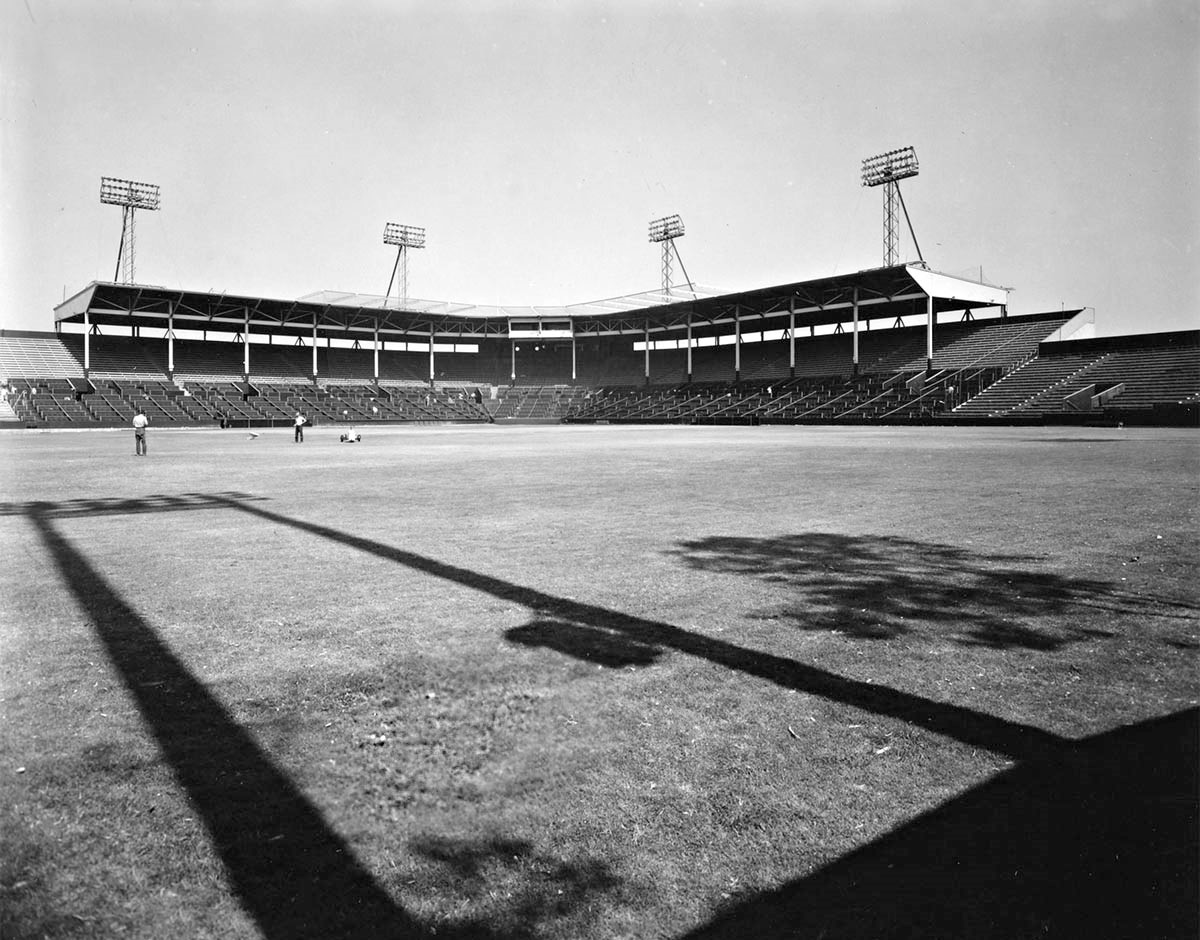 |
|
| (1949)* – View of a nearly empty Gilmore Field before start of a game. Photo by Julius Shulman |
.jpg) |
|
| (1949)* – Pre-game view from edge of the grandstands at Gilmore Field. Photo by Julius Shulman |
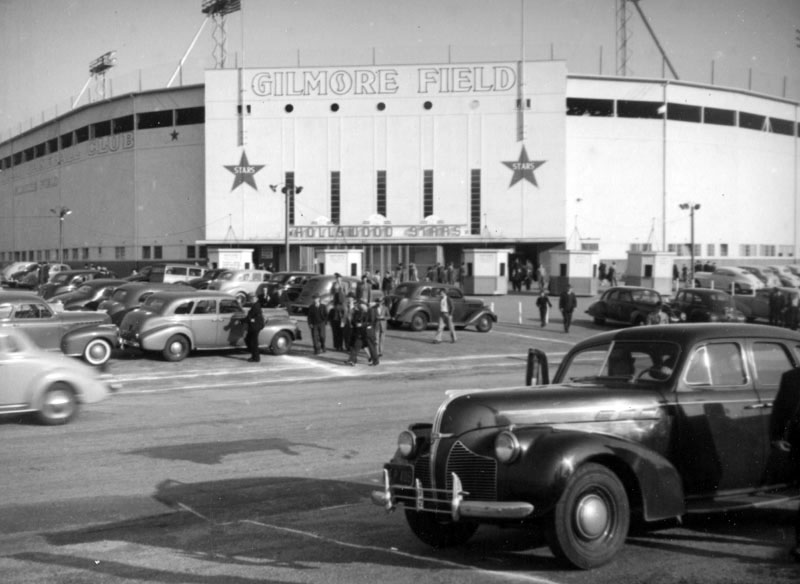 |
|
| (1940s)* - View showing Gilmore Field (aka Hollywood Ball Park), located near the present-day Farmer's Market in the Fairfax District. This was home field of the Hollywood Stars. The parking lot appears full and there are clusters of people walking out of the main entrance. |
 |
|
| (1940s)^ - Closer view of the entrance to Gilmore Field….Home of the Hollywood Stars. |
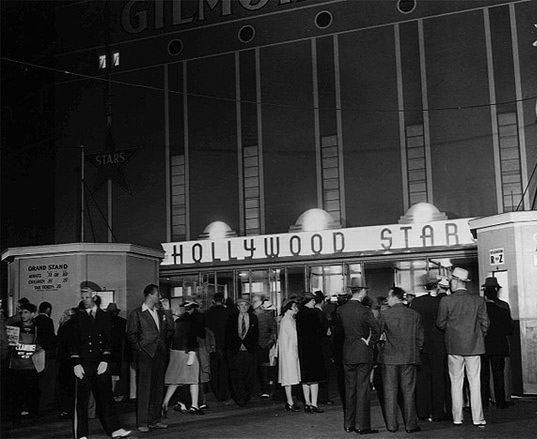 |
|
| (1940s)* - Fans line up at front entrance to see the Hollywood Stars play a night game. |
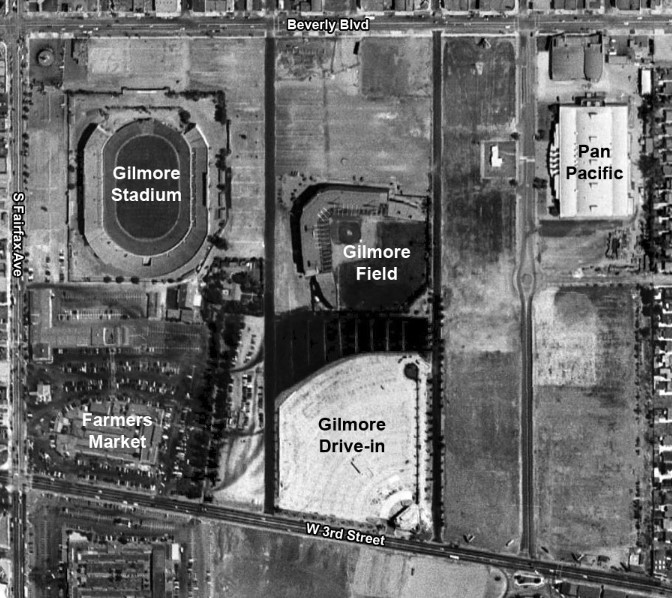 |
|
| (1948)^^* – Aerial view of the area bounded by Beverly, Fairfax, 3rd Street, and Gardner Avenue. Gilmore Field stands smack in the center of the photo surrounded by Gilmore Stadium, Pan Pacific Auditorium, Gilmore Drive-in, and Farmers Market. |
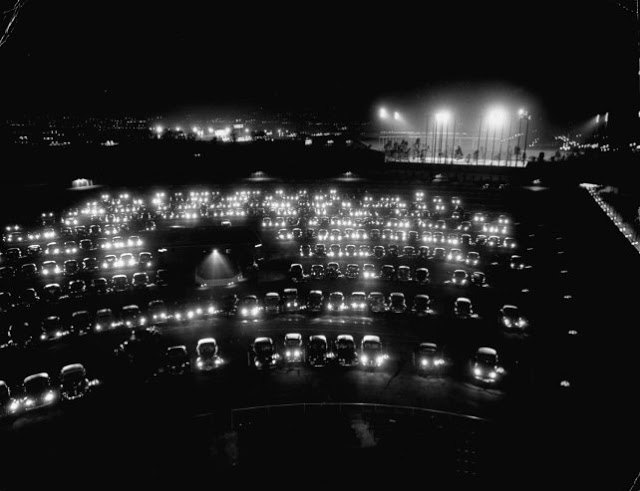 |
|
| (1949)*^^^ - Night view looking north showing three concurrent venues: Movies at the Gilmore Drive-In Theatre (foreground), Hollywood Stars home game at Gilmore Field (upper-right), and a football game at Gilmore Stadium (upper-left). |
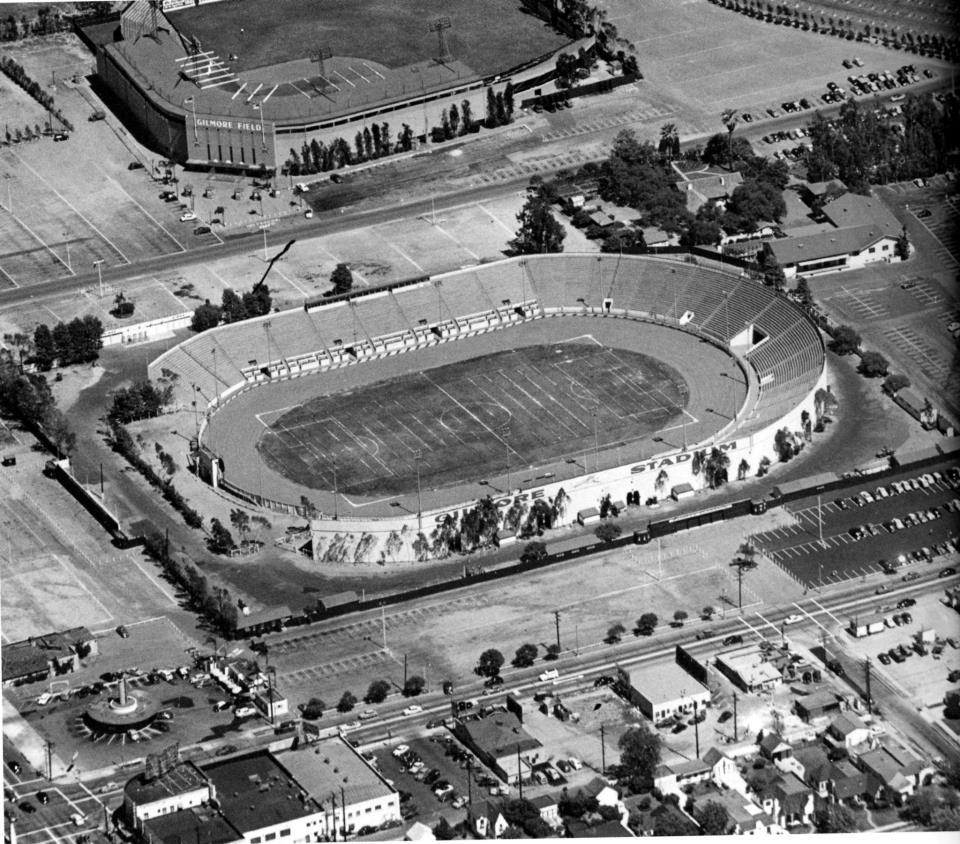 |
|
| (1949)**^ - Aerial view looking southeast of Gilmore Field and Gilmore Stadium. The intersection of Fairfax Avenue and Beverly Boulevard is in the lower left of the photo. Herberts Drive-In Restaurant can be seen on the southeast corner (lower-left). |
Historical Notes In 1952 CBS Television City was built facing Beverly Boulevard on the site of Gilmore Stadium. |
 |
|
| (ca. 1950)#** - Aerial view of Gilmore Field showing a near-full parking lot. A portion of the Gilmore Stadium can be seen in the lower right. |
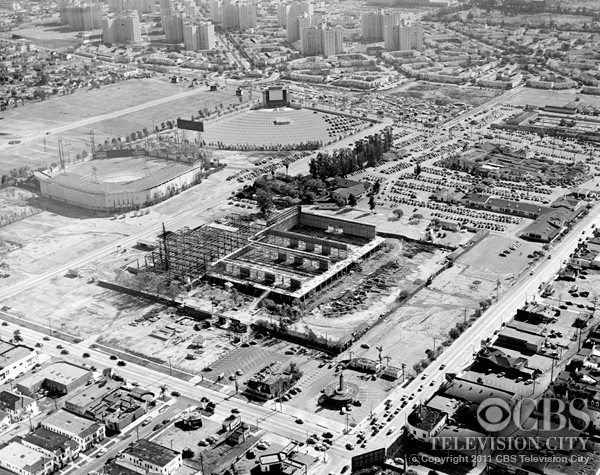 |
|
| (1951)^^* – Aerial view looking southeast showing Gilmore Field surrounded by CBS Television City (under construction at the site of the old Gilmore Stadium), Gilmore Drive-In, Park La Brea Towers, and Farmers Market. Credit: CBS Photo Archive. |
Historical Notes In 1950, the Gilmore Company sold both the football stadium and baseball park to the Columbia Broadcasting System who then announced plans to raze the facility to build a new headquarters - CBS Television City, as it became known. In 1958 Gilmore Field was also demolished and the studio expanded on the grounds where baseball was once played. |
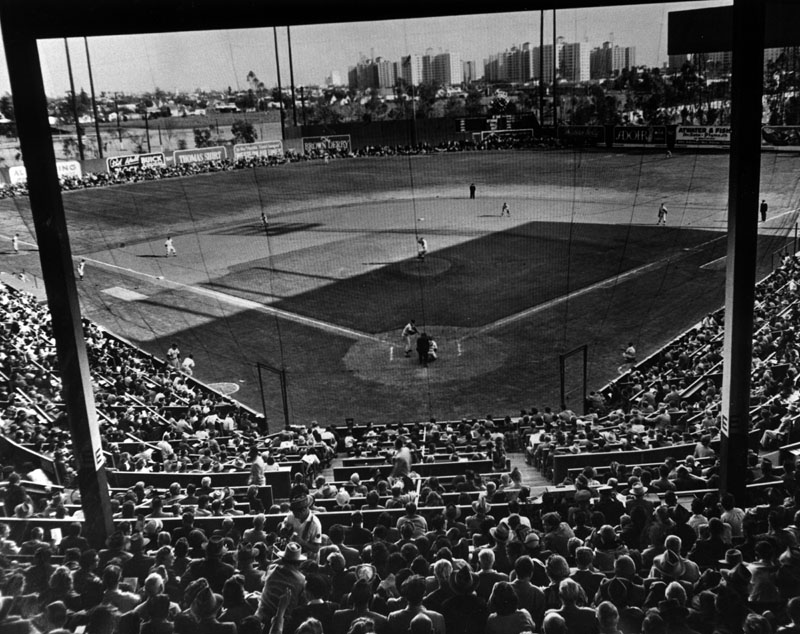 |
|
| (1951)* - Major league All-Stars managed by Ty Cobb and Tris Speaker clashed at Gilmore Field, with the big-leaguers beating the Hollywood Stars, 4-3, for charity. Fans thrilled to Gus Zernial's two homers. This view is looking southeast toward Park La Brea which can be seen in the distance. |
Historical Notes In October 1957, the Brooklyn Dodgers confirmed their long-rumored move to Los Angeles for the 1958 season, which forced the Stars and the Angels to relocate. The Angels, who had been purchased by Dodgers owner Walter O'Malley prior to the 1957 season, became the Spokane Indians in 1958. |
* * * * * |
Basebal in the Coliseum
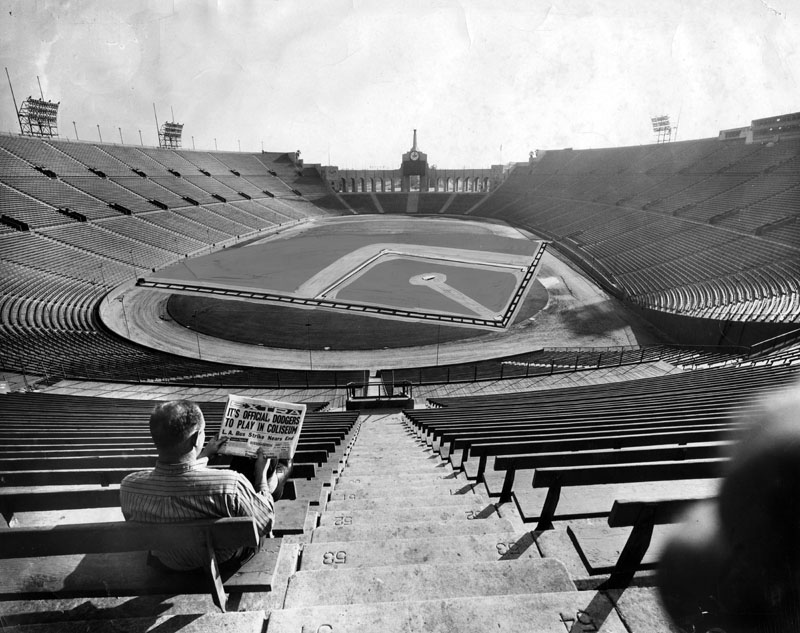 |
|
| (1958)* - View of the Los Angeles Memorial Coliseum where a man is sitting in the 53rd row. The headline of the newspaper that he is holding says, "It's official, Dodgers to play in Coliseum." Photograph caption reads: "Here's Dodger fan's perspective of Coliseum diamond from 53rd row. Dotted lines indicate foul lines on field where Dodgers open season here against Giants April 18." |
Historical Notes While Dodger Stadium was under construction, the Dodgers played in the league's largest capacity venue from 1958 through 1961 at their temporary home, the Los Angeles Memorial Coliseum, which could seat in excess of 90,000 people. |
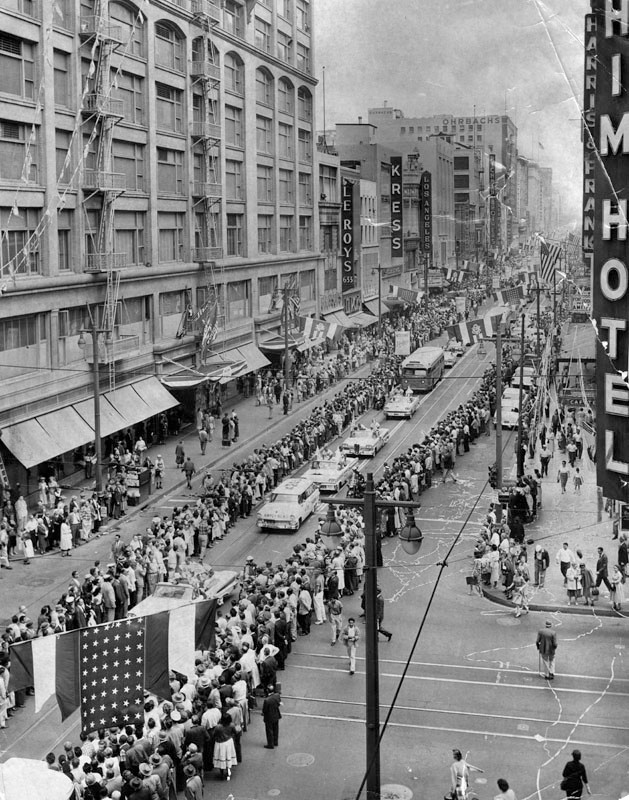 |
|
| (1958)* - The team rides in a motorcade parade down Broadway, en route to the Coliseum for its first game in Los Angeles. |
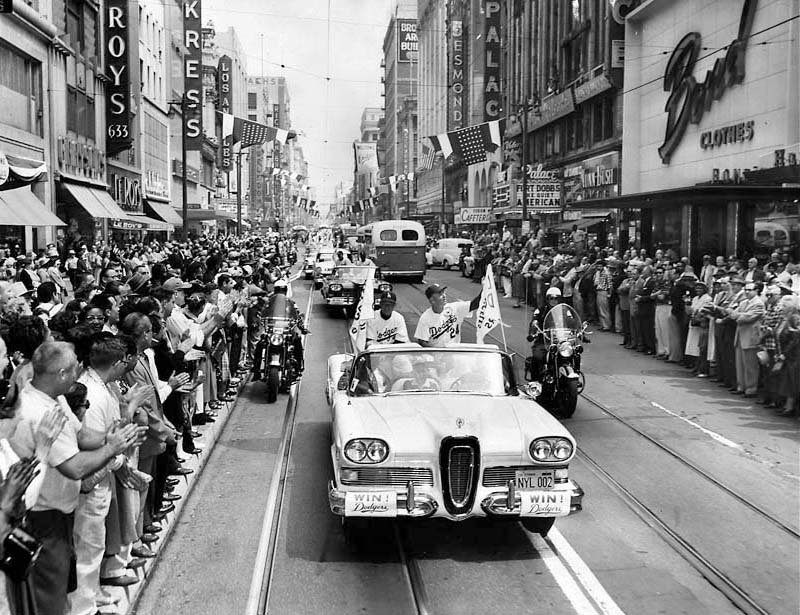 |
|
| (1958)*^^ - Spectators line Broadway as Dodgers Manager Walter Alston, right, and coach Charlie Dressen ride in a caravan to their first game at the Coliseum, April 18, 1958. |
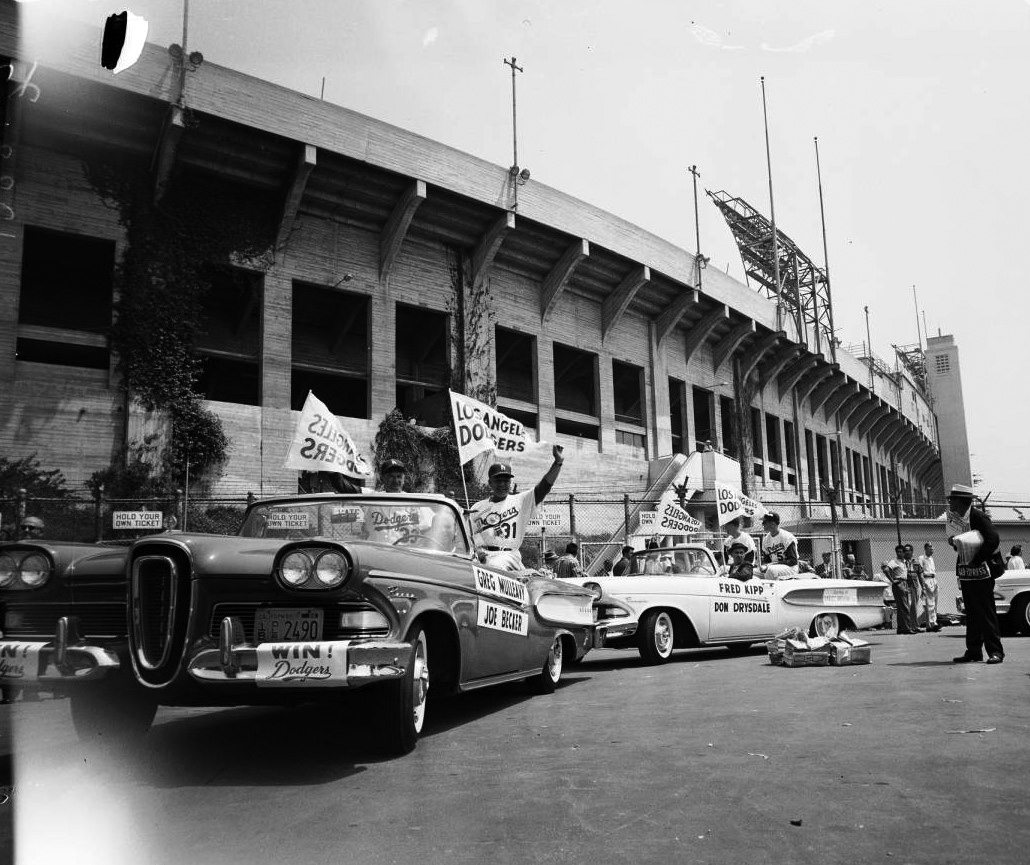 |
|
| (1958)^ – Dodgers arrive at the Coliseum in style before their first game as the 'Los Angeles Dodgers'. |
 |
|
| (1958)^^* - Opening day at the Coliseum, April 18, 1958. The Dodgers played the San Francisco Giants. |
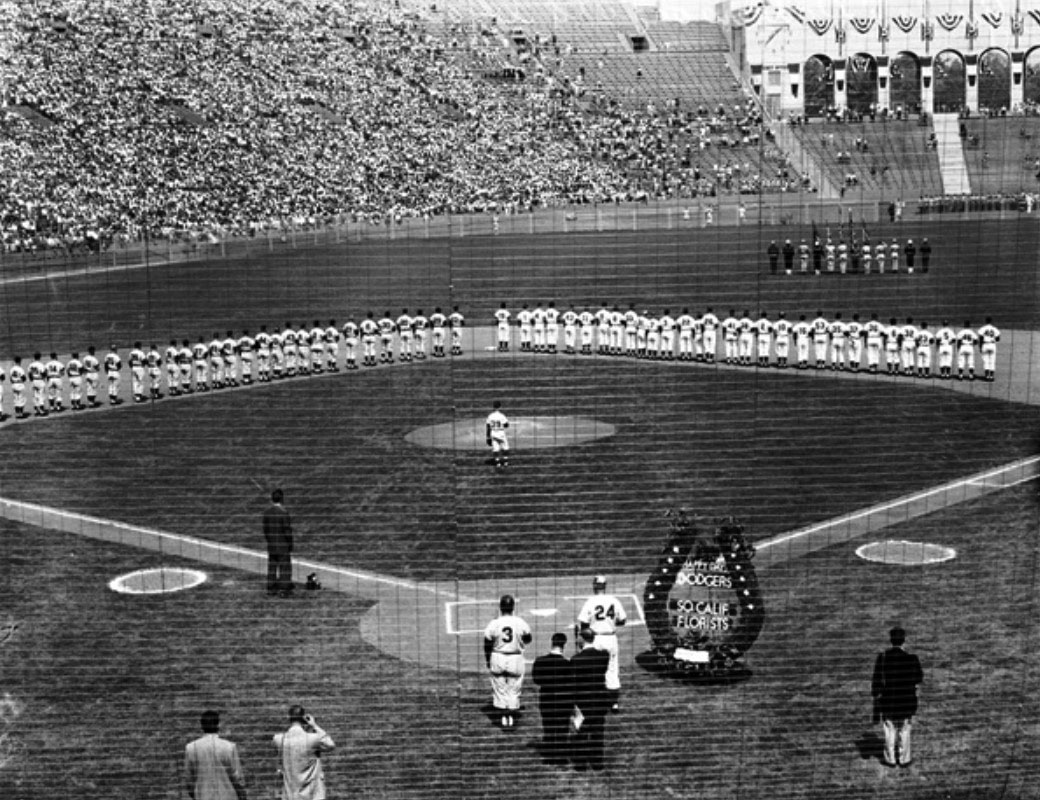 |
|
| (1958)^ - The Los Angeles Dodgers host the San Francisco Giants on Opening Day. Players and spectators stand at attention during the playing of the national anthem. |
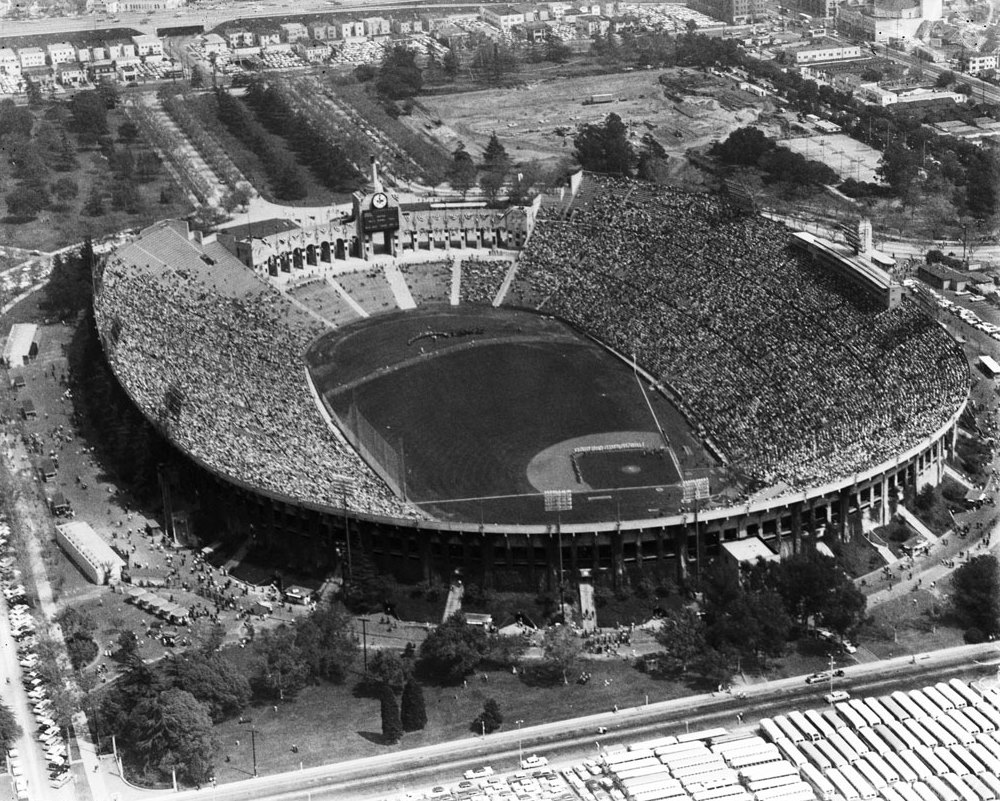 |
|
| (1958)^ - Aerial view of the Coliseum on Dodger’s opening day, April, 18, 1958. |
Historical Notes In their first game in Los Angeles, the Dodgers beat the San Francisco Giants 6-5 in front of 78,672 fans at the Coliseum. Despite their inept play and seventh-place finish, the Dodgers drew a record 1,845,556 fans in their first year in Los Angeles. |
 |
|
| (1958)* - Closer view of the Dodger's first home game in Los Angeles, before a crowd of 78,672 at the Coliseum. |
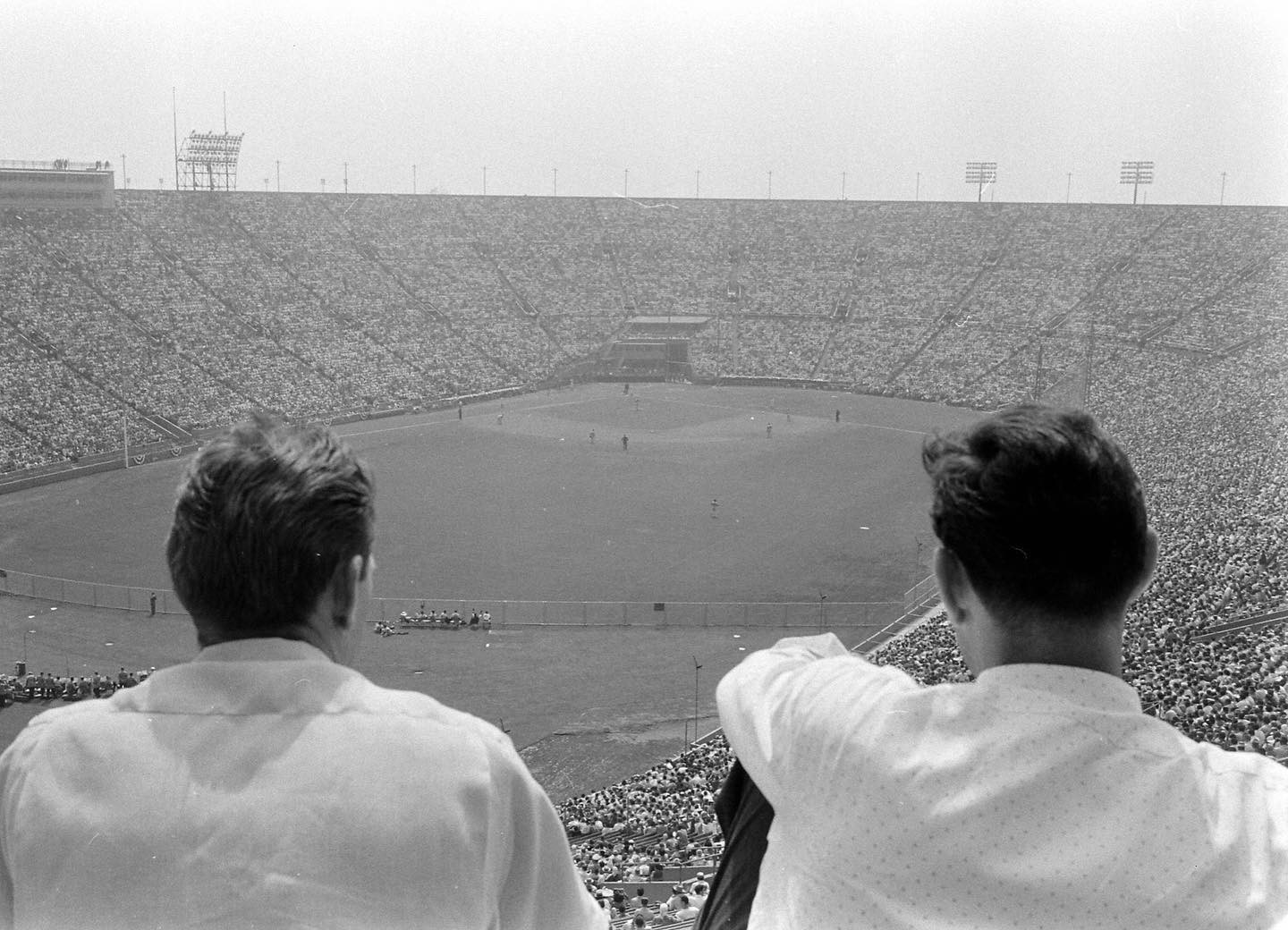 |
|
| (ca. 1958)* - Nice afternoon Dodger game at the Coliseum but unfortunately forgot to bring the binoculars and my eye drops. Photo by Allan Grant for LIFE Magazine. |
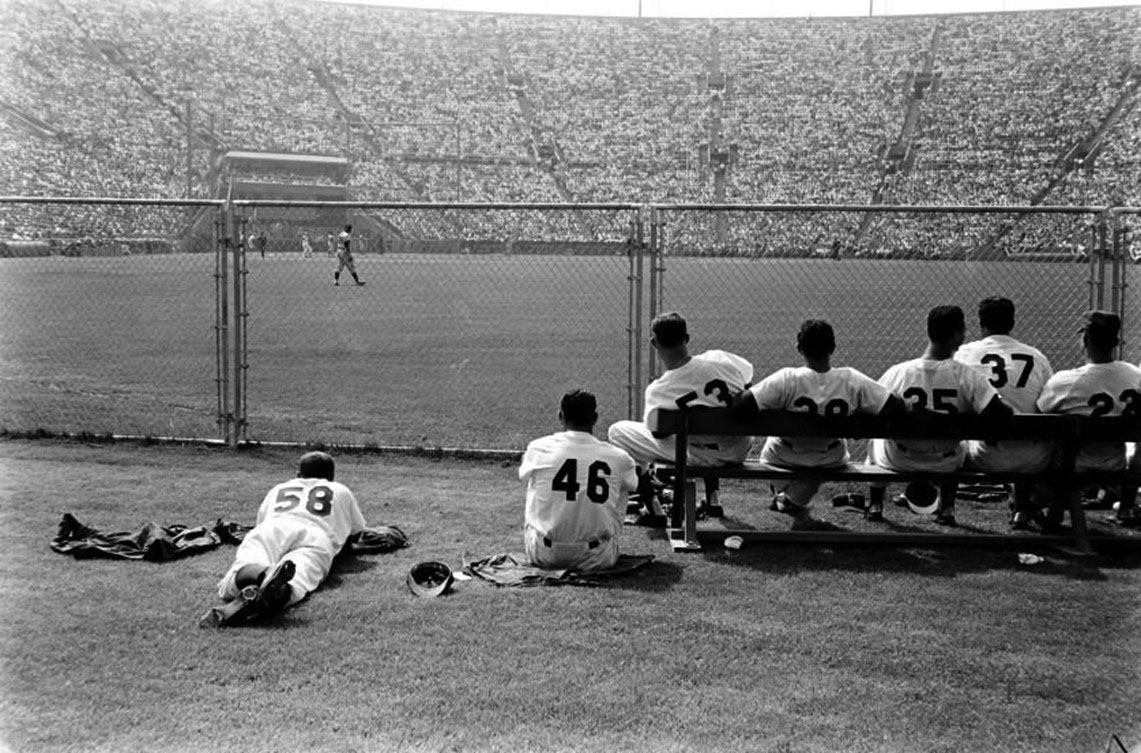 |
|
| (1958)^ - The Dodgers bullpen taking in the first MLB game in Los Angeles (April 18th, 1958) at the Los Angeles Memorial Coliseum. L-R: Joe Pignatano, Don Bessent, Don Drysdale, Ron Negray, Larry Sherry, Ed Roebuck, and Johnny Podres. |
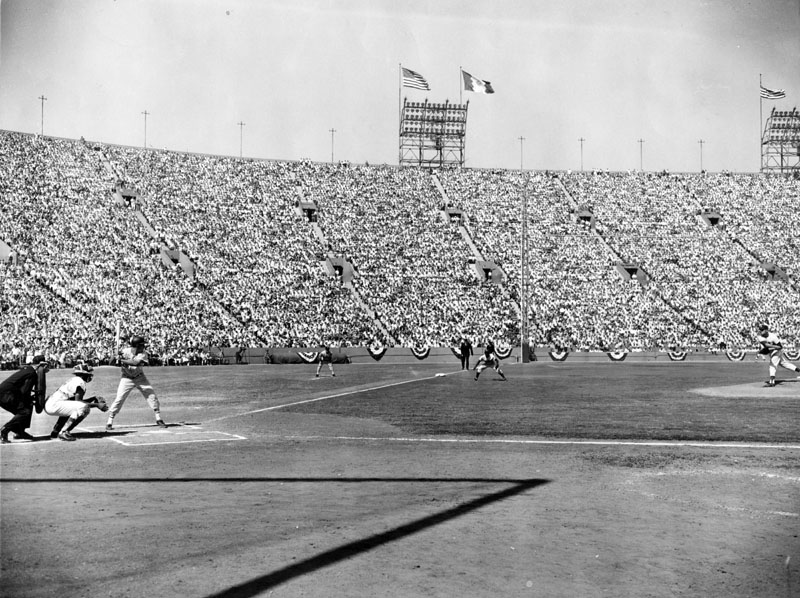 |
|
| (1959)* - Crowds packed the Coliseum to watch the new team in town, the Los Angeles Dodgers, play from 1958 to 1961 setting new records for attendance. |
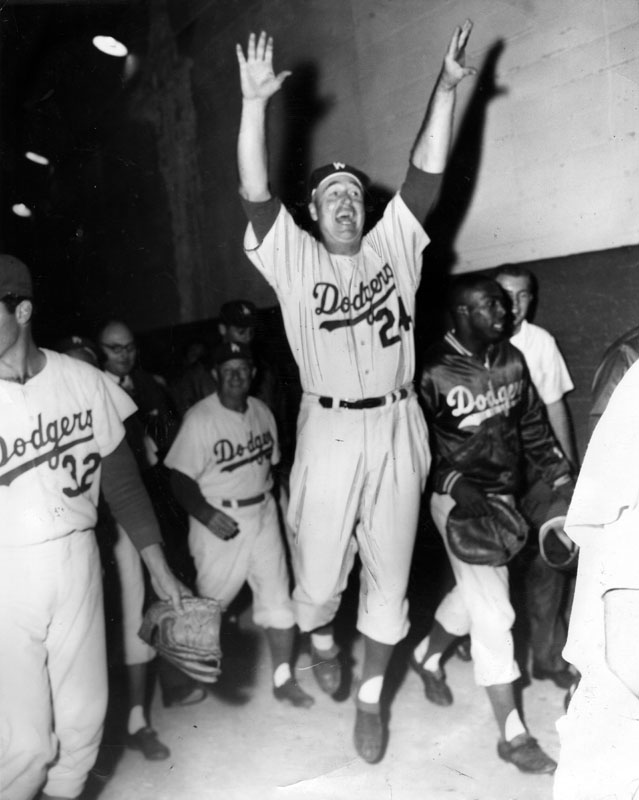 |
|
| (1959)* - Manager Walt Alston being mobbed by players and well-wishers in the tunnel en route to the clubhouse, is so happy that he suddenly stops, leaps in the air and kicks his feet together. His team just won the pennant. |
Historical Notes The 1959 Los Angeles Dodgers finished in a first-place tie with the Milwaukee Braves, with each club going 86-68. The Dodgers won the pennant as they swept the Braves in a best-of-three playoff series. They went on to defeat the Chicago White Sox in the 1959 World Series in just their second season since leaving Brooklyn. Walter Alston won seven National League pennants in his 23 years tenure as Dodgers manager. In 1955 he led Brooklyn to the pennant and its only World Series championship; the team repeated as National League champions in 1956. After the Dodgers moved to Los Angeles, Alston led the team to pennants in 1959, 1963, 1965, 1966 and 1974, and three more world championships (1959, 1963, 1965). He was the first Dodger manager to win a World Series. Named Manager of the Year six times, Alston also guided a victorious NL All-Star squad a record seven times. He retired after the 1976 season with 2,063 wins (2,040 in the regular season and 23 in the postseason). |
 |
|
| (1959)* - Game 3 of the 1959 World Series between the Los Angeles Dodgers and the Chicago White Sox, Los Angeles Memorial Coliseum. Photo source: LIFE Magazine. |
Historical Notes Game 3 of the 1959 World Series between the Los Angeles Dodgers and the Chicago White Sox was a historic event, marking the first World Series game ever played on the West Coast. The game took place at the Los Angeles Memorial Coliseum on October 4, 1959. The Los Angeles Memorial Coliseum, an unusual venue for baseball, hosted a massive crowd of 92,394 fans for this game. This was part of a record-breaking series in terms of attendance, with all three games played at the Coliseum averaging over 90,000 spectators. The Coliseum's enormous capacity of over 90,000 made it the largest ballpark ever to regularly host major league games. The 1959 World Series ultimately ended with the Los Angeles Dodgers defeating the Chicago White Sox in six games, securing their first championship since moving to Los Angeles. |
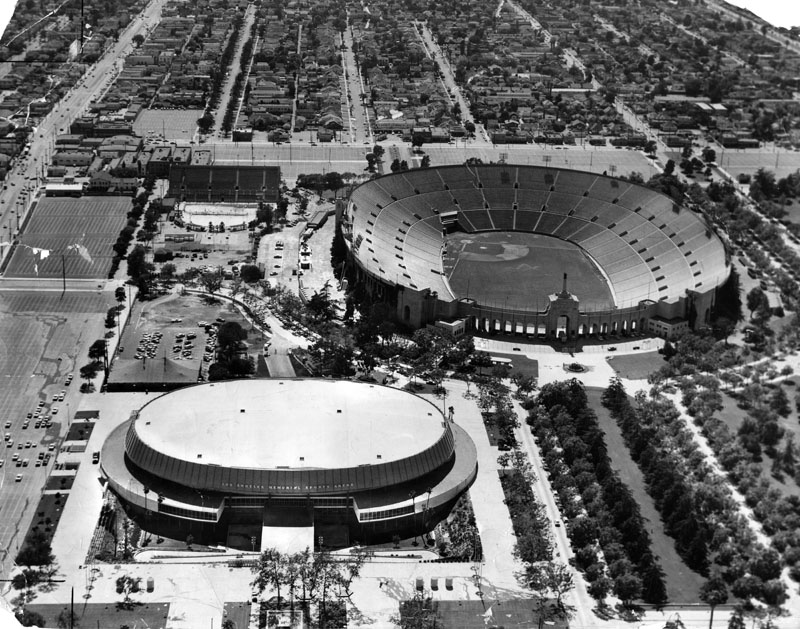 |
|
| (1960)* - Aerial view of both the Los Angeles Memorial Coliseum and adjacent Los Angeles Memorial Sports Arena. The Coliseum was home to the Dodgers between 1958 and 1961. In 1962 the Dodgers would play their first season in a new stadium built just for them - Dodger Stadium. |
Historical Notes The Los Angeles Memorial Coliseum played a pivotal role in Major League Baseball history during the Dodgers' early years in Los Angeles, hosting record-breaking crowds due to its massive capacity of over 90,000 seats. In 1958, the Dodgers attracted more than 1.8 million fans in their first season, with over 90,000 attending each game during the 1959 World Series. Notable events included the 1959 Roy Campanella Night, which set a U.S. baseball attendance record with 93,103 fans, the 1959 All-Star Game, and the Dodgers' first West Coast World Series victory. Although the team moved to Dodger Stadium after 1961, the Coliseum's legacy remains, having hosted some of the largest baseball crowds in history and helping to establish MLB on the West Coast. |
* * * * * |
Dodger Stadium
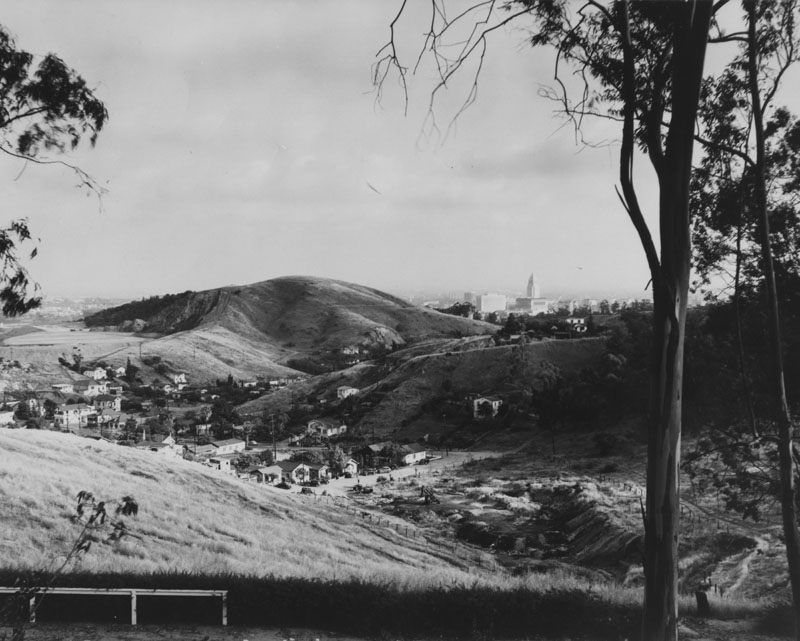 |
|
| (ca. 1952)* - A panoramic view of Chavez Ravine, showing the residential community. The Los Angeles Civic Center is visible in the background. |
Historical Notes The land for Dodger Stadium was purchased from local owners and inhabitants in the early 1950s by the city of Los Angeles using eminent domain with funds from the Federal Housing Act of 1949. The city had planned to develop the Elysian Park Heights public housing project, which included two dozen 13-story buildings and more than 160 two-story townhouses, in addition to newly rebuilt playgrounds and schools. |
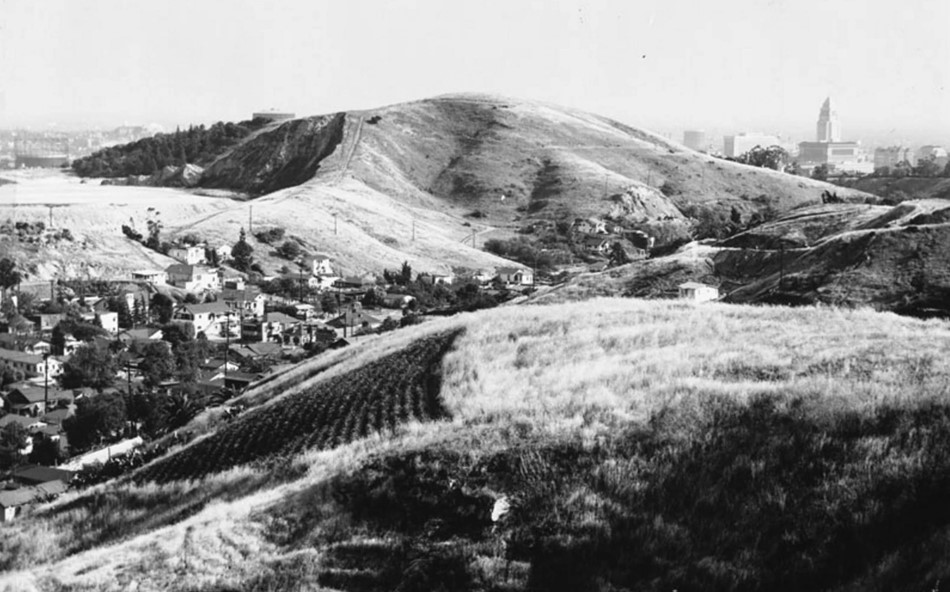 |
|
| (ca. 1952)* - A panoramic view of Chavez Ravine, future site of Dodger Stadium. |
Historical Notes Before construction could begin on the housing project, the local political climate changed greatly when Norris Poulson was elected mayor of Los Angeles in 1953. By then, the proposed public housing projects like Elysian Park Heights lost most of their support. Following protracted negotiations, the city purchased the Chavez Ravine property back from the Federal Housing Authority at a drastically reduced price, with the stipulation that the land be used for a public purpose. It was not until June 3, 1958, when Los Angeles voters approved a "Taxpayers Committee for Yes on Baseball" referendum, that the Dodgers were able to acquire 352 acres of Chavez Ravine from the city. The Chavez Ravine controversy was a significant event in the history of Los Angeles. It was a complex situation that involved urban redevelopment, political maneuvering, and the displacement of an entire community. |
 |
|
| (1957)* - On October 7, 1957, Walter O'Malley announced that he was moving the Dodgers west and that he would build a new stadium on land in Chavez Ravine. Here, a man points out the future location of home plate. The police academy can be seen in the far background. |
Historical Notes In the mid-1950s, Brooklyn Dodger team president Walter O'Malley had tried to build a domed stadium in the New York City borough of Brooklyn, but was unable to reach an agreement with city officials on land acquisition, and eventually reached a deal with the city of Los Angeles. The rest is history. |
Dodgers Move to Los Angeles
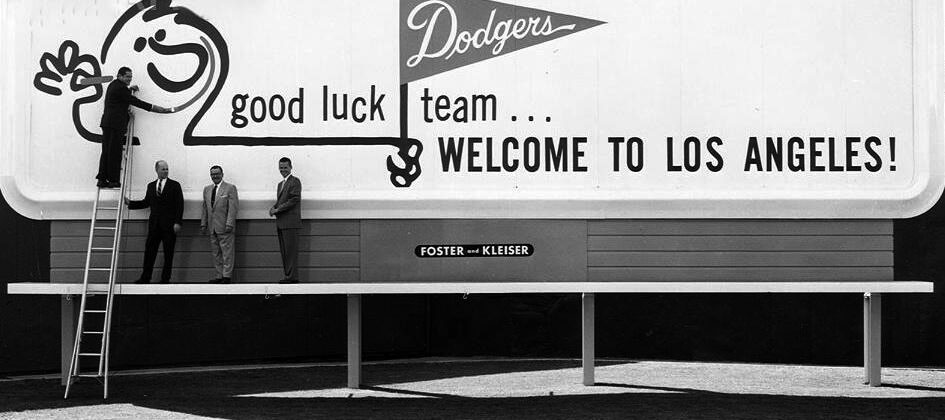 |
|
| (1958)* - A new signboard welcomes the Dodgers to Los Angeles. |
Historical Notes The Brooklyn Dodgers' move to Los Angeles for the 1958 season was a major turning point in Major League Baseball history and part of a wave of team relocations during the 1950s and 1960s. The decision to leave Brooklyn came after years of challenges, including an outdated stadium, Ebbets Field, which lacked parking for the growing number of car-owning fans. Despite being financially successful, Dodgers' owner Walter O'Malley wanted a new stadium but couldn't reach an agreement with New York officials. Instead, he began exploring opportunities in Los Angeles, a city with no MLB team and a booming population. On May 28, 1957, the National League approved the move, along with the New York Giants’ relocation to San Francisco, ensuring both teams would move to California together. The Dodgers officially announced the move on October 8, 1957, and played their first game in Los Angeles on April 18, 1958, drawing a crowd of 78,672 at the Los Angeles Memorial Coliseum. The move was celebrated in Los Angeles as a boost to the local economy, but it left New York fans heartbroken. It also marked the first time Major League Baseball expanded to the West Coast, increasing the league's national presence. |
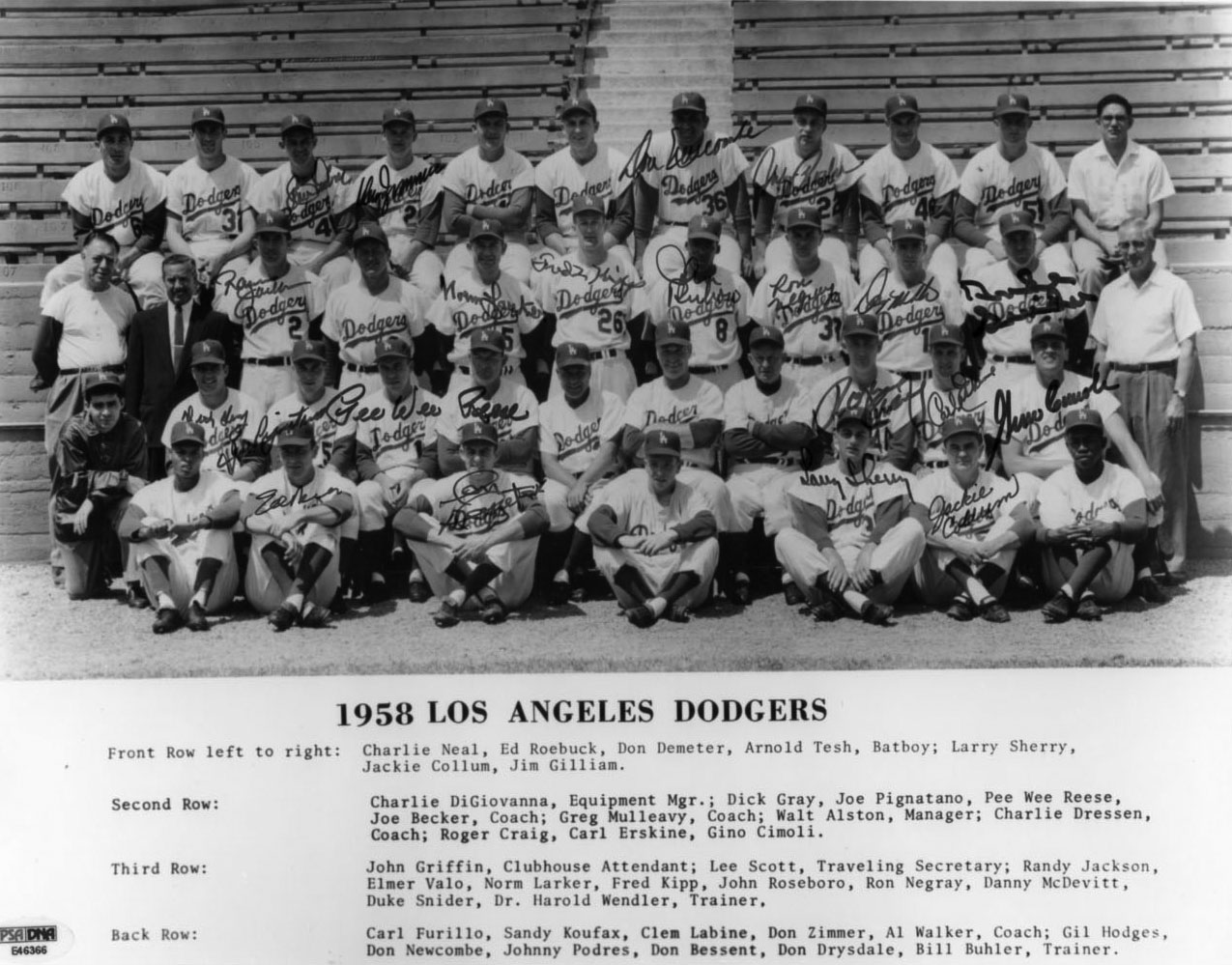 |
|
| (1958)* - Team photo of the new Los Angeles Dodgers, transplanted from Brooklyn. |
Historical Notes While Dodger Stadium was under construction, the Dodgers played in the league's largest capacity venue from 1958 through 1961 at their temporary home, the Los Angeles Memorial Coliseum. Click HERE to see the Dodgers at the Los Angeles Memorial Coliseum. |
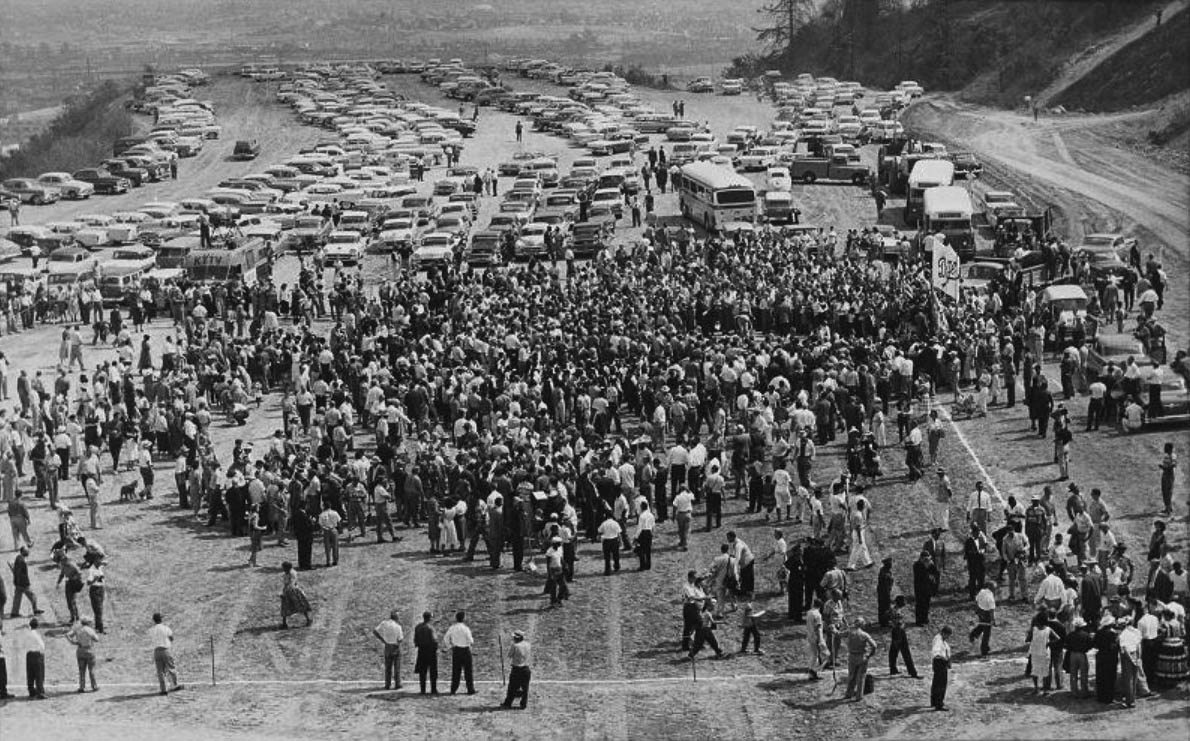 |
|
| (1959)^ – View showing a crowd gathered for the new Dodgers Stadium ground-breaking ceremony in Chavez Ravine, Los Angeles. |
Historical Notes A crowd estimated at more than 5,000 was on hand in the Chavez Ravine section of Los Angeles Sept. 17 as ground was broken for the Los Angeles Dodgers' new $12,000,000 baseball plant. White lines represent the approximate location of the diamond, with the plate at lower right. Dodger players took positions on the diamond, but were quickly swarmed over by autograph seekers. |
 |
|
| (1959)* - Hundreds of onlookers watch bulldozers charging down the hills to begin the massive leveling and grading process for Dodger Stadium. In all, eight million cubic yards of earth were moved to prepare the rugged land for the building of Dodger Stadium. Photo dated: September 17, 1959. |
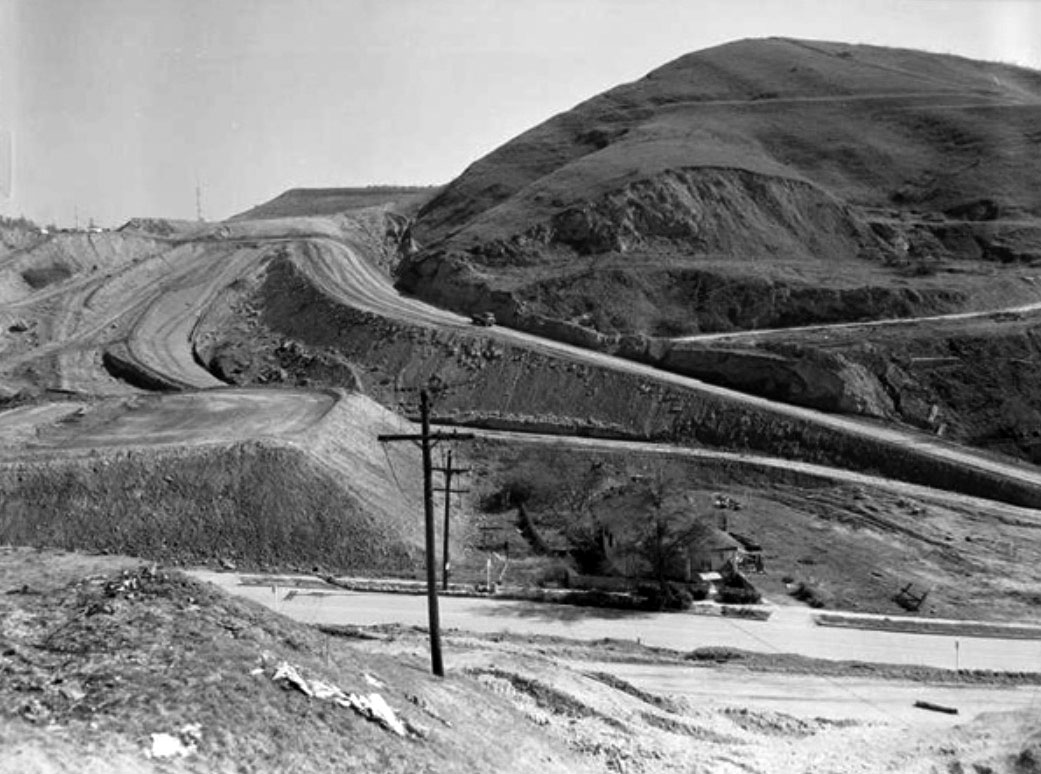 |
|
| (1960 )*^* - Los Angeles Times photo showing a lone house amid construction for Dodger Stadium. |
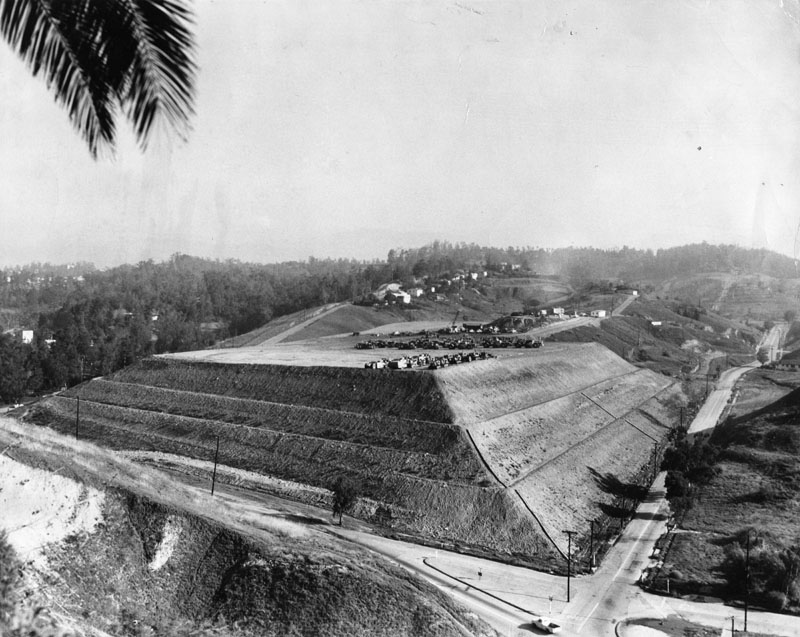 |
|
| (1960)* - Construction of Dodger Stadium, built for $23 million, the first privately financed Major League Baseball stadium since Yankee Stadium was built in the 1920s. According to the Herald-Examiner's Morton Moss, Chavez Ravine had turned into a "vast monument of multi-colored steel concrete and terraced asphalt surrounding a barbered acreage of scalloped greenery." |
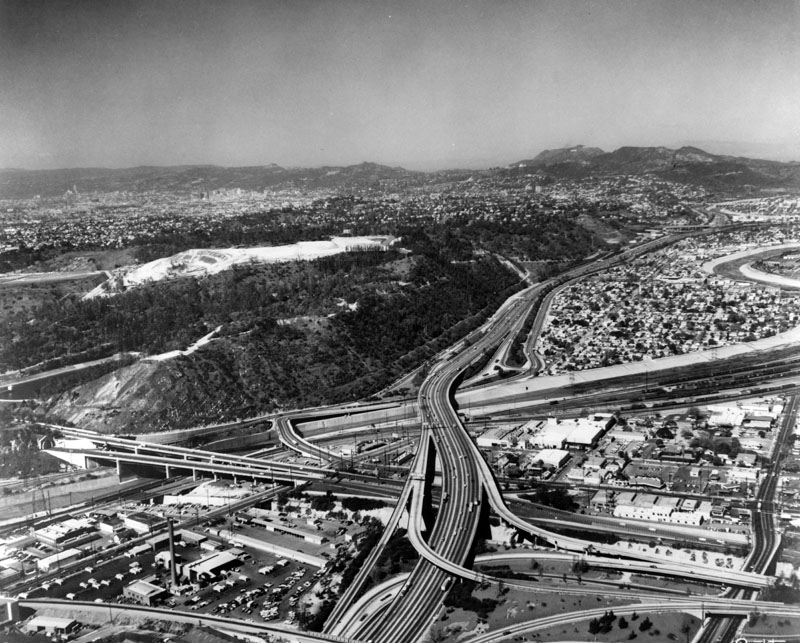 |
|
| (ca. 1960)* - Aerial view of Chávez Ravine (hill on the left) and Dodger Stadium under construction, as well as the numerous freeway "veins" that run through the city of Los Angeles. Hundreds of homes are also visible in the surrounding areas as far as the eye can see. |
 |
|
| (1960)^#^ - Primary grading of Chavez Ravine. LA Times caption reads: “With preliminary grading finished, Dodgers hope to get going on new park sometime in June.” Photo Date: April 12, 1960 |
 |
|
| (1960)^ - Photograph of Chavez Ravine Dodger Stadium excavation. "No action -- legal snarls again stalled construction of Dodger's new baseball park in Chavez Ravine, where idle trucks, bulldozers and earth-movers are pictured late Tuesday" -- Examiner clipping attached to verso, dated, "May 25, 1960". |
Historical Notes In a little less than 31 months, nineteen giant earthmovers relocated eight million cubic yards of earth, flattening hills and filling in gullies across the 300-acre site. At the highest point, a 726-foot promontory variously called Mount Lookout, Silverwood Hill, and O'Malley Hill, they amputated the peak and carved an amphitheater into the mountainside that would serve as the stadium's foundation. |
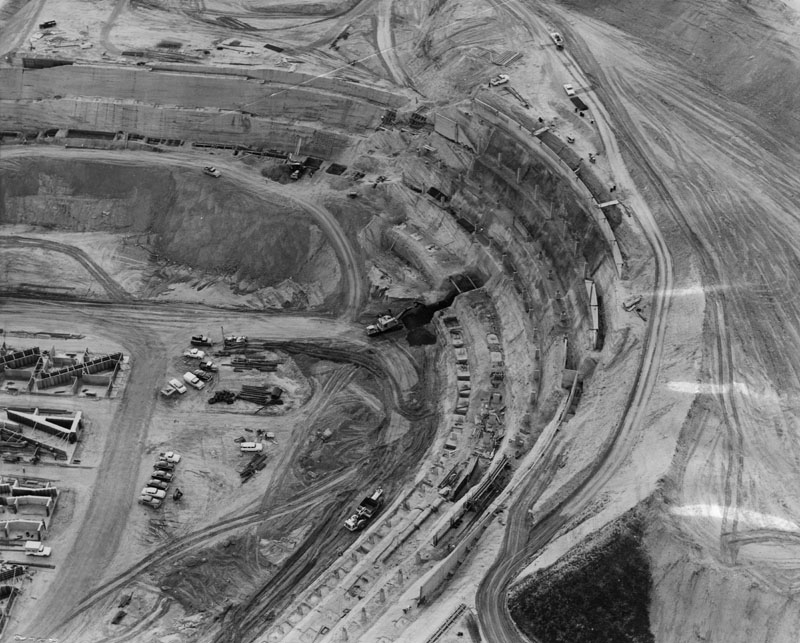 |
|
| (1961)* - Photograph caption dated February 16, 1961 reads, "Dirt tiers will soon support stands for 56,200-seat Dodger Bowl for 1962." |
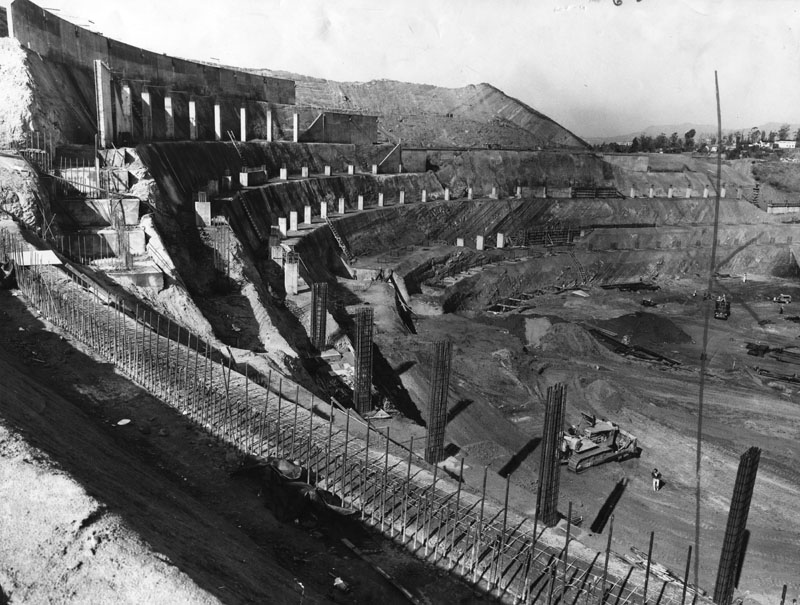 |
|
| (1961)* - Photograph caption reads, "Work ahead of schedule in Chavez Ravine." |
Historical Notes Some 40,000 cubic yards of concrete, including 78 precast frames, and 13 million pounds of reinforcing steel went into building the 124-foot grandstand. |
 |
|
| (1961)* - Dodger Stadium under construction. |
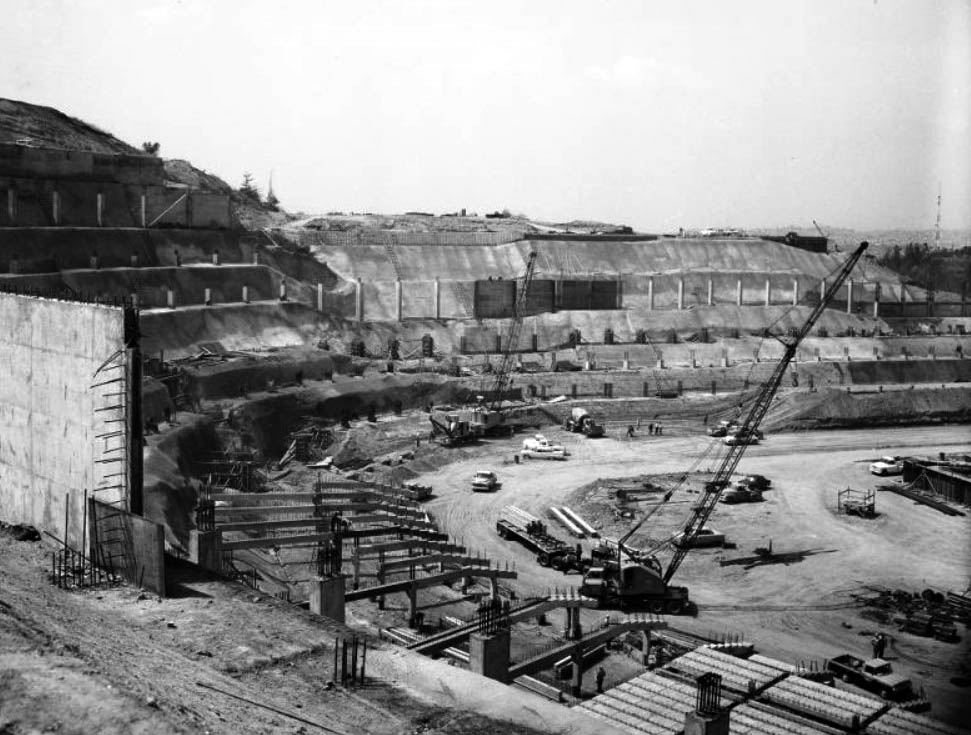 |
|
| (1961)^ – View showing Dodger Stadium under construction. Photo Date: April 7, 1961 |
Historical Notes Because the largest precast pieces were too big to move by truck, a six-acre casting yard was built on the site. To assemble the pieces, the contractor imported a $150,000 crane from Germany that was then was the largest in North America. |
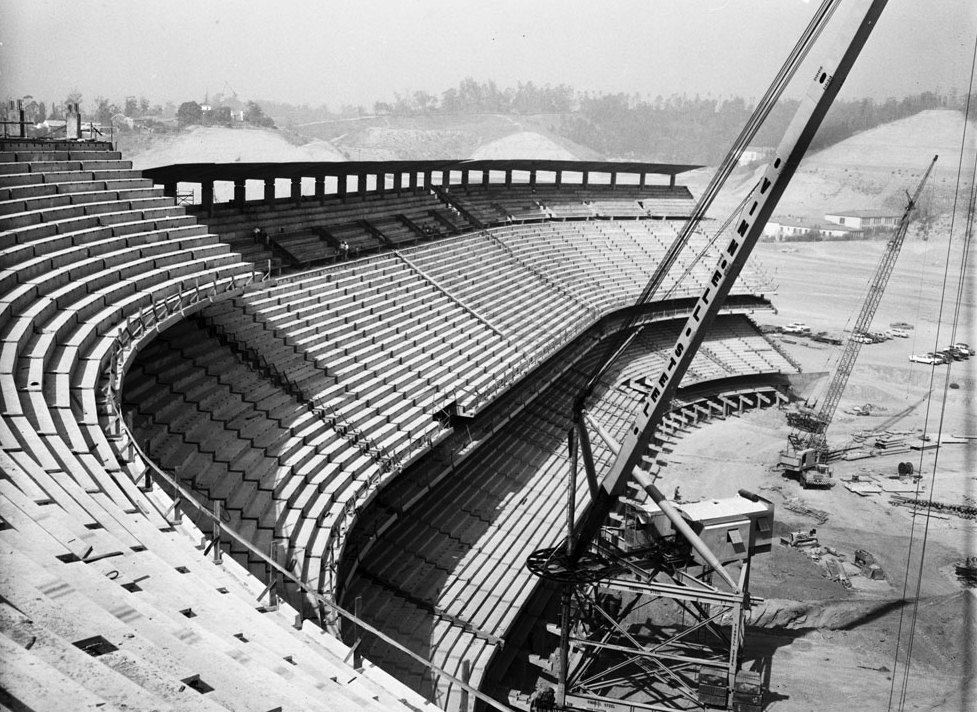 |
|
| (1961)^ - Pan shot of ball park starting to take shape. Note the extra-large crane in the foreground. |
Historical Notes The grandstand's cantilevered design meant that each spectator enjoyed an unobstructed view of the action—a departure from older stadium designs that placed support structures between fans and the field. |
 |
|
| (ca. 1961)* - Aerial view of downtown Los Angeles, showing Dodger Stadium during the final stages of its construction in the foreground. |
Historical Notes At the project's peak, there were 342 construction workers on the site. Total costs ran close to $23 million, including $4.47 million in city and county subsidies. |
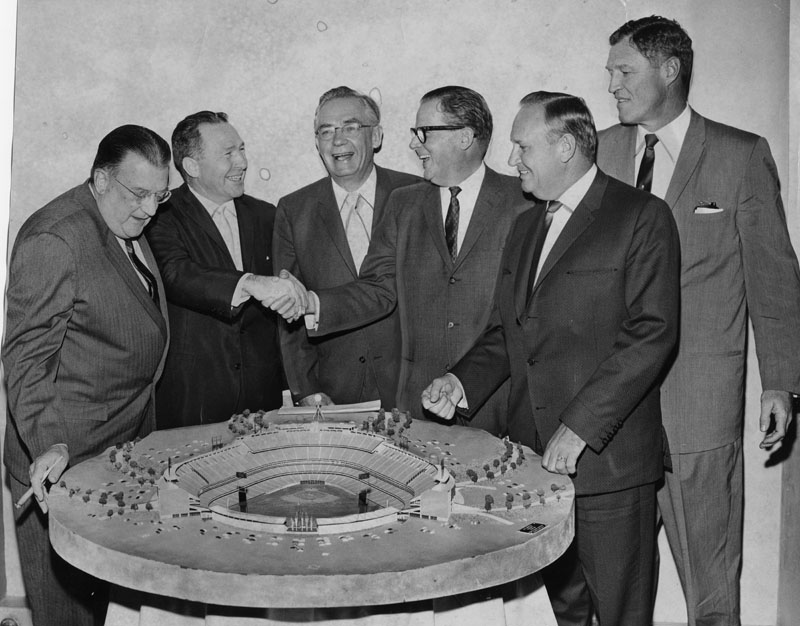 |
|
| (1961)* - Photograph caption dated December 12, 1961 reads, "Plans were revealed yesterday for a gigantic civic celebration in conjunction with the opening of the new Dodger Stadium next April. Shown admiring the model of the baseball showplace are: Walter O'Malley, Dodger president; Mayor Sam Yorty; H.C. McClellan, chairman of the dedication committee; ex-mayor Norris Poulson; Gene Autry, Angel owner; and Bob Reynolds, Angel president." |
 |
|
| (1962)* - Dodger Stadium nearing completion. Work is being finished on the tiered parking lot that surrounds the stadium. |
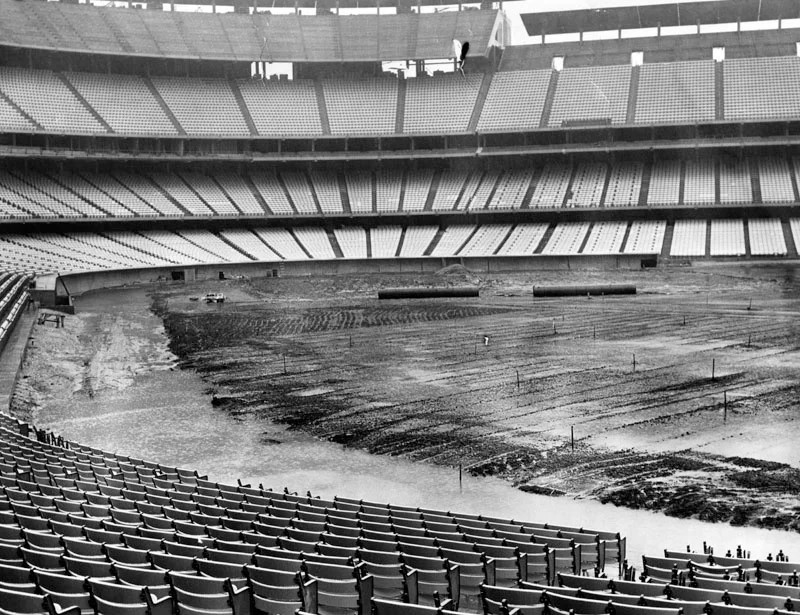 |
|
| (1962)* - Spring storms delayed the completion of work on Dodger Stadium's field, seen here on February 23, 1962. |
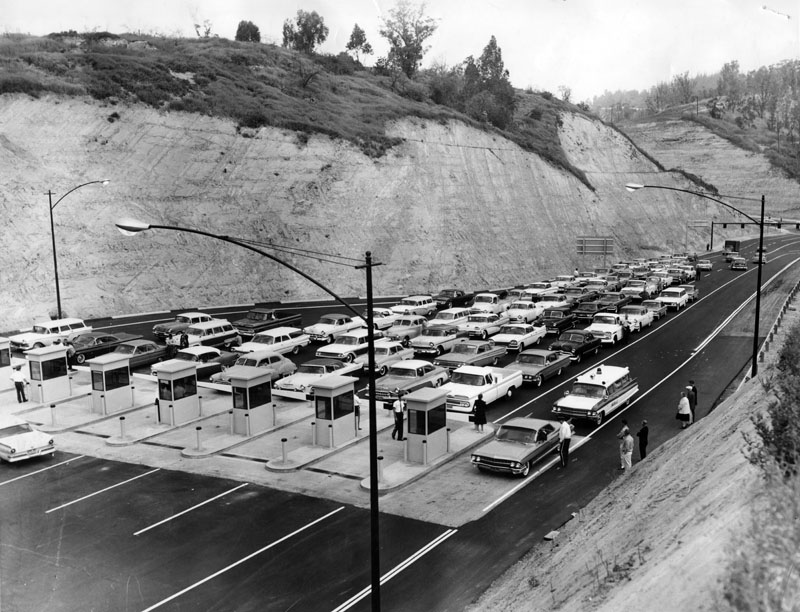 |
|
| (1962)* - Photograph caption dated April 10, 1962 reads, "No, this isn't an on-ramp to a toll road. Nor is it a traffic jam. It's an auto lineup of anxious baseball fans waiting at Solano Street entrance to new Dodger Stadium today. Note ambulance waiting in extreme right lane of photo. Solano entrance is one of five access roads busy early today routing 56,000 fans making beeline to Dodger opener in $18 million stadium." |
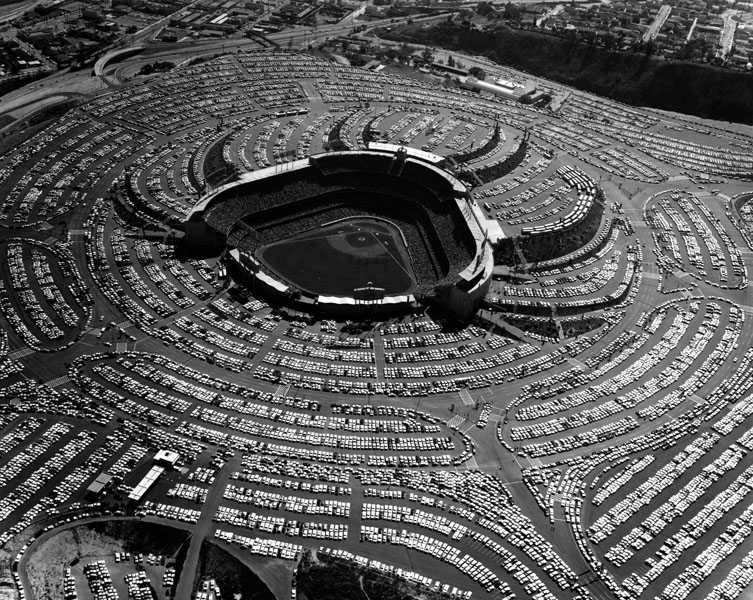 |
|
| (1960s)* - Aerial view of Dodger Stadium and parking lot filled to capacity. |
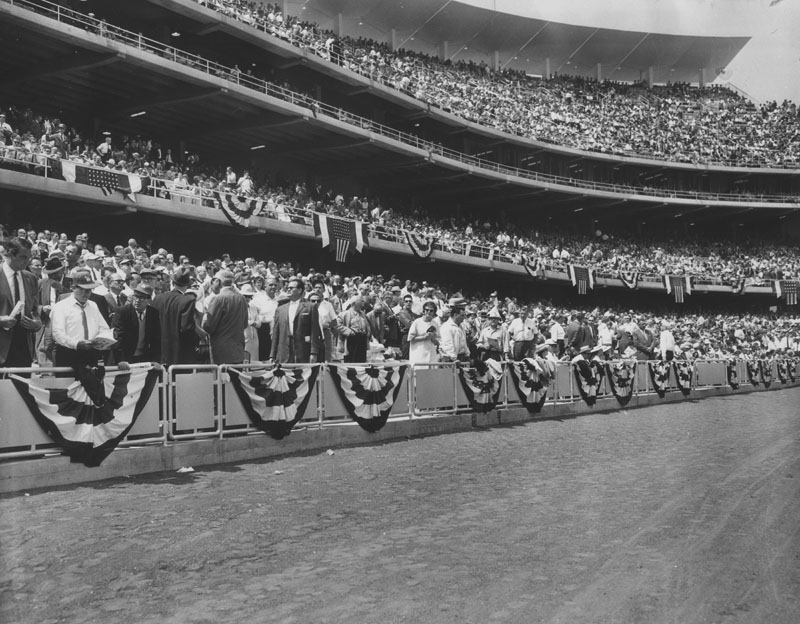 |
|
| (1962)* - Opening Day: April 10, 1962. Fans lined up to see the new ballpark, then awaited the first pitch. The Dodgers lost, 6-3, to the Cincinnati Reds, the defending National League champs, before 52,564 fans. That year, the Dodgers drew 2.7 million fans, the most in baseball history to that point. |
 |
|
| (ca. 1959)* - Sportscasters Jerry Doggett (left) and Vin Scully doing their thing. |
Historical Notes Jerry Doggett broadcast Dodgers games from 1956-1987; Vin Scully has been broadcasting the games since 1950. |
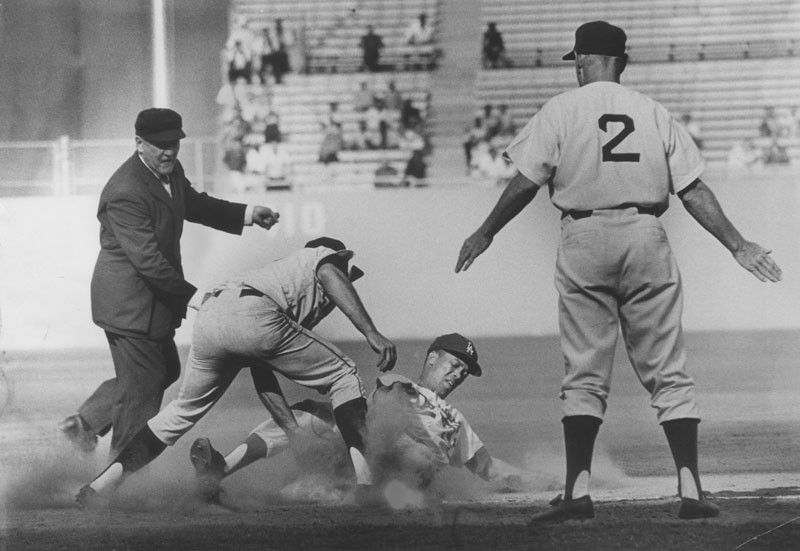 |
|
| (1962)* - During the Dodgers' first years in L.A., shortstop Maury Wills sparked the team's meager offense. Wills led the National League in stolen bases from 1960-1966, and shattered Ty Cobb's 47-year-old record of 97 stolen bases by swiping 104 in 1962. Despite the fact that L.A. lost its lead over the rival Giants in the 1962 pennant race, Wills won MVP. |
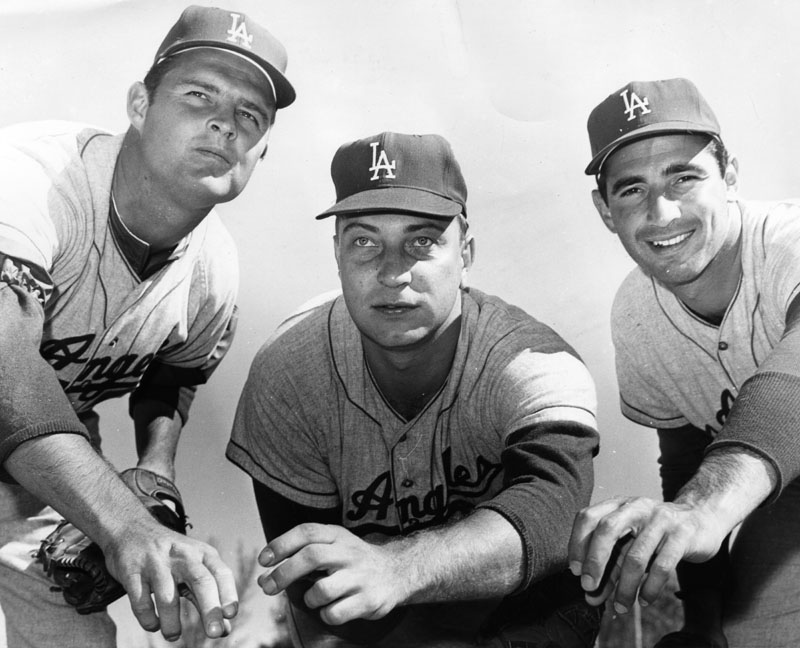 |
|
| (1963)* - Dodger pitchers, from left: right-hander, Don Drysdale; and left-handers, Johnny Podres and Sandy Koufax. Photo dated: March 13, 1963. |
Historical Notes They were the most dominating 1-2 pitching punch in Los Angeles history, combining during a five-year period from 1962-66 for 209 regular-season victories, 53 shutouts and four Cy Young Awards. And they only pitched for the Dodgers and manager Walter Alston, two of many parallels to the respective careers of Hall of Famers Sandy Koufax and Don Drysdale. Johnny Podres spent most of his career with the Brooklyn and Los Angeles Dodgers. He is perhaps best remembered for being named the Most Valuable Player of the 1955 World Series, pitching a shutout in Game 7 against the New York Yankees to help bring the Dodgers their only World Series title in Brooklyn before their move to Los Angeles after the 1957 season. |
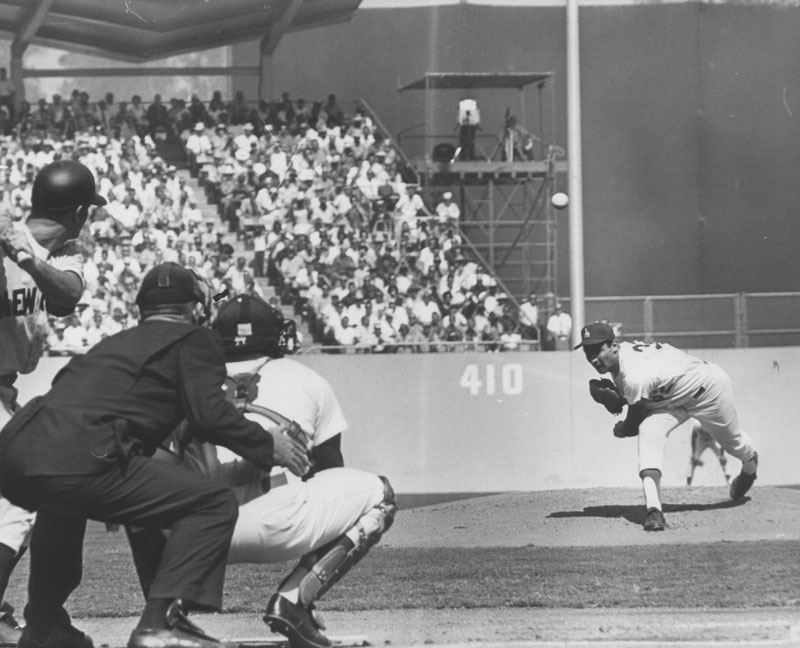 |
|
| (1963)* - Sandy Koufax pitching in Game 4 of the 1963 World Series against the Yankees. The date of that game was Oct. 6, 1963. Photo: Los Angeles Dodgers |
Historical Notes Like Drysdale, Sandy Koufax began his career in Brooklyn. Like Drysdale, he came into his own in L.A. And, like Drysdale, he retired because of an arm injury. Beginning in 1961, Koufax won 25 or more games three times and led L.A. to three World Series titles. One of the few elite Jewish athletes, he refused to pitch the opening game of the 1965 World Series because it fell on Yom Kippur. With the Series tied at 3-3, Koufax pitched the seventh and deciding game on two days rest--and beat the Minnesota Twins, 2-0. The "Left Hand of God," indeed. Koufax's career peaked with a run of six outstanding seasons from 1961 to 1966, before arthritis in his left elbow ended his career prematurely at age 30. He was named the National League's Most Valuable Player in 1963. He also won the 1963, 1965, and 1966 Cy Young Awards by unanimous votes, making him the first 3-time Cy Young winner in baseball history and the only one to win 3 times when the award was for all of baseball, not just one league. In each of his Cy Young seasons, Koufax won the pitcher's triple crown by leading the NL in wins, strikeouts, and earned run average. Koufax's totals would also have led the American League in those seasons. Koufax was the first major leaguer to pitch four no-hitters (including the eighth perfect game in baseball history). Despite his comparatively short career, Koufax's 2,396 career strikeouts ranked 7th in history as of his retirement, trailing only Warren Spahn (2,583) among left-handers. Koufax and Nolan Ryan are the only two pitchers inducted into the Hall of Fame who had more strikeouts than innings pitched. |
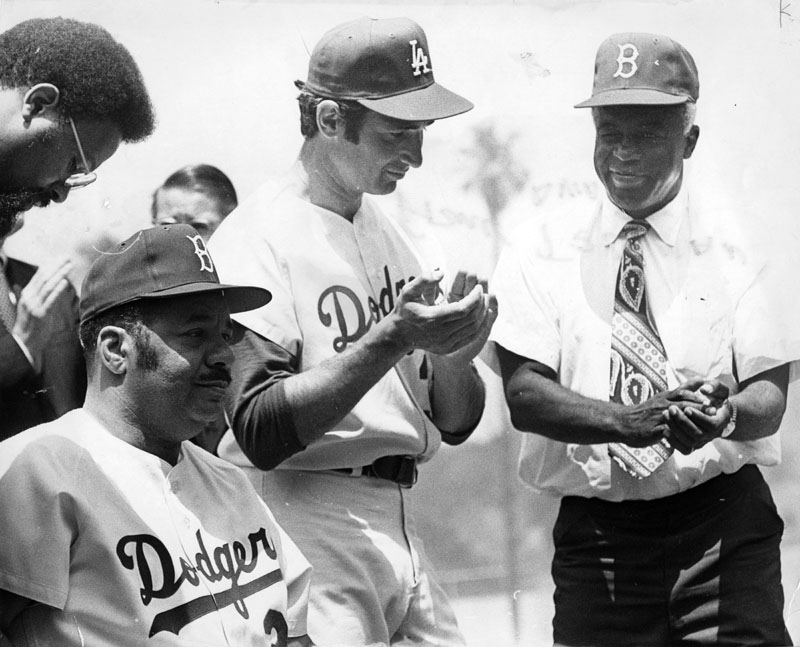 |
|
| (1972)* - Photograph caption reads: "Two stars from Brooklyn flank great one from Los Angeles, as Roy Campanella (left), Sandy Koufax (center) and Jackie Robinson get together." Photograph dated June 5, 1972. |
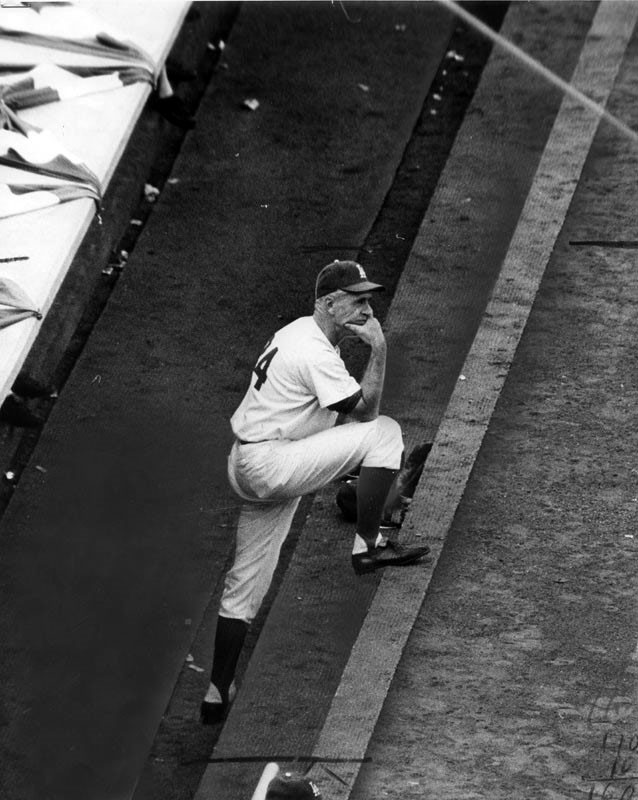 |
|
| (1966)* – View showing Walter Alston looking on from the dugout. |
Historical Notes When the Dodgers hired manager Walter Alston before the 1954 season, he signed a one-year contract. Some 23 year later, he continued to labor under those terms. Alston won four World Series and over 2,000 games before being replaced by Tommy Lasorda before the 1977 season. He died in 1984. |
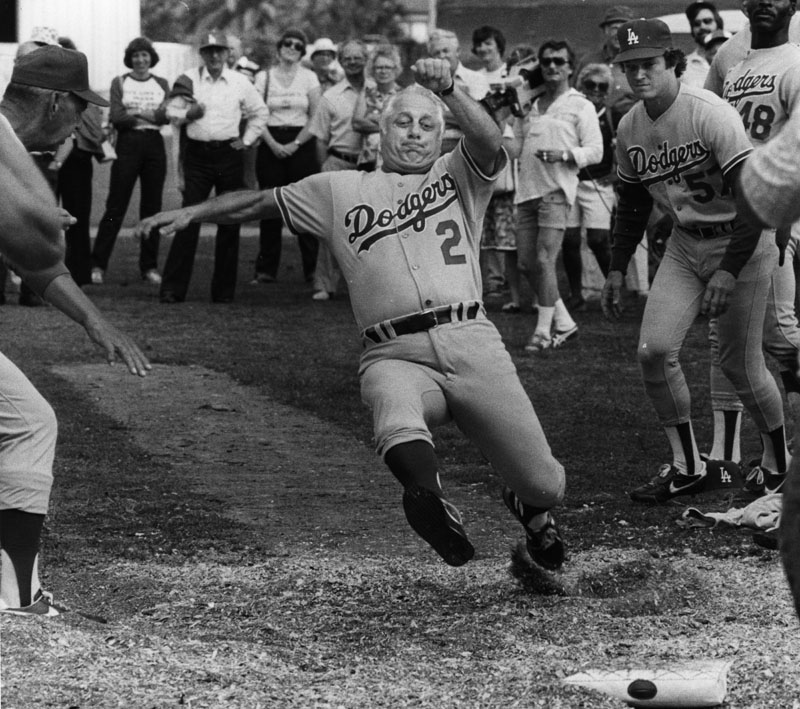 |
|
| (n.d.)* - Dodger players and onlookers in background, watch as Tommy Lasorda slides into base bag. |
Historical Notes Tommy Lasorda's first off-field assignment with the Dodgers was as a scout from 1961 to 1965. In 1966, he became the manager for the Pocatello Chiefs in the rookie leagues, then managed the Ogden Dodgers to three Pioneer League championships from 1966–68. He became the Dodgers AAA Pacific Coast League manager in 1969 with the Spokane Indians (1969–71) and remained in the position when the Dodgers switched their AAA farm club to the Albuquerque Dukes (1972). His 1972 Dukes team won the PCL Championship. Lasorda was also a manager for the Dominican Winter Baseball League team Tigres del Licey (Licey Tigers). He led the team to the 1973 Caribbean World Series Title in Venezuela with a series record of 5 wins and 1 loss. In 1973, Lasorda became the third-base coach on the staff of Hall of Fame manager Walter Alston, serving for almost four seasons. He was widely regarded as Alston's heir apparent, and turned down several major league managing jobs elsewhere to remain in the Dodger fold. |
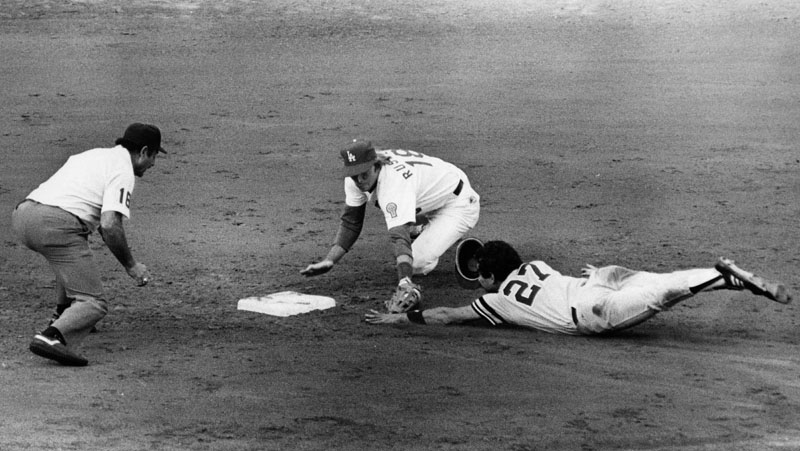 |
|
| (n.d.)* - Runner tries to stretch his hand towards base as Dodger Bill Russell makes the tag on his left hand. Umpire standing on left calls "out". |
Historical Notes Bill Russell played his entire 18-year, 2,181-game career with the Los Angeles Dodgers as the starting shortstop for four National League pennant winners and one World Series champion. He also served as the team's manager from 1996 to 1998. |
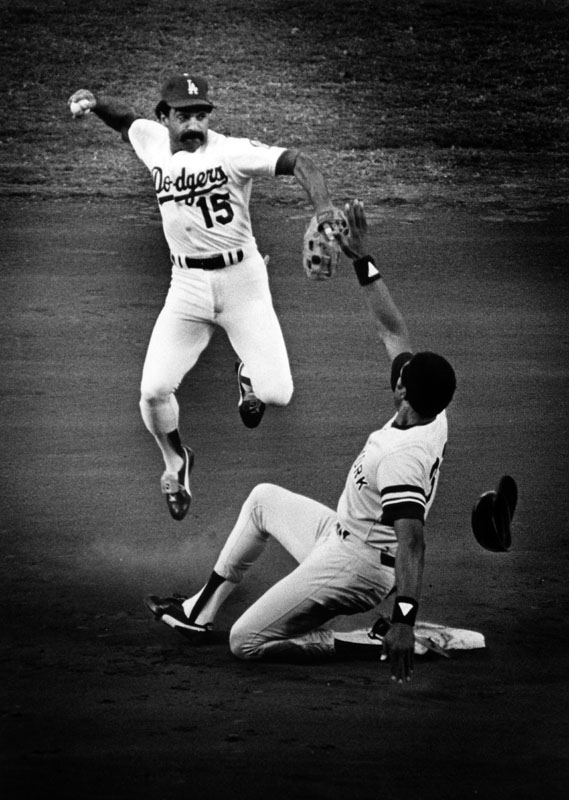 |
|
| (n.d.)* - Davey Lopes turns a double play in the first inning of the Dogers vs Yankees game. |
Historical Notes Lopes spent nine seasons with the Los Angeles Dodgers as their regular second baseman. Along with Steve Garvey (1B), Bill Russell (SS) and Ron Cey (3B), they formed the longest running infield in baseball history, which stayed together for eight and a half seasons. |
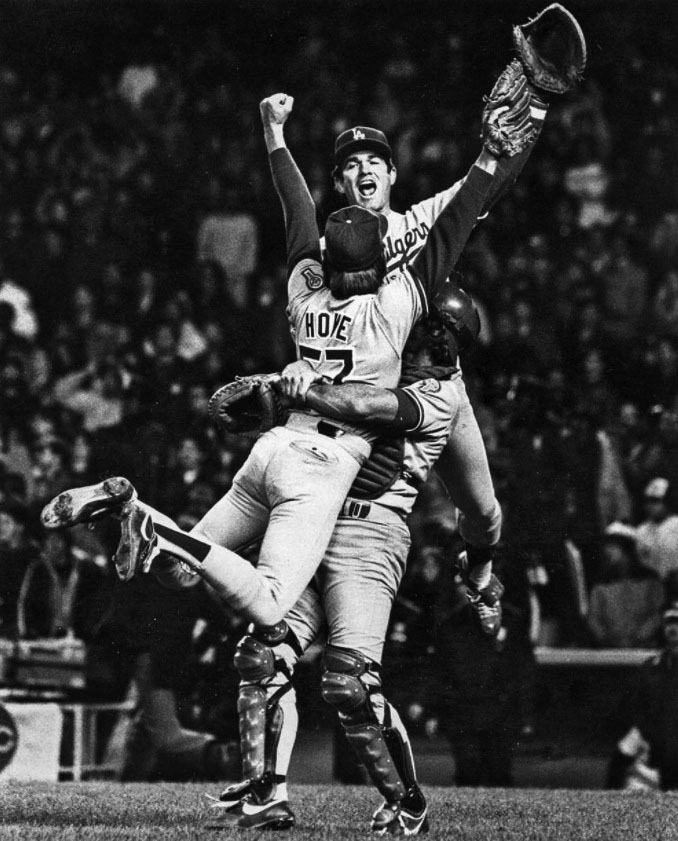 |
|
| (1981)* - Dodgers’ Steve Garvey, Steve Howe and Steve Yeager celebrate winning the World Series. Los Angeles beat the New York Yankees in six games. Los Angeles Times: Framwork |
Historical Notes A page one story in the Oct. 29, 1981, Los Angeles Times reported: Pedro Guerrero drove in five runs with a home run, triple and single and the Dodgers climaxed a remarkable series of playoff comebacks Wednesday night by routing the New York Yankees, 9-2, to win the 78th World Series at Yankee Stadium. It was the fourth straight victory for the Dodgers after they had dropped the first two games at Yankee Stadium. Previously they had come from an 0-2 deficit to beat the Houston Astros, 3-2 in the National League West divisional playoffs and had overcome Montreal, 3-2, after trailing 1-2, in the NL championship playoffs. The result was the exact reversal of the 1978 World Series, when the Yankees lost the first two games at Dodger Stadium, then won the next four. The victory gave Los Angeles its fourth world championship and its first since 1965 when they beat the Minnesota Twins. Previously, they won championships in 1959 over the Chicago White Sox and in 1963 over the Yankees. |
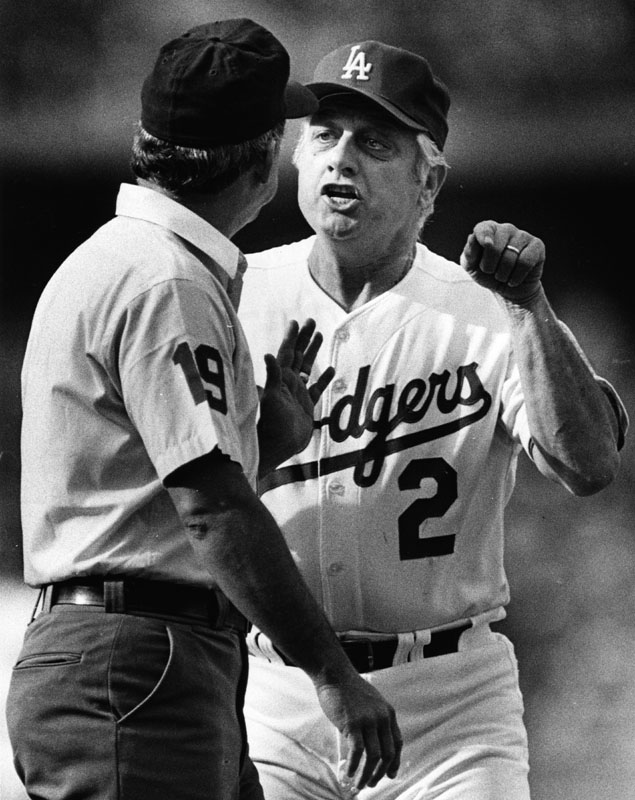 |
|
| (n.d.)* - Dodger manager Tommy Lasorda argues his point with base umpire. |
Historical Notes In 2009, Tommy Lasorda marked his sixth decade in one capacity or another with the Brooklyn/Los Angeles Dodgers organization, the longest non-continuous (he played one season with the Kansas City Athletics) tenure anyone has had with the team, edging Dodger broadcaster Vin Scully by a single season. He was inducted into the National Baseball Hall of Fame as a manager in 1997. |
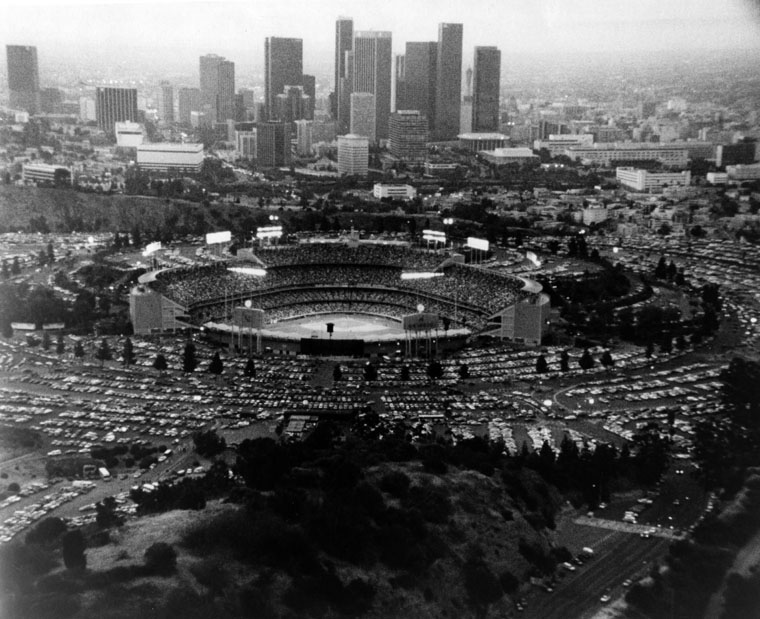 |
|
| (n.d.)* - Aerial view of a packed Dodger Stadium with the tall buildings of the city as a backdrop. Rows upon rows of cars are parked around the stadium and crowds of people fill the bleachers. |
Historical Notes Dodger Stadium is currently the third oldest ballpark in Major League Baseball (behind Fenway Park in Boston and Wrigley Field in Chicago) and is the largest ballpark by seating capacity. It has always held 56,000 fans, due to a conditional-use permit limiting its capacity. Every time the Dodgers add seats, they always remove an equal number of seats in the upper deck or in the pavilion to keep the capacity the same. |
 |
|
| (1962)* - Photograph of Dodger Stadium in Chavez Ravine at night, June 1, 1962. The stadium seems to be empty while cars in the parking lot surrounding the stadium sit waiting to leave. |
 |
|
| (1960s)* - Traffic going into Dodger Stadium. |
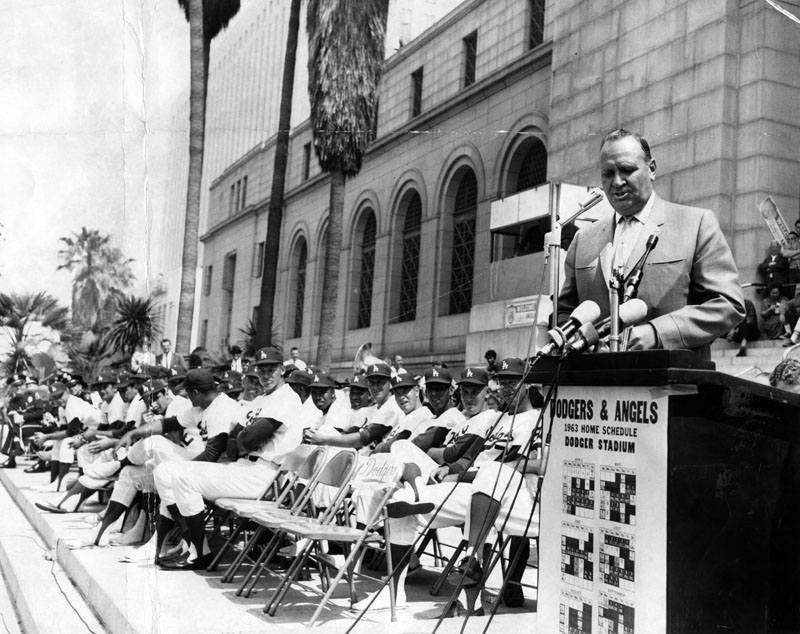 |
|
| (1963)* - Photograph caption dated April 6, 1963 reads, "Gene Autry, co-owner of the Angels, speaks a few words at City Hall ceremonies for the Angels and Dodgers." The Angels would be renting space at Dodger Stadium over the next four seasons until construction of their new stadium was completed in 1966. |
* * * * * |
Angel Stadium of Anaheim (originally known as Anaheim Stadium and later Edison International Field)
The Los Angeles Angels, originally the California Angels, have a rich history that began in 1961. The team has undergone several name changes and has seen many ups and downs, including a World Series victory in 2002. Angel Stadium, their home since 1966, is a historic venue that has hosted numerous significant events and has undergone several renovations to maintain its status as a premier baseball facility.
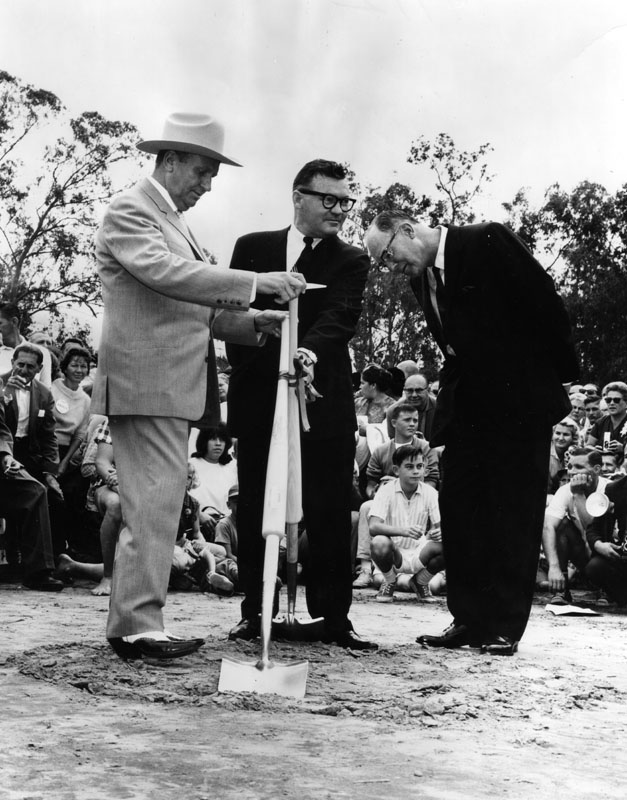 |
|
| (1964)* - The historic groundbreaking for Anaheim Stadium with Angels and City of Anaheim officials and large turnout of fans on hand, August 30, 1966. Participating in two-shovel ceremonies were, from left, Angels Chairman of the Board, Gene Autry, Anaheim's then Mayor Odra Chandler and Conractor Del Webb. The shovels had baseball bat handles. |
Historical Notes Work began almost as soon as the groundbreaking ceremony adjourned. Contractor Del E. Webb, who happened to own part of the New York Yankees, had pledged to complete the $15.8 million stadium by the opening day of the 1966 season. |
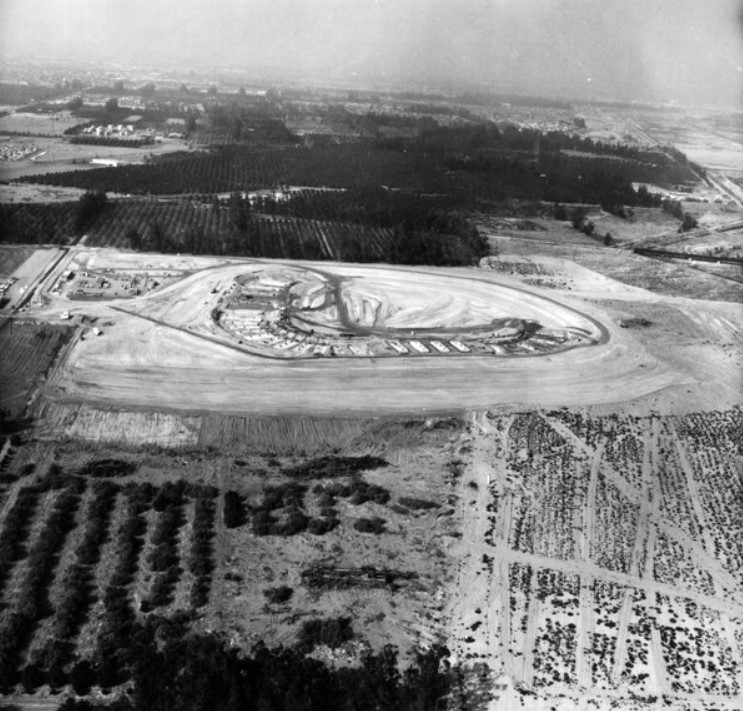 |
|
| (ca. 1964)* - Aerial view of the Anaheim Stadium site post-groundbreaking, but prior to construction, image shows view looking north, with orange groves in foreground and background. |
Historical Notes The stadium was built on a parcel of about 160 acres of flat land originally used for agricultural purposes in the southeast portion of Anaheim. |
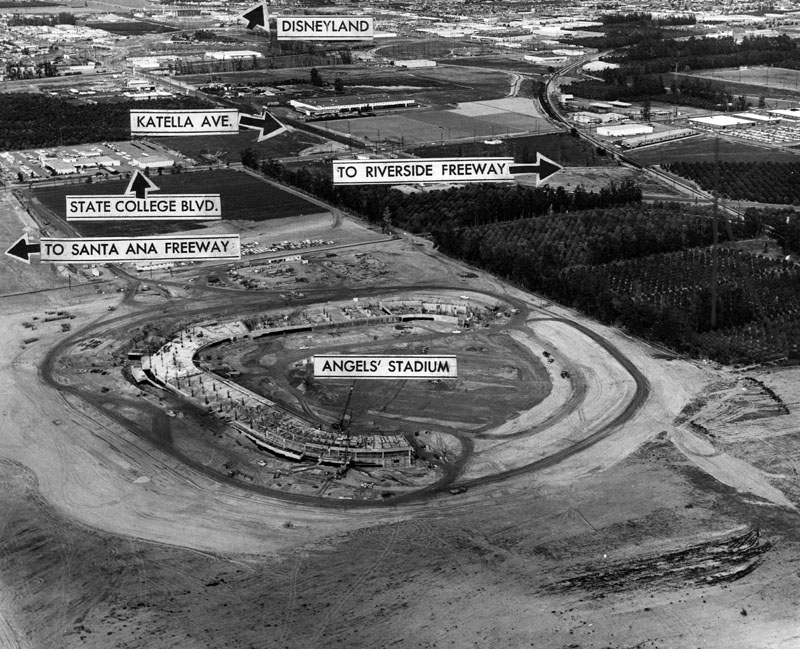 |
|
| (1965)* - Aerial view of the Anaheim Stadium construction site from February 1965 with landmarks labeled. |
Historical Notes Consistent with many major-league sports stadiums built in the 1960s, Anaheim Stadium is located in a suburban area, though one that is host to major tourist attractions. |
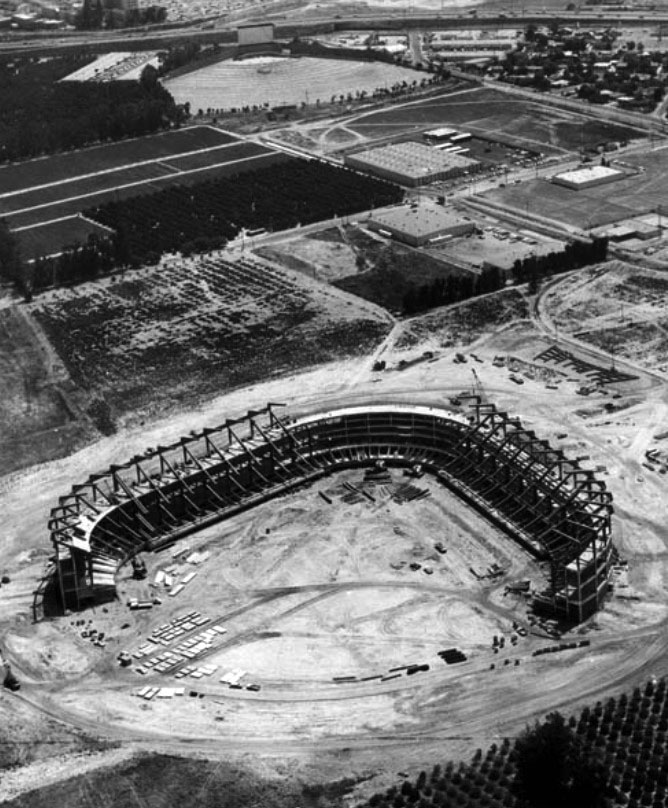 |
|
| (1965)* – Aerial view showing the framework of the new stadium at Anaheim. At the top of photo is the Santa Ana Freeway with Orange Drive-in Theatre at top-center. Photo date: June 11, 1965 - LA Times - Framework |
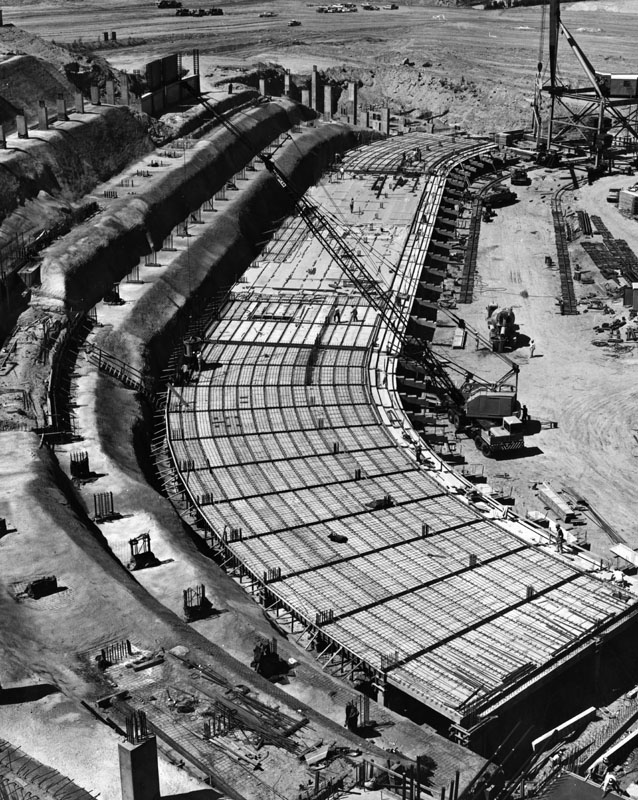 |
|
| (1965)* - View of a crane at work during the construction of the new Angel Stadium in Anaheim |
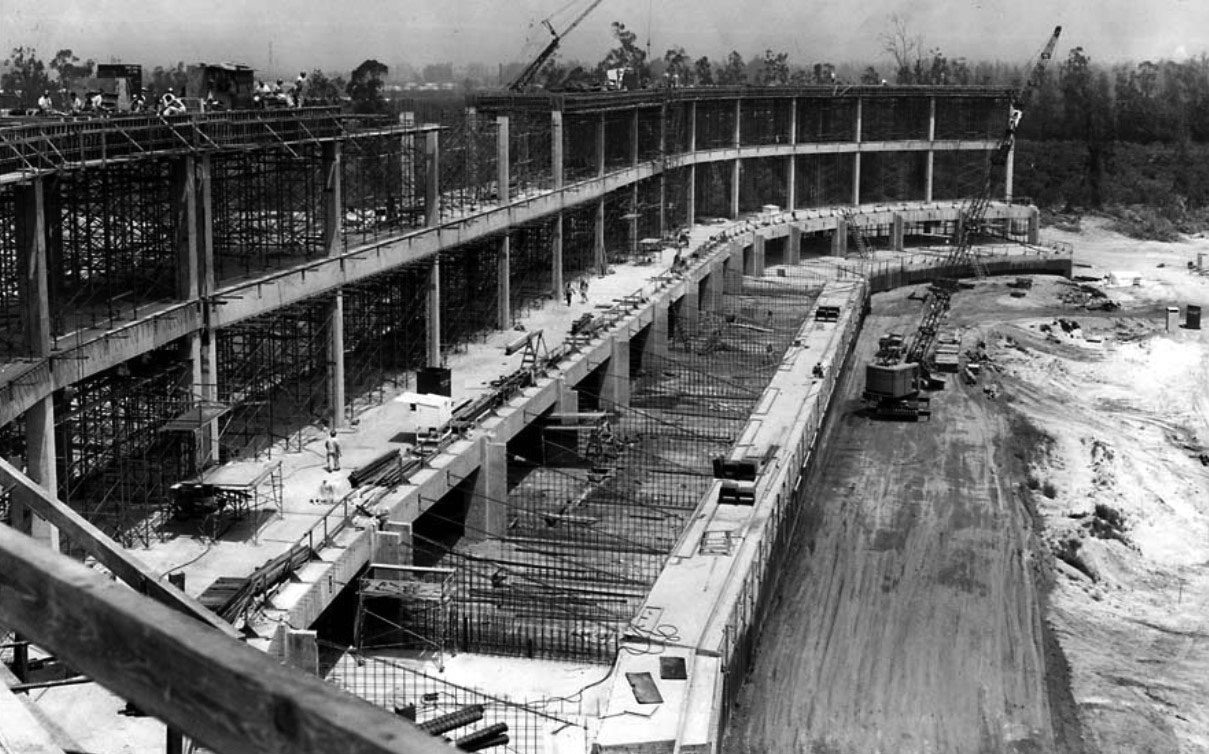 |
|
| (1965)* – Concrete is being poured during construction of Anaheim Stadium. The stadium was 21% completed when this image was taken on April 23, 1965. LA Times - Framework |
Historical Notes Over a 20 month construction period, Del Webb's construction workers poured 42,000 cubic yards of concrete, laid 7 million pounds of reinforcing steel and 8 million pounds of structure steel, and installed 1,900 light bulbs. |
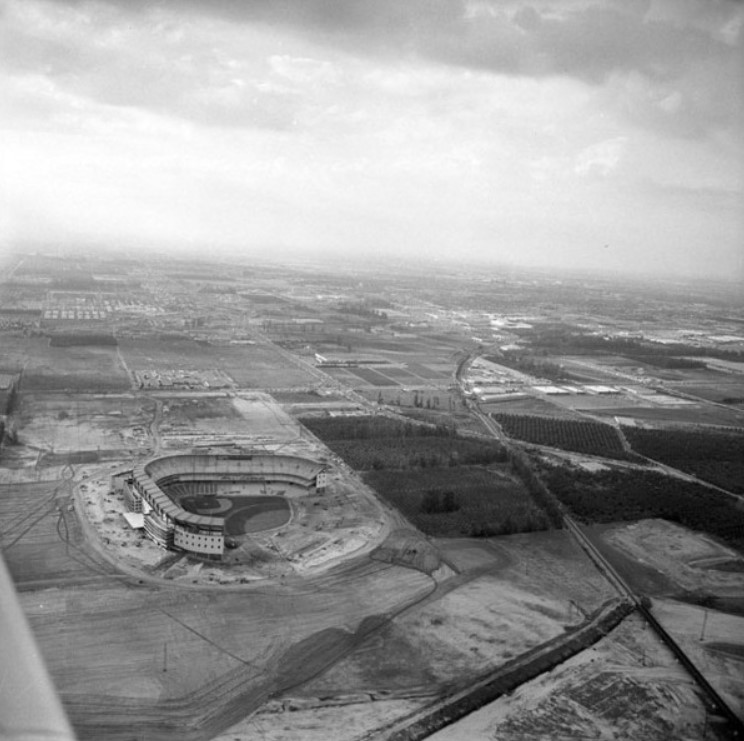 |
|
| (1966)* - Anaheim Stadium rises from a former cornfield in Anaheim. Courtesy of the Los Angeles Times Photographic Archive, UCLA Library. Used under a Creative Commons license. |
Historical Notes The stadium was built on a parcel of about 160 acres of flat land originally used for agricultural purposes by the Allec, Russell, and Knutzen families in the southeast portion of Anaheim. |
 |
|
| (ca. 1966)* - Aerial view of the construction of the new Angel Stadium in Anaheim. Note the stadium lights laying in the foreground waiting to be installled. |
Historical Notes The field dimensions (333 feet instead of 347 or 350, for example) were derived from a scientific study conducted by the Angels. Based on the air density at normal game times (1:30 pm and 8 pm), the Angels tried to formulate dimensions that were fairly balanced between pitcher, hitter and average weather conditions. The Angels tinkered with those dimensions several times, expanding or contracting parts of the outfield by a few feet here and there, to try to refine that balance. 396 feet is the shortest center-field in the American League, and tied for 2nd-shortest in the major leagues with Petco Park behind only Dodger Stadium's 395 feet. |
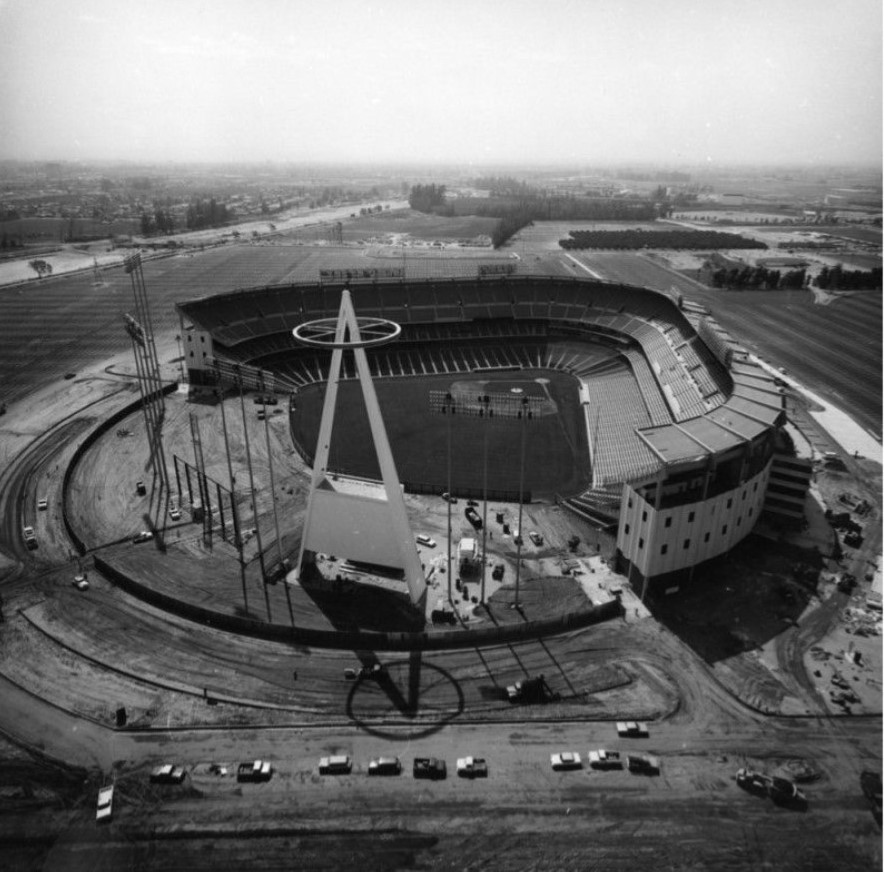 |
|
| (1966)* - View showing the Big A Socreboard during its unveiling. |
Historical Notes The Big A 230-foot high scoreboard support cost $1 million and was unveiled in 1966. It was moved to the parking lot in 1980. |
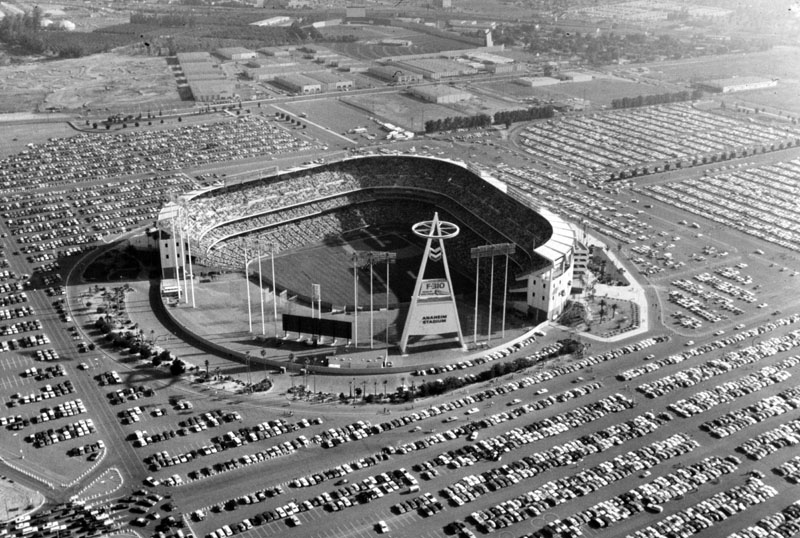 |
|
| (1960s)* - One of the first games to be played at Anaheim Stadium (later known as Angel Stadium). Nothing caught the eye as much as the Big A: a 230-foot-tall A-shaped scoreboard that stood just behind the outfield fence. Naturally, a halo topped the structure. |
Historical Notes Angel Stadium, the fourth oldest active Major League Baseball stadium, was selected to host the 2010 Major League Baseball All-Star Game. The stadium also houses the studios and offices of the Angels' owned and operated flagship radio station, KLAA (830 AM). |
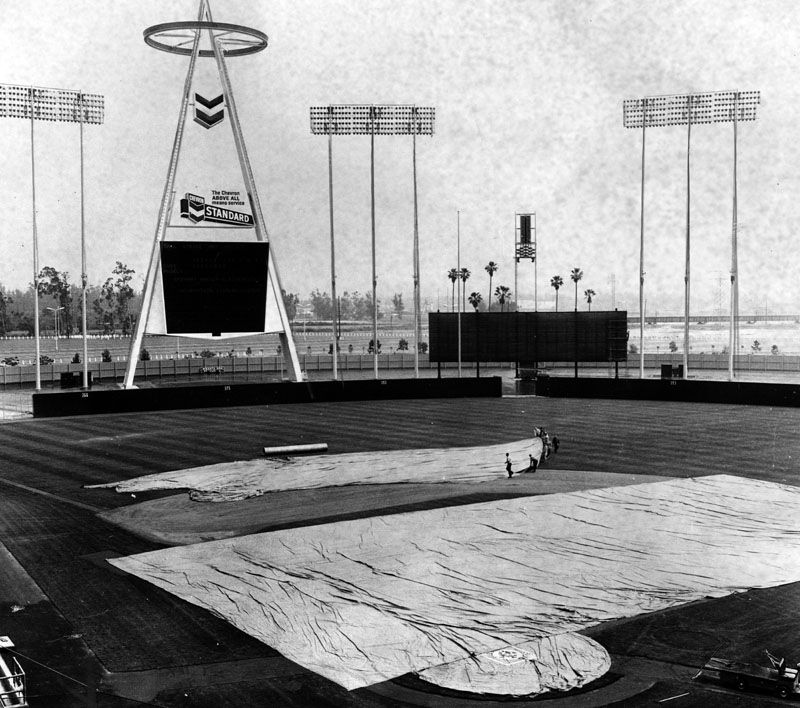 |
|
| (1967)* - View of the outfield and the Big A scoreboard at a rain-delayed game. Note that the stadium originally featured no bleachers or grandstands beyond the outfield. |
Historical Notes The design of the stadium was very similar to the popular Dodger Stadium, but without the outfield seats. Outfield bleacher seats were not in demand, Anaheim being in Orange County did not fit the image of the traditional bleacher bum. So no changes were necessary for this relatively new stadium. However, a new tenant wanted to move in, the Los Angeles Rams, and changes would be required to make this a multi-purpose stadium. Anaheim Stadium became a multi-purpose stadium between 1980 and 1996. When the deal was complete to bring the NFL Los Angeles Rams to Anaheim, major changes were needed. The stadium needed to become enclosed. Enclosing the stadium angered the baseball fans. By building grand stands in the outfield, the views of the mountains and infamous Big A scoreboard were going to be lost. The Big A scoreboard was moved to the parking lot. The additional stands increased the size of the stadium from 43,000 to 65,000. |
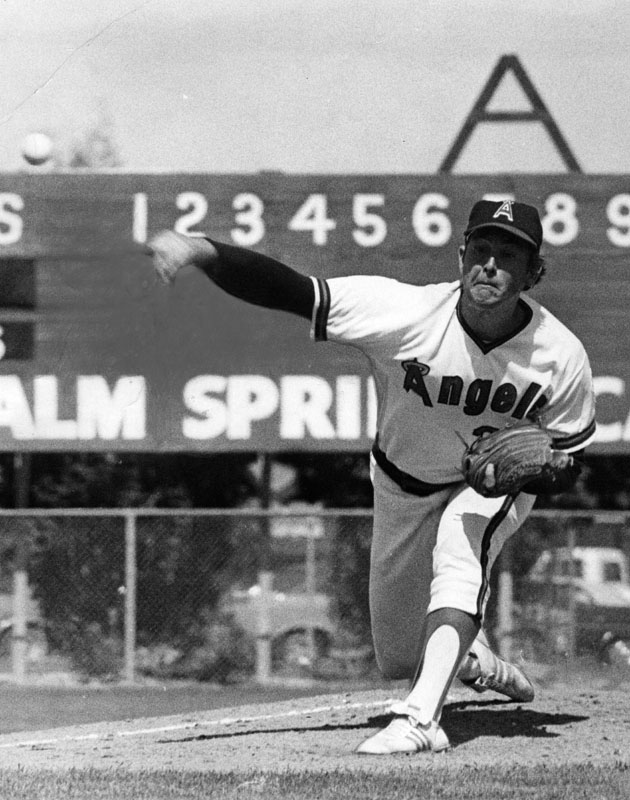 |
|
| (1970s)* - Pitcher Nolan Ryan throws a good one off the mound at Angels camp in Palm Springs. Nolan played on the Angels for eight seasons (1972 - 1979). |
Historical Notes In his first season with the Angels, Ryan, given a chance to pitch regularly as a starter for the first time in his career, had a league-leading 329 strikeouts—nearly a third more than the AL runner-up, and to that point, the fourth-highest total of the 20th century. Within five seasons, the season would only be Ryan's fourth-highest strikeout total. He also set a still-standing Major League record by allowing only 5.26 hits per nine innings, breaking Luis Tiant's 5.30 in 1968, as well as posting a 2.28 earned run average that year, to date the second lowest in franchise history, trailing only Dean Chance's 1.65 in 1964. Though Ryan's actual winning percentage hovered only slightly over .500, his strikeouts and no-hitters brought him media attention. |
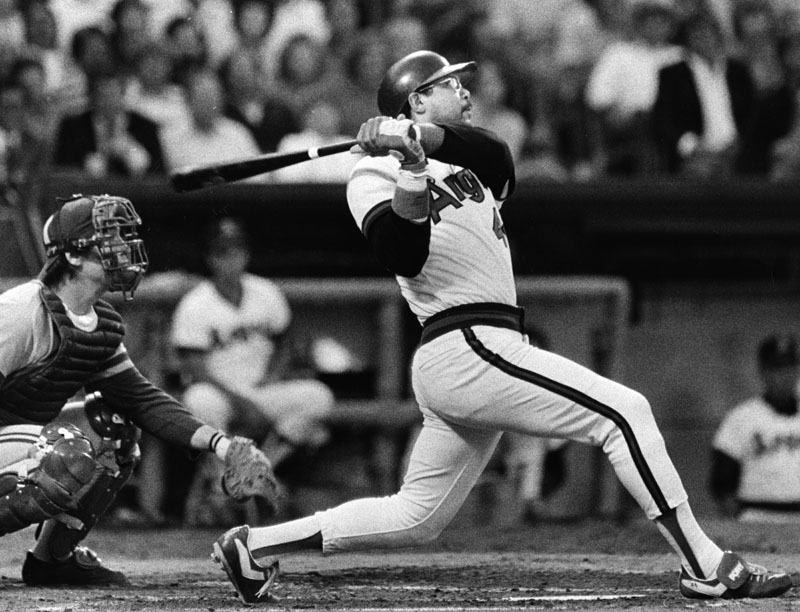 |
|
| (1982)* - This classic Reggie swing produced a classic Reggie home run to dead centerfield. He was a California Angel for 5 seasons (1982 - 1986). |
Historical Notes Reggie Jackson played 21 seasons and reached the post-season in 11 of them, winning six pennants and four World Series. His accomplishments include winning both the regular-season and World Series MVP awards in 1973, hitting 563 career home runs (sixth all-time at the time of his retirement), maintaining a .490 career slugging percentage, being named to 14 All-Star teams, and the dubious distinction of being the all-time leader in strikeouts with 2,597 (he finished with 13 more career strikeouts than hits). Jackson was the first major leaguer to hit one hundred home runs for three different clubs, having hit over 100 for the Athletics, Yankees, and Angels. |
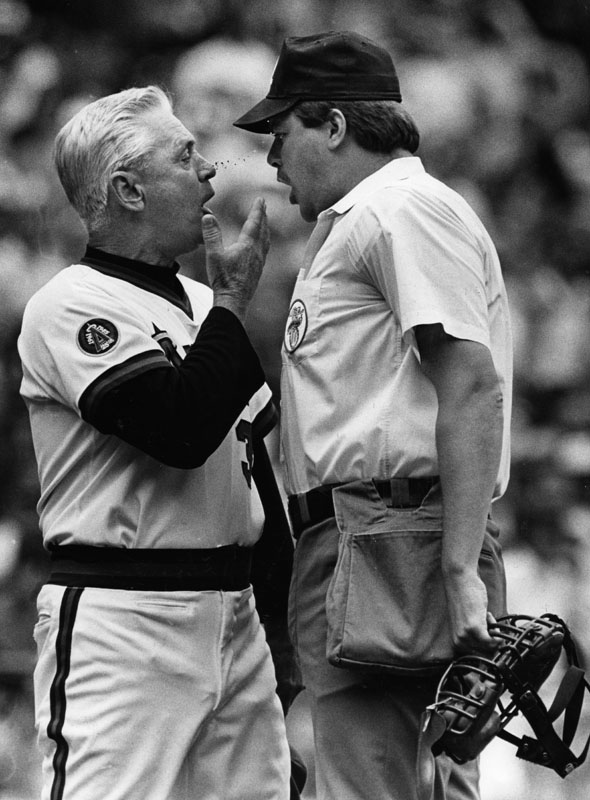 |
|
| (1982)* - Angels manager Gene Mauch (left) was ejected in the top of the first inning after questioning home plate umpire Tim Welke's strike-calling. |
Historical Notes Gene Mauch played in Major League Baseball as a second baseman for the Brooklyn Dodgers (1944, 1948), Pittsburgh Pirates (1947), Chicago Cubs (1948–49), Boston Braves (1950–51), St. Louis Cardinals (1952) and the Boston Red Sox (1956–57). Mauch was best known for managing four teams from 1960 to 1987. He is by far the winningest manager to have never won a league pennant, three times coming within a single victory. He managed the Philadelphia Phillies (1960-68), Montreal Expos (1969–75, Mauch was their inaugural manager), Minnesota Twins (1976–80), and California Angels (1981–82, 1985–87). His 1,902 career victories ranked 8th in major league history when he retired, and his 3,942 total games ranked 4th. He gained a reputation for playing a distinctive "small ball" style, which emphasized defense, speed and base-to-base tactics on offense rather than power hitting. Mauch gained a reputation for being loyal to his players and became known as the Little General. |
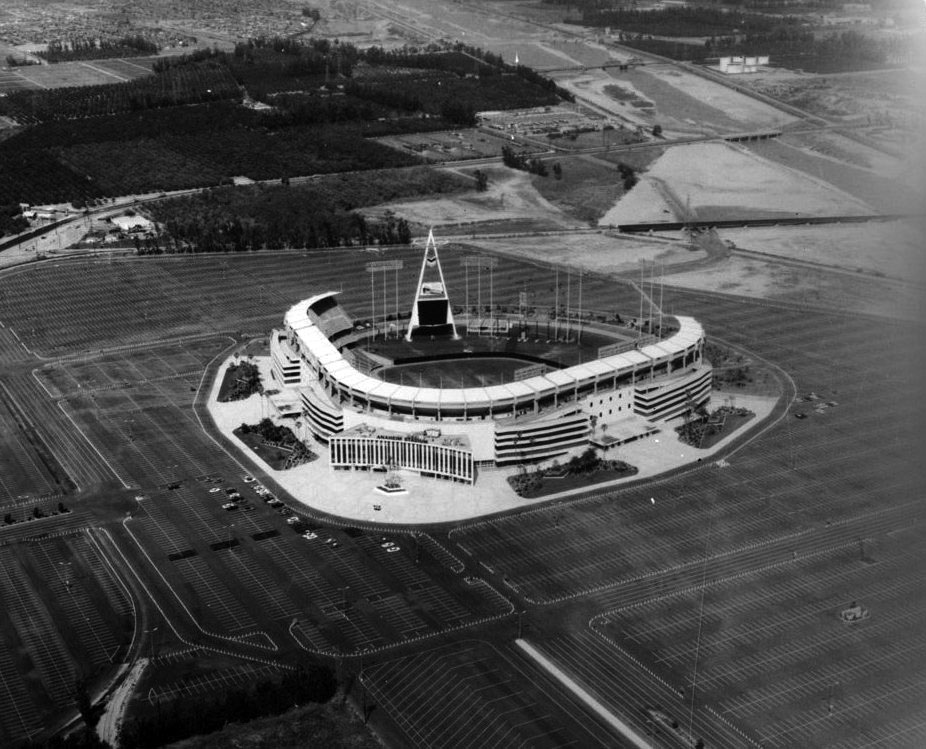 |
|
| (1968)^ - Aerial view of Anaheim Stadium. The parking lot looks empty except for a few cars near the stadium entrances. |
Historical Notes The original Anaheim Stadium seated 43,204 (later 43,250). The stadium underwent construction in 1979-80 for additional seating to accommodate the Los Angeles Rams of the NFL. Upon completion in 1981, the stadium seated 65,158 (later 64,593) for baseball. The Rams left Anaheim for St. Louis, MO in 1995. The new Angel Stadium of Anaheim has a seating capacity of approximately 45,050 for the Los Angeles Angels. |
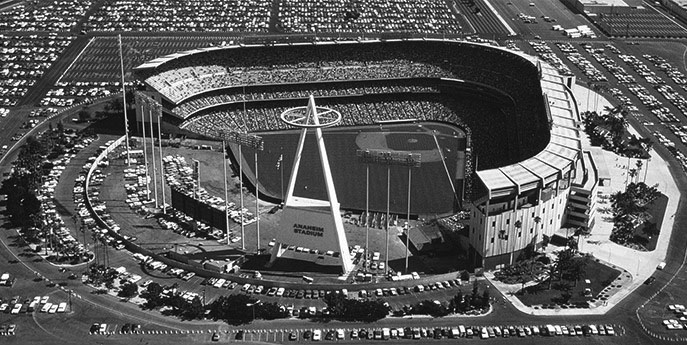 |
|
| (1970s)^ – Aerial view of Anaheim Stadium before it was totally enclosed. Photo Courtesy of Angels Baseball |
Historical Notes In the late 1970s, Anaheim Stadium tried to earn extra revenue any way it could. It staged more rock concerts, motocross events and brought in new (and briefly) successful tenants in soccer’s California Surf and the Southern California Sun of the short-lived World Football League. But just as they had wooed an unhappy Angels franchise out of Dodger Stadium 15 years earlier, local politicians were now sniffing out another disgruntled tenant in 1978 when they heard that the NFL’s Los Angeles Rams were looking to upgrade from their current situation at the ancient Los Angeles Memorial Coliseum. Anaheim and Orange County were hardly clandestine in their efforts to woo the Rams, even placing a full-page pitch to them in the Los Angeles Times. The ballpark would do more than just add 20,000 makeshift seats in right field, as had been planned for the Chargers back in 1966; this time the idea was to turn Anaheim Stadium into a fully enclosed, multi-purpose facility, tucking into the back of the second level 107 brand new luxury suites—all for the Rams to own and profit from. Like Gene Autry before him, Rams owner Carroll Rosenbloom was happily on board with the concept and told Anaheim he’d be theirs. Autry and the Angels were fine with the ambitious $33 million project to enclose and expand Anaheim Stadium to 67,000 seats, even if it meant wrecking the baseball ambience. Just to be sure there was no ill will, the Rams played nice and offered to buy Angels season tickets for every row that butted up against the front of the new luxury boxes. But when Autry discovered that the expansion pact also called for a high-rise business complex to be built for the Rams on part of the existing parking lot, smiles became snarls. The Angels sued Anaheim, triggering a 12-year battle in which the Angels, the Rams and the City of Anaheim all took turns suing one another over control of the parking lot. Finally, in 1994, it was ruled that the lots belonged to the city but needed to be fully used by the Angels, negating any chance for development. |
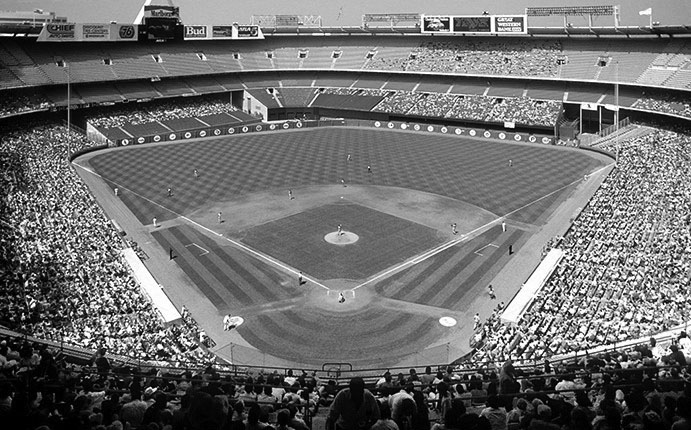 |
|
| (1980s)^ - Anaheim Stadium after being enclosed to accommodate football. The field dimensions were kept symmetrical in front of a purely asymmetrical bleacher setup. Photo Courtesy of Angels Baseball |
Historical Notes The Big A scoreboard was moved to the south end of the parking lot when Anaheim Stadium was enclosed in 1980. Talk of bringing it back during the ballpark’s second makeover ended when it was determined it would be too costly to do so. In 1998, the stadium was renamed Edison International Field of Anaheim after local utility Edison International reached a deal giving it naming rights over the stadium for 20 years, and during this time, the stadium was referred to as the Big Ed. However, after the 2003 season, Edison International exercised its option to exit the sponsorship deal. On December 29, 2003, the Angels announced that from then on the stadium would be known as Angel Stadium (in full, Angel Stadium of Anaheim), some locals can still be caught calling the venue by its original name; Anaheim Stadium as well. After the name change in 2004, its original nickname The Big A was restored. Despite efforts to cover them up with the Angels' halo insignia, Edison's insignia can still be found on the ends of seating rows throughout the ballpark. |
* * * * * |
More Historical Early Views
Newest Additions
Early LA Buildings and City Views
History of Water and Electricity in Los Angeles
* * * * * |
References and Credits
* LA Public Library Image Archive
^* Library of Congress: Washington Park
^^ Rule 19 Blog - Vernon Tigers
++CulturaPolitics: White Sox Park
#* Facebook: Photos of Los Angeles
^^ Hometown Pasadena - Brookside Park & the Chicago White Sox
^# Nuestra Señora la Reina de los Ángeles: losangelespast.com
## NY Times: Chicago Cubs in Catalina
*^^LA Times: Framework: Wrigely Field, 1937; Frenchy Uhalt; Dodgers Caravan,1958; Dodger Stadium
^^^KCET: When the Los Angeles Angels Flew to Anaheim; History of Baseball Stadiums
**^Vintage Los Angeles: Facebook.com
^**Hidden Los Angeles - Facebook.com: Sandy Koufax
#**Classic Hollywood/LA/SFV - Facebook.com
#^^100 Years of Scoreboard Watching
^*^Anaheim Public Library Image Library
^*#California State Library Image Archive
*#*Pinterest.com: Memories in the SFV, 60's, 70's, & 80's
^#^Calisphere: University of California Image Archive
*#^Gizmodo.com: How 19 Earthmovers Carved Dodger Stadium
**#Sports-Venues.info: Anaheim Stadium
^^#Huntington Library Image Archive
^^*Skyscraperpage.com: Coliseum Opening Day; Wrigley Field Opening Day; Team Photo; Chutes Park; Gilmore Aerial; CBS Television City
****Pamona Public Library’s Frasher Foto Postcard Collection
*^*^South Bay Daily Breeze: Spring Training with the Cubs on Catalina
^*^*Flickr.com: Michael Ryerson
*^^^Vintage Everyday
^**^Catalina Island Scrapbook: voncoelln.com
*^ Wikipedia: Dodger Stadium; Angels Stadium; Nolan Ryan; Reggie Jackson; Los Angeles Angels (PCL); Los Angeles Angels of Anaheim; Gilmore Field; Chutes Park; Gene Mauch; Hollywood Stars; Bill Russell; Davey Lopes; Tommy Lasorda; L.A. Dodgers - 1959 Season; Walter Alston; Sandy Koufax; Johnny Podres; William Wrigley, Jr.; Santa Catalina Island; Tommy Lasorda; Vince Scully
< Back
Menu
- Home
- Mission
- Museum
- Major Efforts
- Recent Newsletters
- Historical Op Ed Pieces
- Board Officers and Directors
- Mulholland/McCarthy Service Awards
- Positions on Owens Valley and the City of Los Angeles Issues
- Legislative Positions on
Water Issues
- Legislative Positions on
Energy Issues
- Membership
- Contact Us
- Search Index